
Admin
-
Posts
7,477 -
Joined
-
Last visited
Content Type
Profiles
Forums
Events
Store
Gallery
Community Map
Posts posted by Admin
-
-
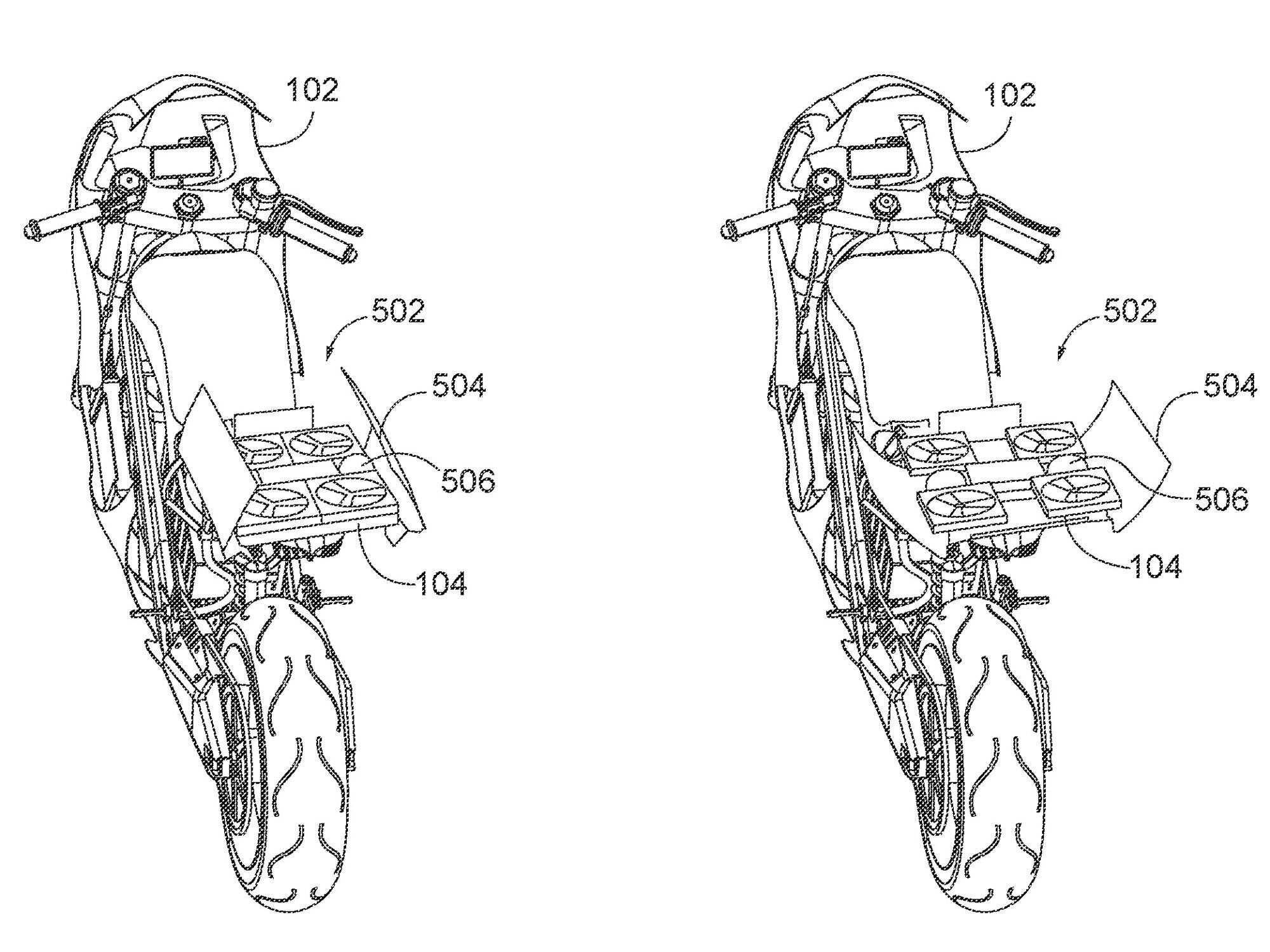
In the future, your brand-new Honda motorcycle may come complete with its own built-in drone. (Honda/)Drones are fast becoming indispensable in modern life, whether as a cheap way to make stunning videos or as a future delivery system for essential supplies. But you’ve probably never considered having one built into your bike.
Honda has. Its R&D department has filed a patent application for a motorcycle-mounted drone, though it’s clearly a very long-distance vision of the future rather than something that’s just around the corner. The new patent document describes a drone with four rotors that sits in a housing in the extended tail of a motorcycle. The idea is that it’s a completely autonomous flying machine that can be released on command and return automatically to the bike when needing a recharge.
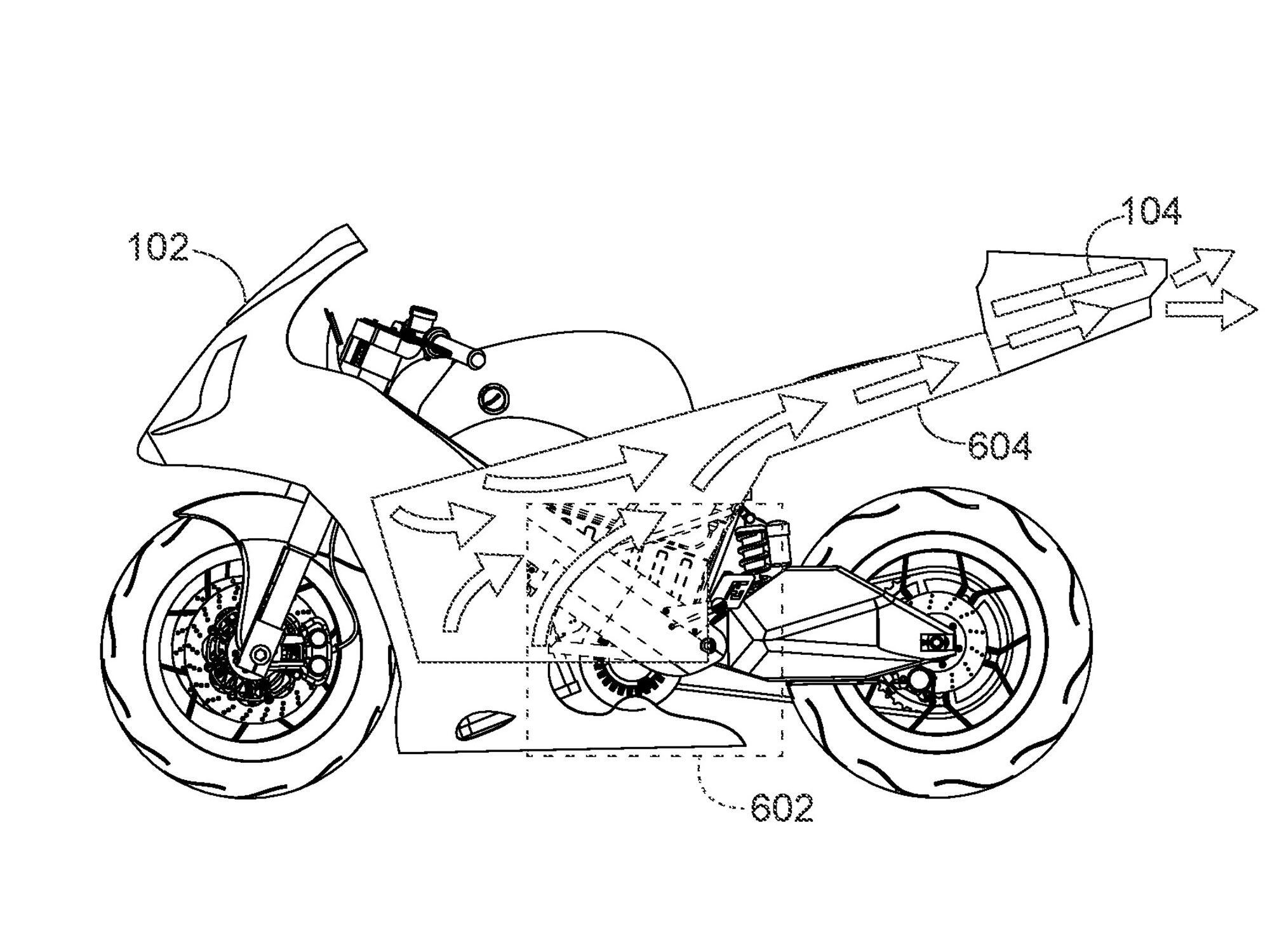
According to the patent, the drone will be housed in the motorcycle’s tail. (Honda/)If you’re asking why you’d need such a thing, you’re not alone. Even Honda’s own patent is a bit vague on the subject, listing a host of possible uses without focusing on a single main benefit.
Among the potential purposes of the drone, Honda suggests it could be used to deliver fully charged battery packs to an electric motorcycle—solving the range problem of electric bikes—though there’s no clear mechanism for actually swapping the packs, and given current technology it’s impossible to imagine a quadcopter that’s both small enough to fit on a bike and big enough to carry a battery able to propel the same bike.
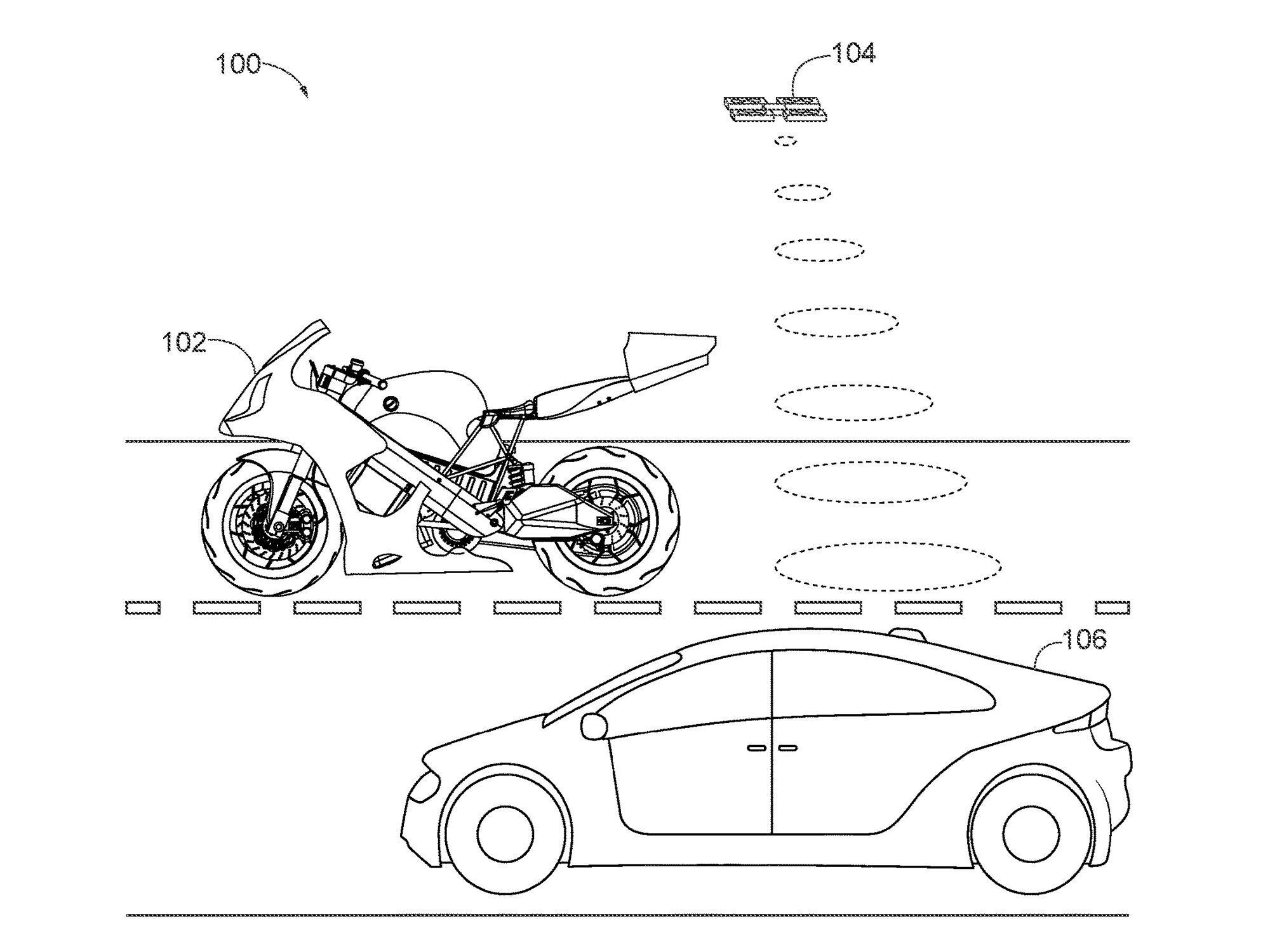
One of its uses could be as a traffic-monitoring, eye-in-the-sky system that could feed info on conditions back to the rider. (Honda/)A more realistic suggestion is that the drone could work as part of a traffic monitoring system, watching the road ahead and feeding information back to the bike’s rider to warn of problems before they come into view at ground level. The drone is also suggested as a sort of communications relay, extending the range of systems on the bike itself or alerting emergency services in the event of an accident, and Honda even says that while docked it could be incorporated into the bike’s cooling system, using the rotors as fans to suck air past a radiator.
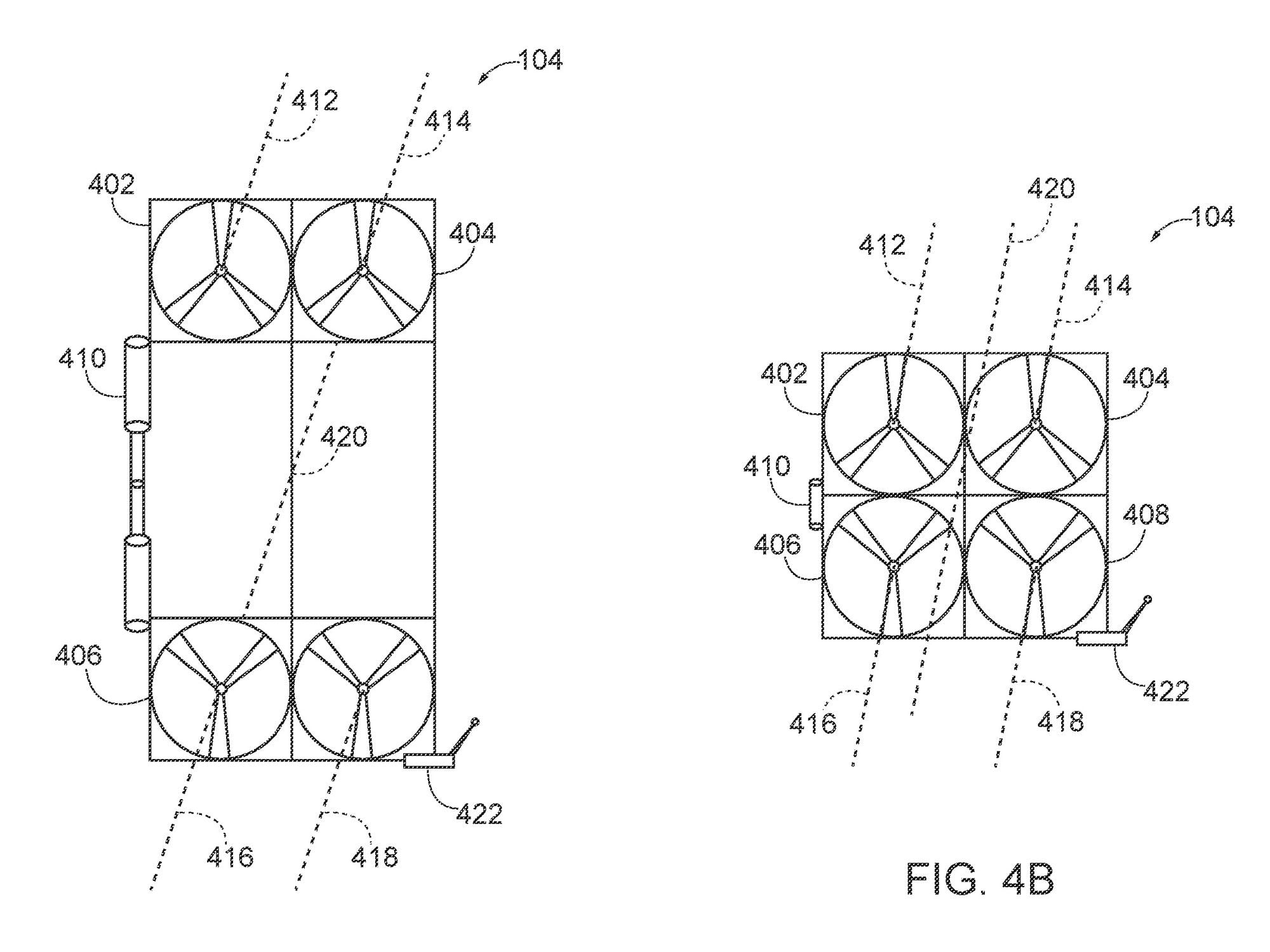
The quadcopter-styled drone looks to have movable rotors to allow for a compact footprint aboard the bike. (Honda/)Given that drones, communications systems, and motorcycles are all well-established technologies, you might be wondering what Honda is actually trying to patent. It seems that the main technical novelty on the bike-mounted drone is a system to move the rotors, making the quadcopter compact enough to fit into a housing on a motorcycle but also allowing the rotors to spread further apart once it’s released, making a bigger, more stable drone.
It’s also worth noting that Honda’s patent clearly shows the drone fitted to an electric sportbike. While we can’t infer too much from the rather simplistic drawings, of all the machines Honda could have shown the drone with, the firm has chosen one of the most tempting—particularly taking into account teases like the stunning RC-E concept bike from 2011 and the long-standing Mugen efforts at the TT Zero, which were widely seen as a Honda-backed electric bike development project.
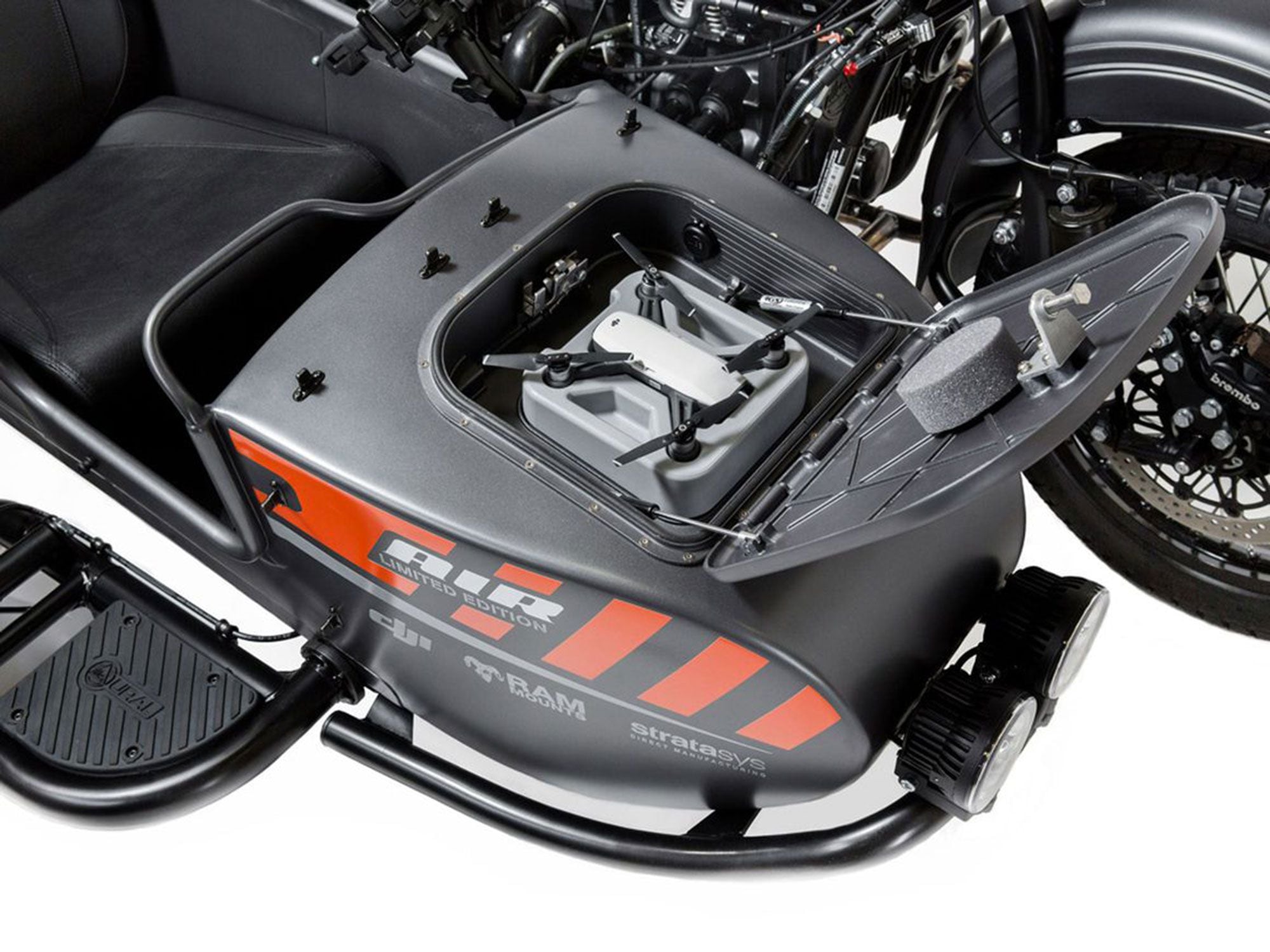
Honda isn’t the first manufacturer to toy with a moto-mounted drone—the limited-edition Ural Air LE sidecar featured DJI’s Spark unit in 2018. (Ural/)Of course, this isn’t the first time that bikes and drones have been put together. Honda was beaten to the punch by none other than Ural, which created a sidecar with a built-in DJI Spark quadcopter back in 2018. Like Honda’s patent, the Ural design suggested the drone could be used as a scout, checking out what lies ahead before it’s in the rider’s sightline. Unlike the Honda, the Ural was a complete machine, but the drone wasn’t fully automated—the passenger operated it from the sidecar, using a display on his remote control to see the drone’s eye view ahead.
-
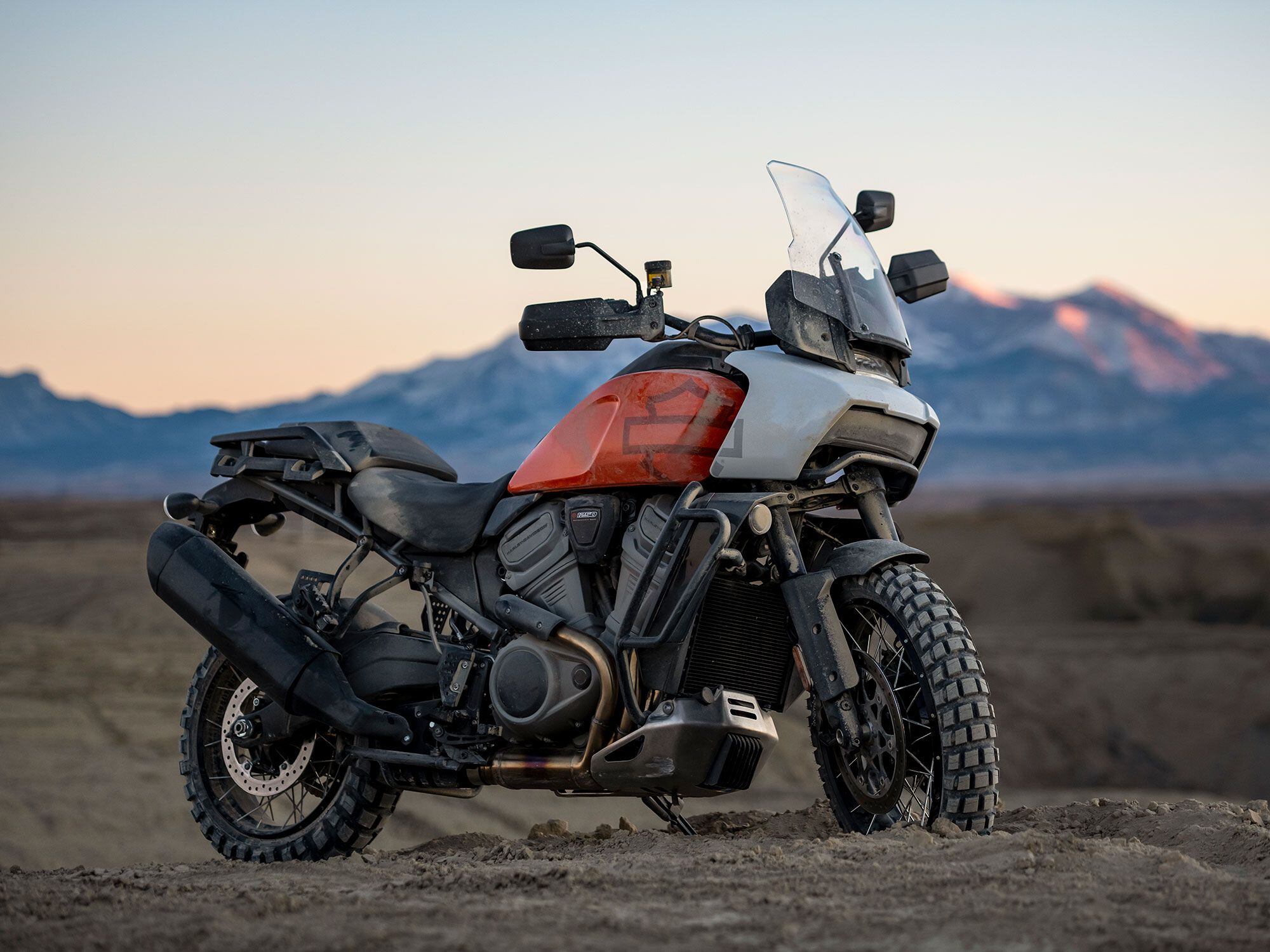
Harley-Davidson’s Pan America 1250 is claimed to have 150 hp. (Harley-Davidson/)We’ve eyed the teaser shots of the Pan America 1250, and we’ve speculated as to what it is planned to accomplish. Now the lid is off, the 1250 adventure-tour bike’s specs are published, and the obviously proud and pleased engineers are talking about their work.
The base-model Pan America will have an MSRP of $17,319, and the Pan America 1250 Special (with skidplate, centerstand, brush guards and other additional features) is $19,999. We are focusing on the Special because it is the technical top of the line by being equipped with semi-active suspension, and can be equipped with Adaptive Ride Height control.
The 1250 is a huge leap for Harley-Davidson, setting its engineering department free to do what few engineers have the privilege of doing: designing an all-new bike from the ground up. Harley’s traditional products have made steady advances in sophistication over the years, but that work had to fit within the classic 1936 silhouette.
Now, in a single platform, Harley has produced a liquid-cooled, DOHC, 60-degree V-twin “international” engine with variable valve timing (VVT). Rated at 150 hp at 9,000 rpm, it is carried in a stressed-engine hybrid chassis with a MIG-welded HSLA steel-trellis front frame, forged aluminum mid-frame, and one-piece cast aluminum swingarm. Clutch, alternator, and cam covers are magnesium, only two-thirds the weight of aluminum. The 5.6-gallon fuel tank is aluminum.
Cycle World Editor-in-Chief Mark Hoyer and I were given an hour of video conversation with five of H-D’s engineers and Paul James, senior manager of PR who has also spent years working in product planning.
Chief Engineer Alex “Boz” Bozmoski said, “We looked at adventure-tour as a natural fit for us. What basic characteristics would we need? For off-road, responsive low-end torque for low-speed maneuvering. But for road, it’s high-end performance you need. In making each design choice, we asked ourselves, ‘How do we win?’ The obvious answer here was VVT, and not the simple two-position kind. We needed map-controlled, continuously variable cam timing.”
Driving cars with VVT cam phasers demonstrates the strong torque VVT provides at lower revs, <i>without</i> torque fade farther up the rpm scale. The 1250′s cam phasers are hydraulic and controlled by solenoid plungers. At rest, the intake cams default to full retard while the exhaust cams go to full advance, the positions of minimum valve overlap and strong bottom torque.
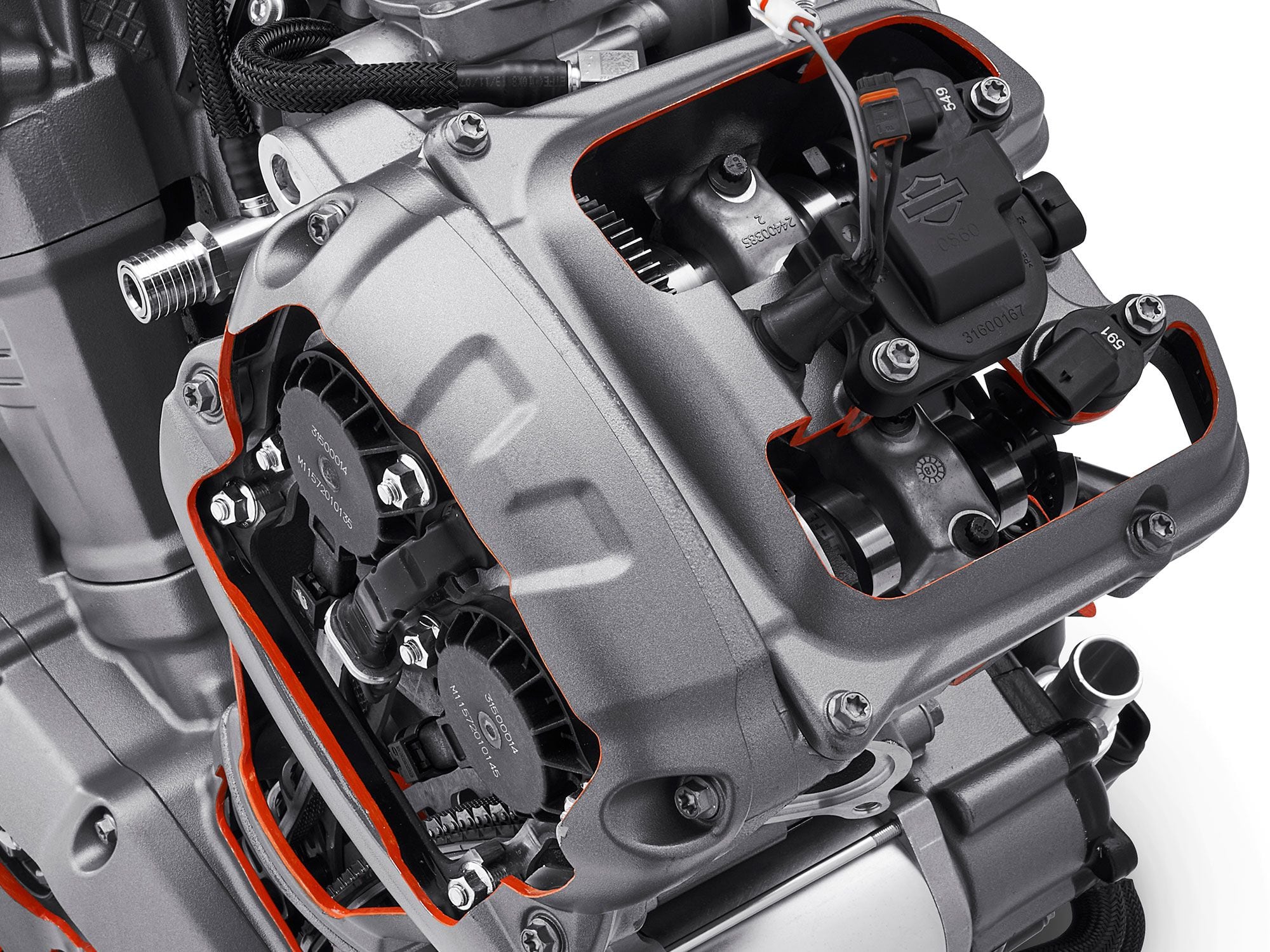
Hydraulic cam phasers actuated by solenoid plungers control the Pan America’s VVT cam timing. (Harley-Davidson/)Boz said, “As a function of VVT, we have a super-broad powerband. People who ride KTM and BMW have said it <i>feels</i> more powerful than the competition.”
One feature best characterizes the liberated thinking behind this bike: its Adaptive Ride Height system (a $1000 option only available on the Special), a first for any production motorcycle. To accommodate the 1250′s longer-travel (7.5 inches, front and rear) suspension without making the bike uncomfortably tall for some riders, an on-board system senses when the bike is being braked to a stop and smoothly reduces ride height by 1 to 2 inches, depending on suspension settings. That height is maintained until the bike is ridden away, when the normal seat height of 31.8 inches is smoothly restored. This system can be locked out by the rider.
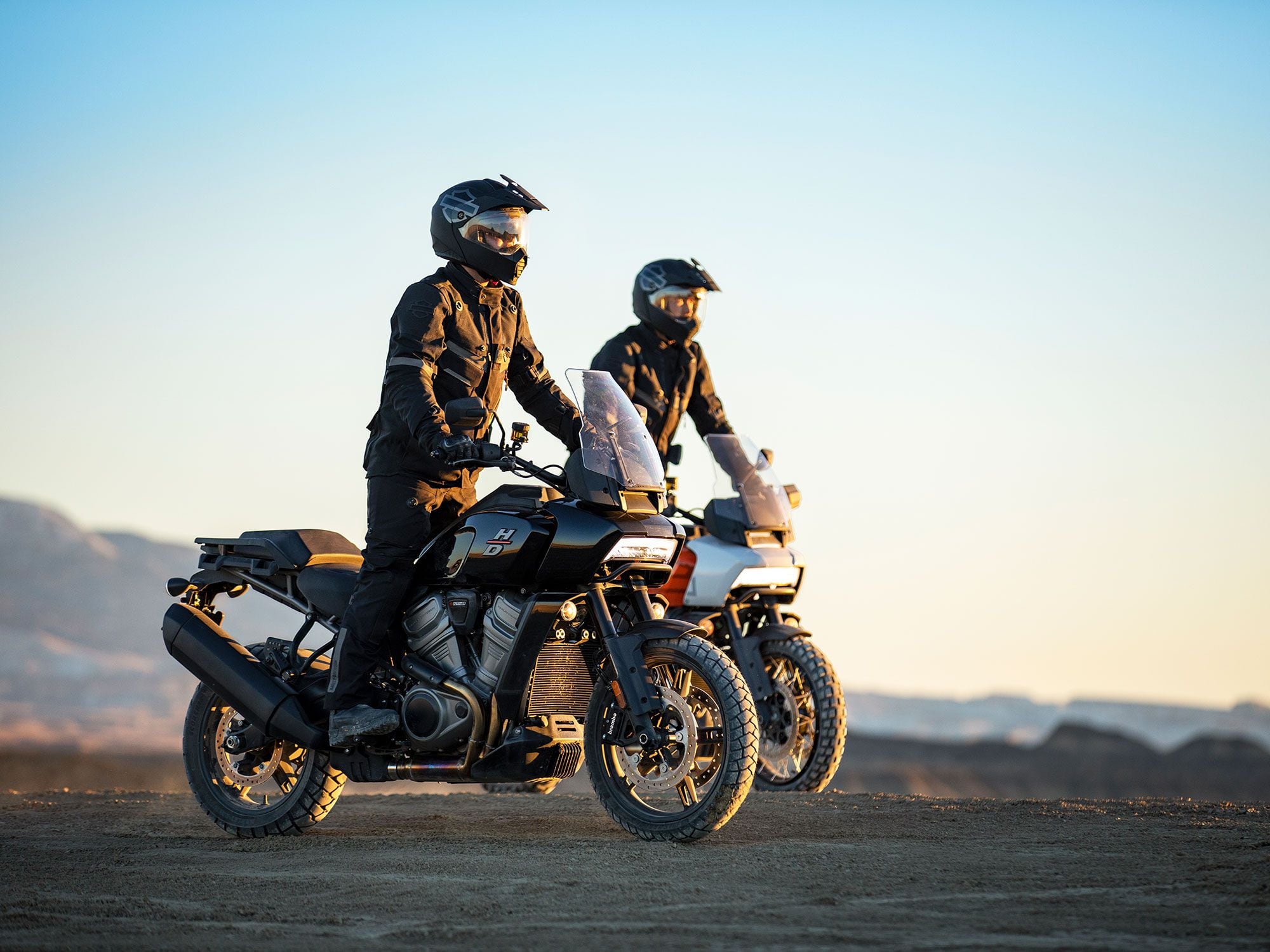
The Pan America 1250 is claimed to tip the scales at 503 pounds, as shipped. Seems Executive Editor Justin Dawes might owe the engineering team a pizza party. (Harley-Davidson/)This motorcycle also brings Harley-Davidson fully up to date in terms of electronic systems. All the electronic conveniences modern motorcyclists expect to find are present; five ride modes, cruise control, phone connectivity, hill hold, ABS, traction control, moving-map nav display, and cornering-enhanced function through the usual IMU.
I asked if we can now regard such systems as generic plug-ins from the usual manufacturers. No, I was told, definitely not. Chassis and Suspension Engineering Systems Manager Bjorn Christensen said suspension-related software was written in-house through testing, discussion, and trial of alternatives. The result, he said with obvious pride, is tailored, seamless operation. Melissa McTavish, manager of engineering systems, infotainment & connectivity, noted that the large configurable touchscreen dash is designed to be operable while wearing gloves.
Bozmoski said, “We got two basic responses from people given long rides on this bike. One, ‘Do I have to give it back?’ and two, that they found themselves riding more confidently.” Others called it the most comfortable bike they’d ridden. Our testers look forward to experience the bike and comparing it with the competition.
The 1250 engine breaks Harley’s long-stroke tradition with its oversquare 1.46 ratio of bore to stroke. The large 105mm bore provides room for four large valves (the exhausts are internally sodium-cooled) that supply the air needed to make power at 9,000 rpm. Peak torque of 94 pound-feet comes at 6,750, but in engines with this kind of wide, flat torque, this is misleading: This peak is not a spike, but merely the highest point on a nearly flat line.
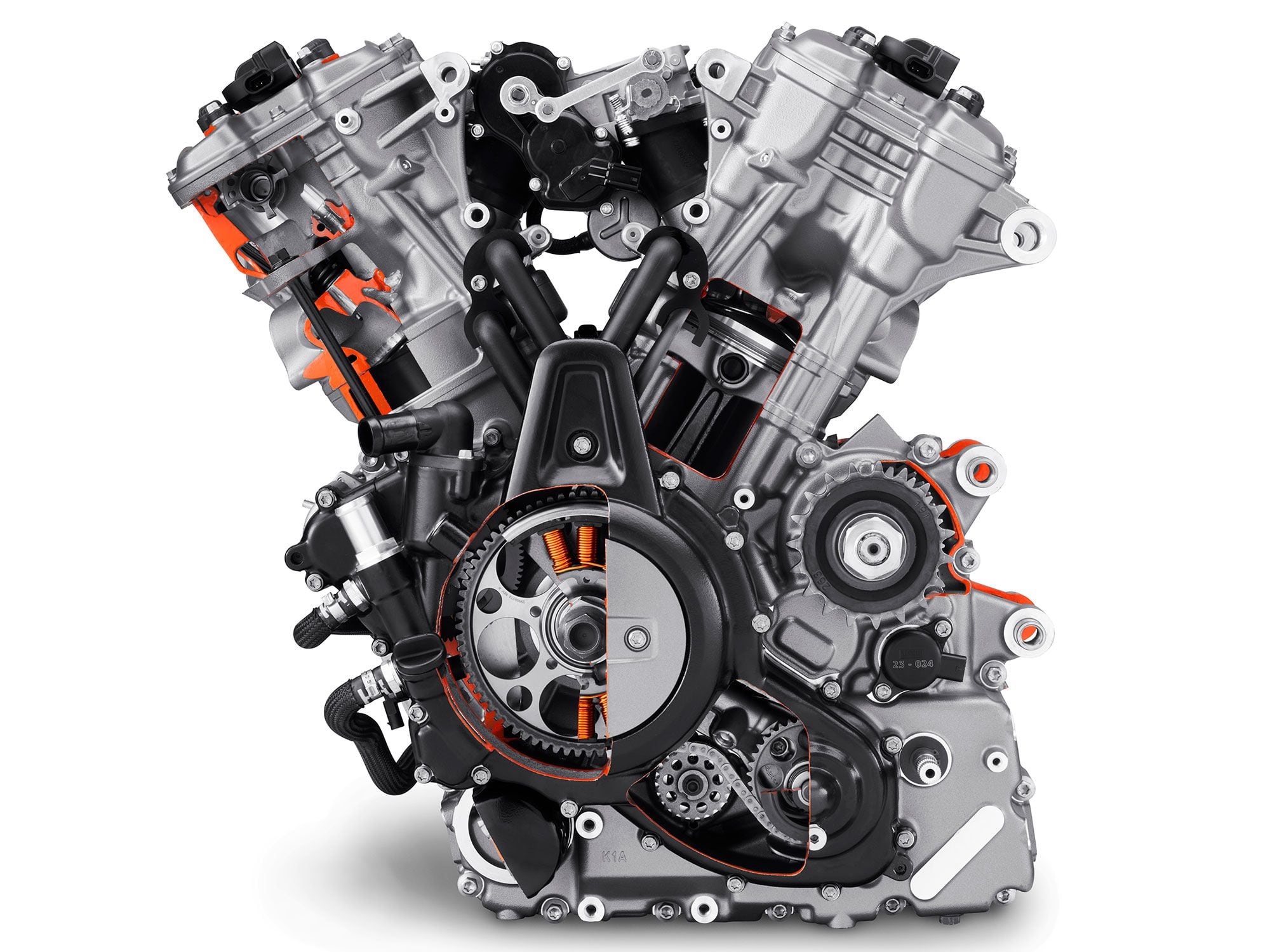
The 1252cc Revolution Max engine produces a claimed 94 pound-feet of peak torque and 150 horsepower. (Harley-Davidson/)The 1250′s crankshaft has two crankpins, staggered at 30 degrees to each other. This reduces primary shaking force and spaces top dead center of the two cylinders (the rear is offset to the left) 90 degrees apart. A primary balance shaft deals with both shaking and rocking. A secondary balance shaft is located between the cams of the front cylinder, geared to one of the cam phasers. This shaft therefore gives a different vibration at idle, making the engine feel “alive,” but runs smoother at freeway speeds. Balance shafts save weight, for without them bikes would need heftier structure just to survive their own vibration.
Why not balance everything to zero? Michael Carlin, Chief Engineer Powertrain, said, “In Milwaukee-Eight we intentionally kept some vibration, because otherwise it doesn’t feel right.”
Cylinders are separate, with weight-saving Nikasil hard-plating instead of iron liners. Why not integrate the cylinders into the case, as some other makers do? It wouldn’t be a Harley if there were no way to boost displacement! Each cylinder head has dual ignition. Generally, twin plugs improve idle quality, reduce emissions, and allow higher compression.
The foundation of engine reliability is its oil system. To make centrifugal force boost oil pressure rather than weaken it, they chose the best: Formula 1-style oil feed into the end of the Revolution Max 1250′s crank rather than traditional feed through the main bearings. There are three scavenge pumps: one for the crank chamber; one for the clutch case, where there’s a baffle to keep oil off the spinning clutch; and one for the alternator cavity. Scavenge capacity is enough to pull a significant vacuum on the crankcase, allowing use of friction-reducing low-tension piston rings, a concept from NASCAR. These are examples of the attention given to cutting parasitic losses in this engine. Rotating parts are high above the wet sump oil level, preventing them from creating an oil storm and losing energy that should be going to the rear wheel. A measure of success here is the claimed 48 mpg city/highway fuel mileage.
Weight control is essential to a big-engined bike like this, dictating the magnesium engine covers, aluminum fuel tank, and aluminum swingarm and mid-frame. Shipping weight is claimed to be 503 pounds, running weight 534.
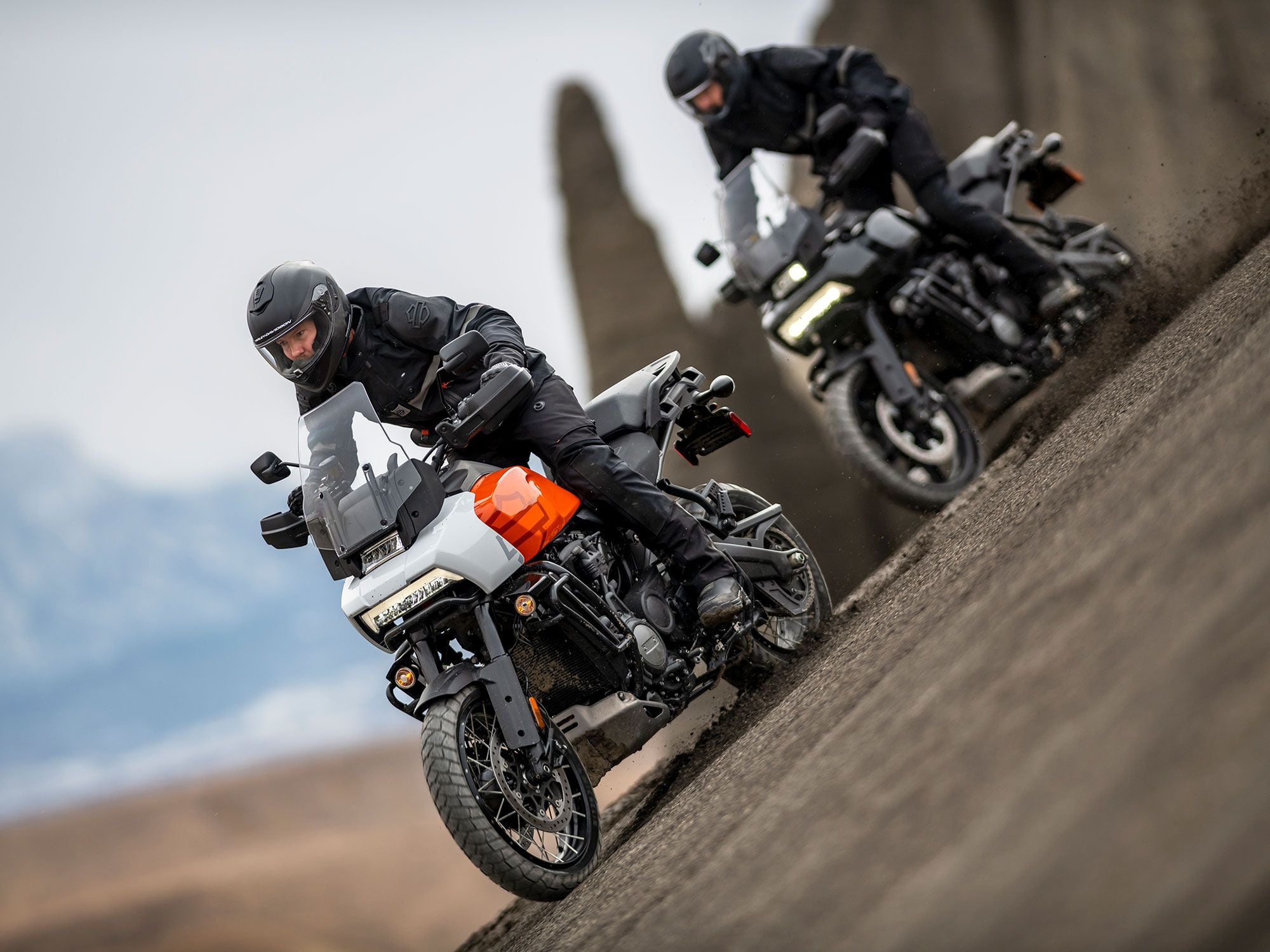
An aluminum tank, swingarm, and frame sections along with magnesium engine covers are among weight saving measures in the Pan America. (Harley-Davidson/)Because this is a Harley-Davidson, it cannot have valve noise or require valve adjustments (service interval is 5,000 miles). Therefore its roller finger cam followers have hydraulic clearance adjusters. Cams are chain-driven.
To accurately set compression ratio at 13.0:1, the crowns of the pistons are fully machined. Compression is the path to high torque! Recommended fuel is 91 (R+M)/2, but thanks to its knock detection/ignition retard system, the engine can run safely on lower octane fuel at some sacrifice of power. There are piston cooling oil jets in the crankcase, aimed up at the undersides of the piston crowns.
Thanks to its vertically stacked gearbox, tucked under the rear cylinder, this engine is extremely short. The high location of the output sprocket testifies to lowest-possible positioning of the engine (“Moving weight south,” Bozmoski calls it) to ease low-speed maneuvering.
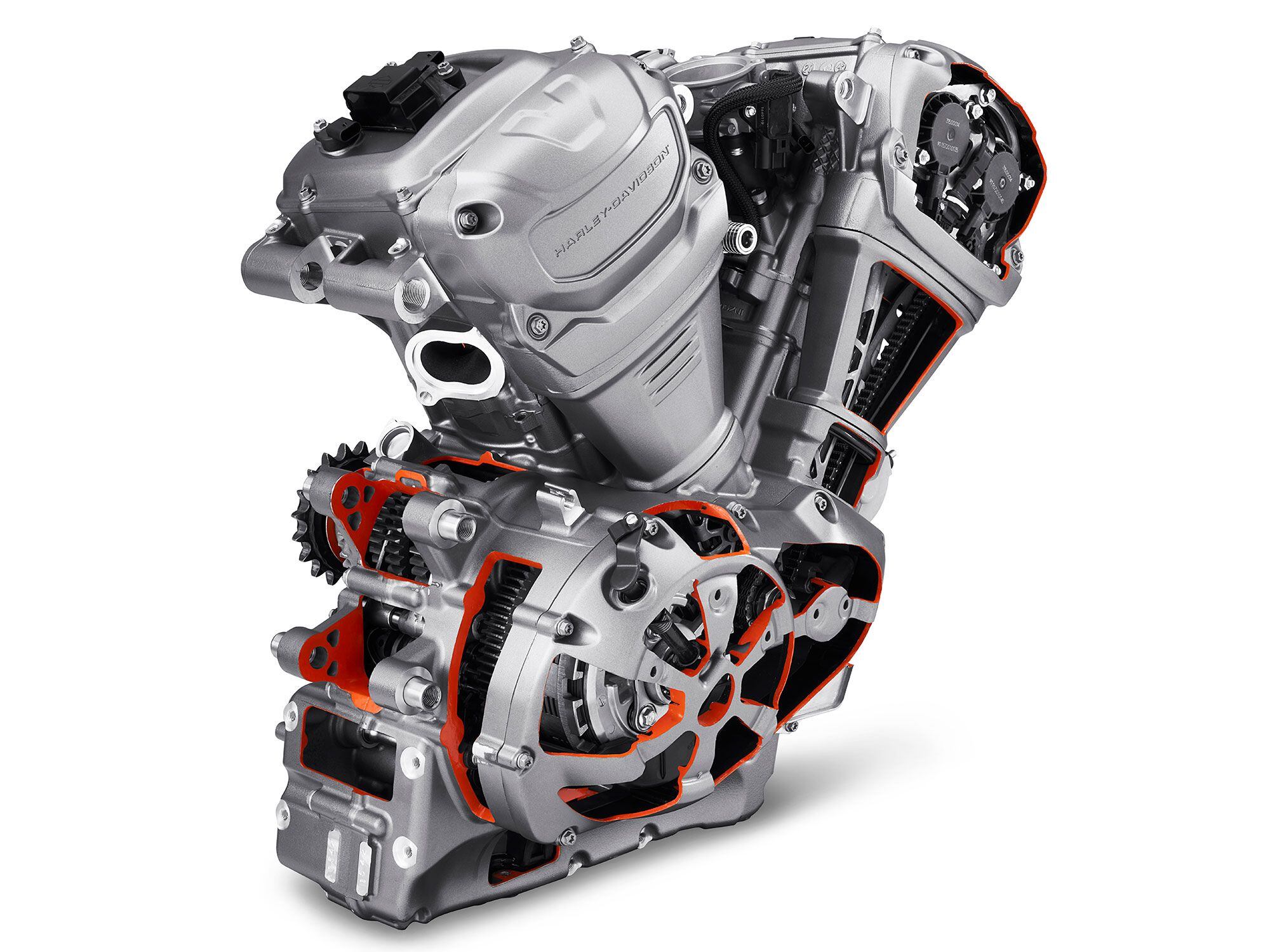
H-D’s engineers achieved a short engine front to back by vertically stacking the transmission shafts. (Harley-Davidson/)The crankshaft drives the six-speed gearbox through a noise-reducing scissors primary gear. Remember Harley’s 1980s message: “We’re killing the noise so we can keep the music.” A slipper/assist clutch with eight friction discs cuts lever effort while preventing engine-braking from hopping or sliding the rear tire on closed throttle. A spring drive in the clutch outer smooths torque delivery.
Mr. Bozmoski described the work leading to the choice of the 62.2-inch wheelbase. “In our early work we were riding and trying alternatives. A long wheelbase is stable; short is nimble. We think we found the right balance. This is a bike that can go 135 mph with rider and passenger, bags full. Our leading competitors’ bags have a sticker.”
We’ve all seen such stickers, whose wording begins, “Do not exceed…” and goes on to require particular tires, forbid use of certain accessories, or mandate loading conditions.
The Special’s front and rear Showa semi-active suspension offers 7.5 inches of travel. Semi-active defines suspension damping that is continuously ECU-adjusted according to how the bike is being used, via seven monitored variables. The hardware is Showa (for example, the electric rear preload adjuster), but the control software was written by H-D. The 47mm “Balance Free” inverted fork has aluminum crowns and the fork angle and steering head angle are both at 25 degrees of rake, working with 6.2 inches of trail. The piggyback BFRC rear unit controls the swingarm through progressive linkage. Right and left maximum lean angles (by SAE J1168 method) are 42 degrees. Brakes are radial Brembo with dual 320mm front discs and radial Monoblock calipers.
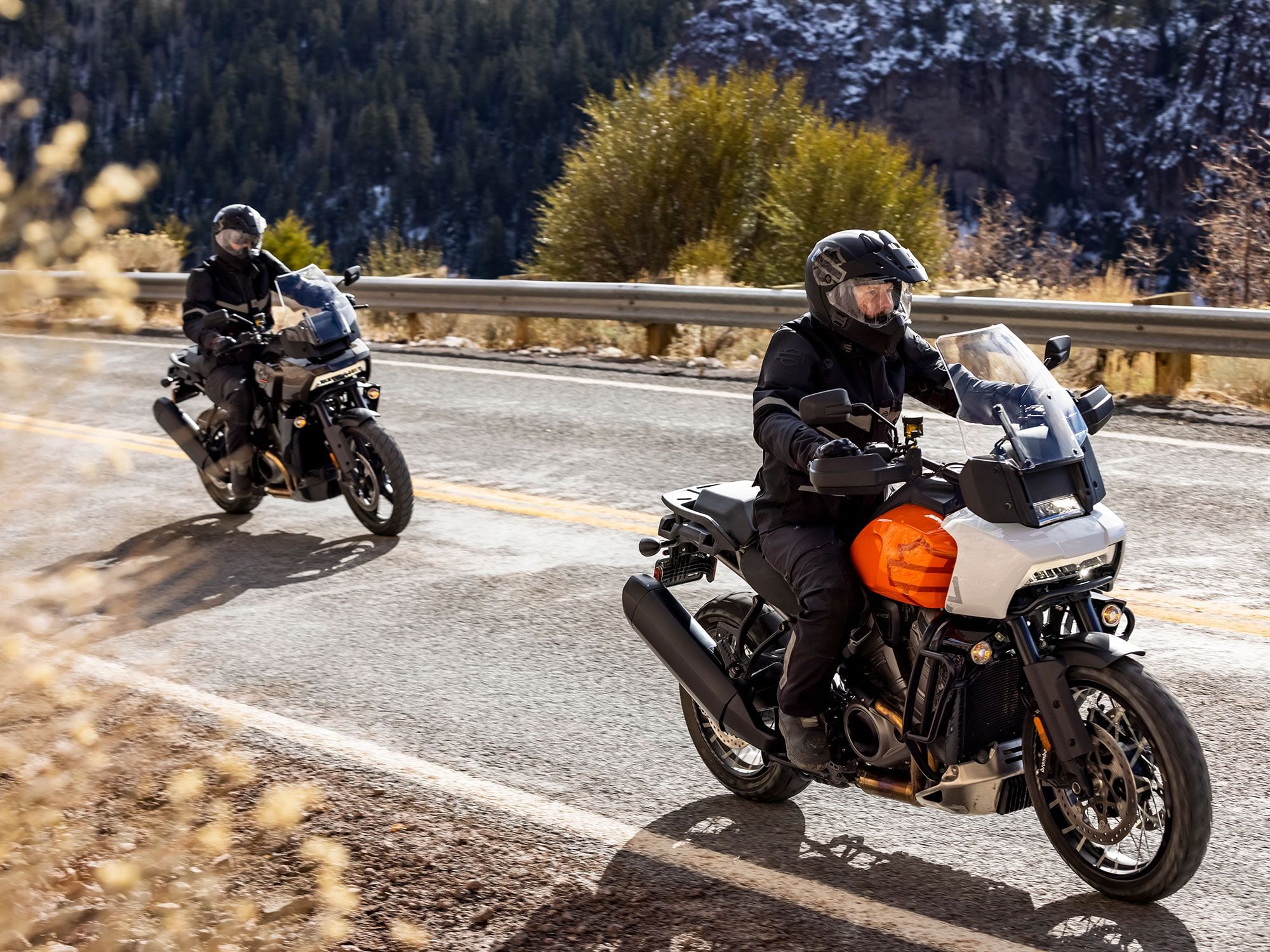
The Pan America 1250 is a huge leap for Harley-Davidson: A clean-sheet adventure-touring motorcycle that is aimed at tackling terrain never before seen by a production model from The Motor Company. (Harley-Davidson/)Think about the riders this bike can attract. Its 7.5 inches of suspension travel in “comfort” mode makes it plusher than the short-travel heavyweights, but its no-fade horsepower wafts it up on-ramps and past grumbling tractor-trailer trains with greater ease than any 120-incher. Adaptive Ride Height delivers confident starting and stopping. And Pan America opens up the backcountry—thousands of miles of the road less traveled to touring riders who thought they’d seen it all. Could it be, as others have proposed before, that adventure-tour is the new standard?
Specifications
2021 Harley-Davidson Pan America 1250 2021 Harley-Davidson Pan America 1250 Special MSRP: $17,319 $19,999 Engine: 1,252 DOHC V-Twin; four valves per cylinder 1,252 DOHC V-Twin; four valves per cylinder Bore x Stroke: 105 X 72mm 105 X 72mm Transmission/Final Drive: 6-Speed / Chain 6-Speed / Chain Claimed Horsepower: 150 hp @ 9,000 rpm 150 hp @ 9,000 rpm Claimed Torque: 94 lb.-ft. @ 6,750 rpm 94 lb.-ft. @ 6,750 rpm Fuel System: Electronic Sequential Port Fuel Injection Electronic Sequential Port Fuel Injection Clutch: Mechanical; 8-plate wet; assist & slip Mechanical; 8-plate wet; assist & slip Frame: Stressed-member alloy steel trellis; forged aluminum mid-structure Stressed-member alloy steel trellis; forged aluminum mid-structure Front Suspension: 47mm Inverted fork; compression, rebound, and preload adjustable, 7.5 in. travel 47mm Inverted fork; electronically adjustable semi-active damping control; optional Adjustable Ride Height; 7.5 in. travel Rear Suspension: Piggyback monshock; compression, rebound, an hydraulic preload adjustable; 7.5 in. travel Piggyback monshock; electronically adjustable semi-active compression and rebound damping control; automatic electronic preload control; optional Adjustable Ride Height; 7.5 in. travel Front Brake: 320mm Dual rotors; 4-piston monoblock calipers; ABS 320mm Dual rotors; 4-piston monoblock calipers; ABS Rear Brake: 280mm Single rotor; single piston caliper; ABS 280mm Single rotor; single piston caliper; ABS Wheels, Front/Rear: 19x3 in. / 17x4.5 in. Cast Aluminum 19x3 in. / 17x4.5 in. cast aluminum standard; anodized aluminum laced tubeless optional Tires, Front/Rear: 120/70R19 / 170/60R17 ; Michelin Scorcher Adventure Radial 120/70R19 / 170/60R17 ; Michelin Scorcher Rake/Trail: 25 Degrees / 6.2 in. 25 Degrees / 6.2 in. Wheelbase: 62.2 in. 62.2 in. Ground Clearance: 8.3 in. 8.3 in. Seat Height: 34.2 in. 34.2 in. Fuel Capacity: 5.6 gal. 5.6 gal. Claimed Wet Weight: 534 lbs. 559 lbs. Availability: May, 2021 May, 2021 Contact: Harley-Davidson Harley-Davidson -
 1
1
-
-
-
-
-
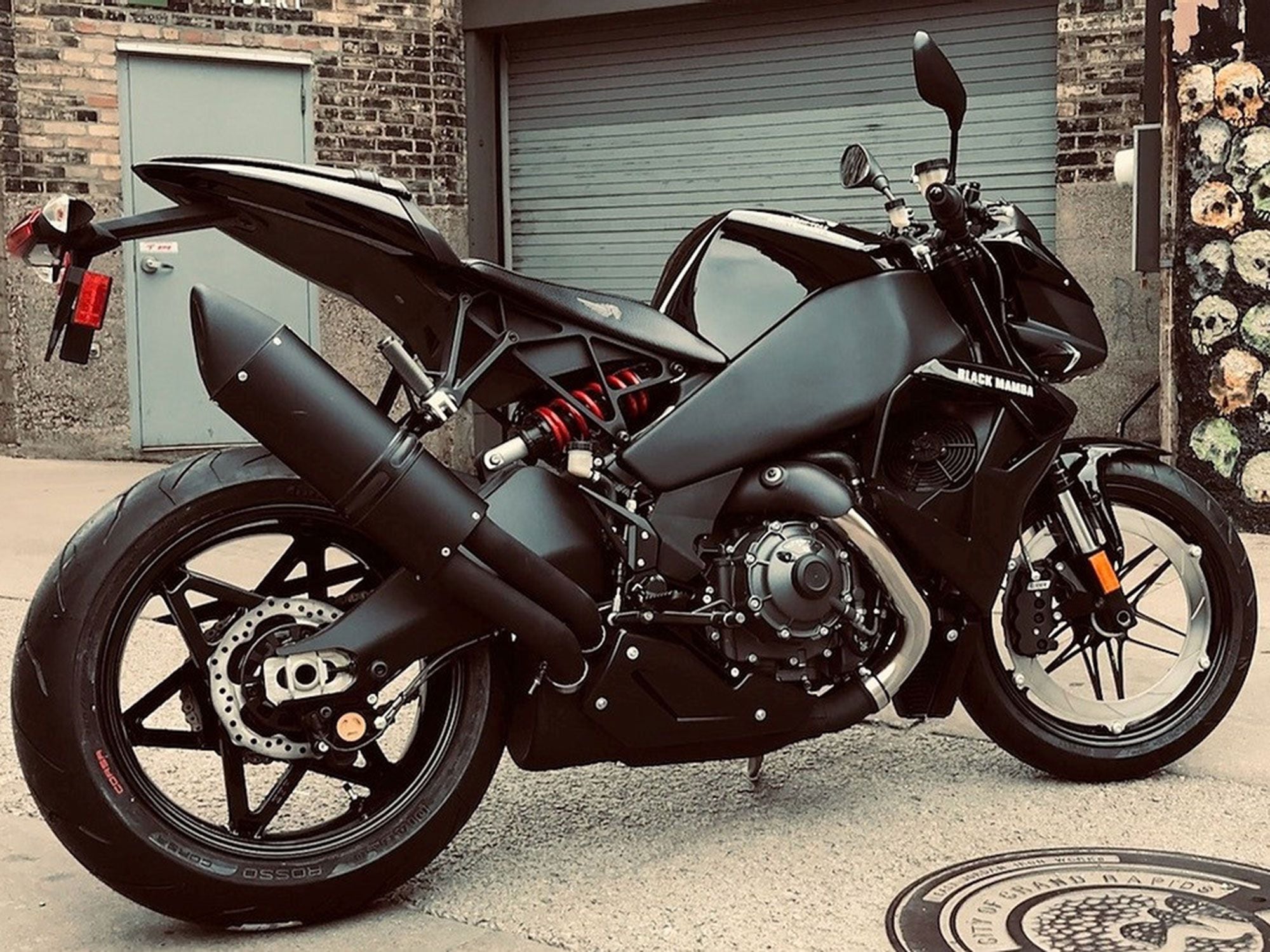
Buell has announced its return to the motorcycle world, and plans to produce 10 models, one being the EBR 1190SX. (Buell Motorcycles/)Nearly a dozen years after then-owner Harley-Davidson pulled the plug on the Buell brand in the wake of the 2008 financial crisis, the firm is making a comeback with big plans for a new model range reaching into every corner of the market. The new incarnation of Buell is a rebrand of EBR Motorcycles, the direct descendant of the original Buell company, with EBR Motorcycles boss Bill Melvin as CEO. The recent surprise announcement that the Buell name was making a comeback was accompanied by an outline plan for 10 new models to be released between now and 2024.
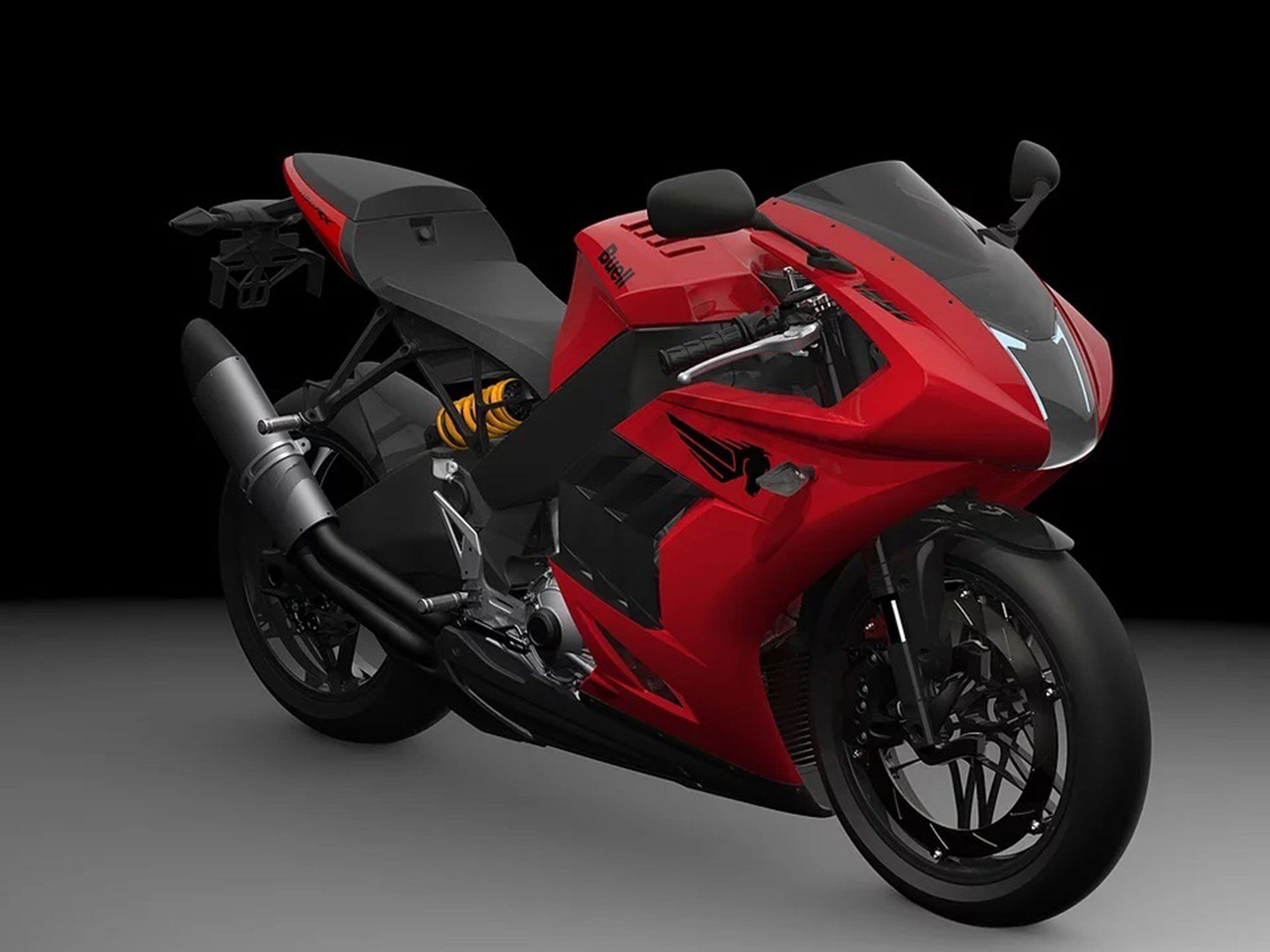
A superbike based on the same EBR 1190RX platform is also said to be in the works. (Buell Motorcycles/)The first models will come in the form of a superbike derived from the EBR 1190RX, as well as a continuation of the naked EBR 1190SX, along with a 185 hp “Super Touring” adventure model based on the 1190SX, said to be joining the range in 2023. That has long been the plan of EBR, which promised an “AX” adventure model as far back as 2014. A fourth model, the 1190 HCR, is a crazy-looking hill climber based on the 1190′s 185 hp V-twin, and has already proved its mettle by winning the 2020 AMA National Pro Hillclimb title. It’s due to be developed into a shorter-wheelbase desert racer—the 1190 Baja—in the near future.
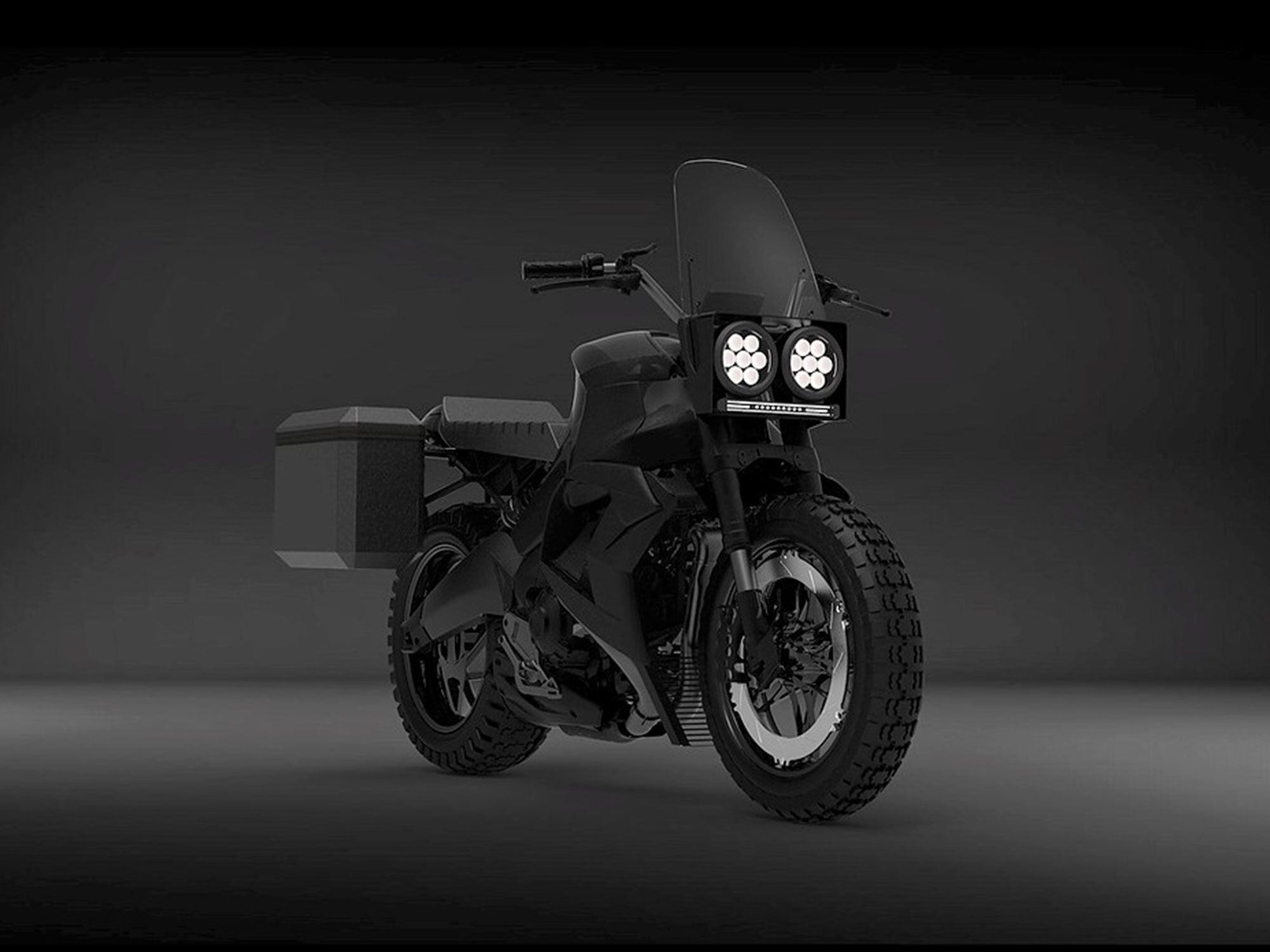
The reborn brand also says it plans on releasing an 185 hp adventure model based on the 1190SX. (Buell Motorcycles/)But those are just intended to be the start. The firm says it has plans to make tourers and cruisers as well as dirt and dual sport machines to go with its stable of superbikes in the future and, what’s more, says the range will include “medium- and small-displacement motors” as well as the 1190 V-twin.
Melvin said: “We are excited to bring Buell back with this awesome assortment of superbikes and performance motorcycles. We start with the fastest American production motorcycles, handbuilt in the USA, so that’s a nice start! We’re building out those platforms for more touring and adventure models, then we’re expanding our displacements to be competitive with other global brands. The passionate Buell Nation can grow and thrive again.”
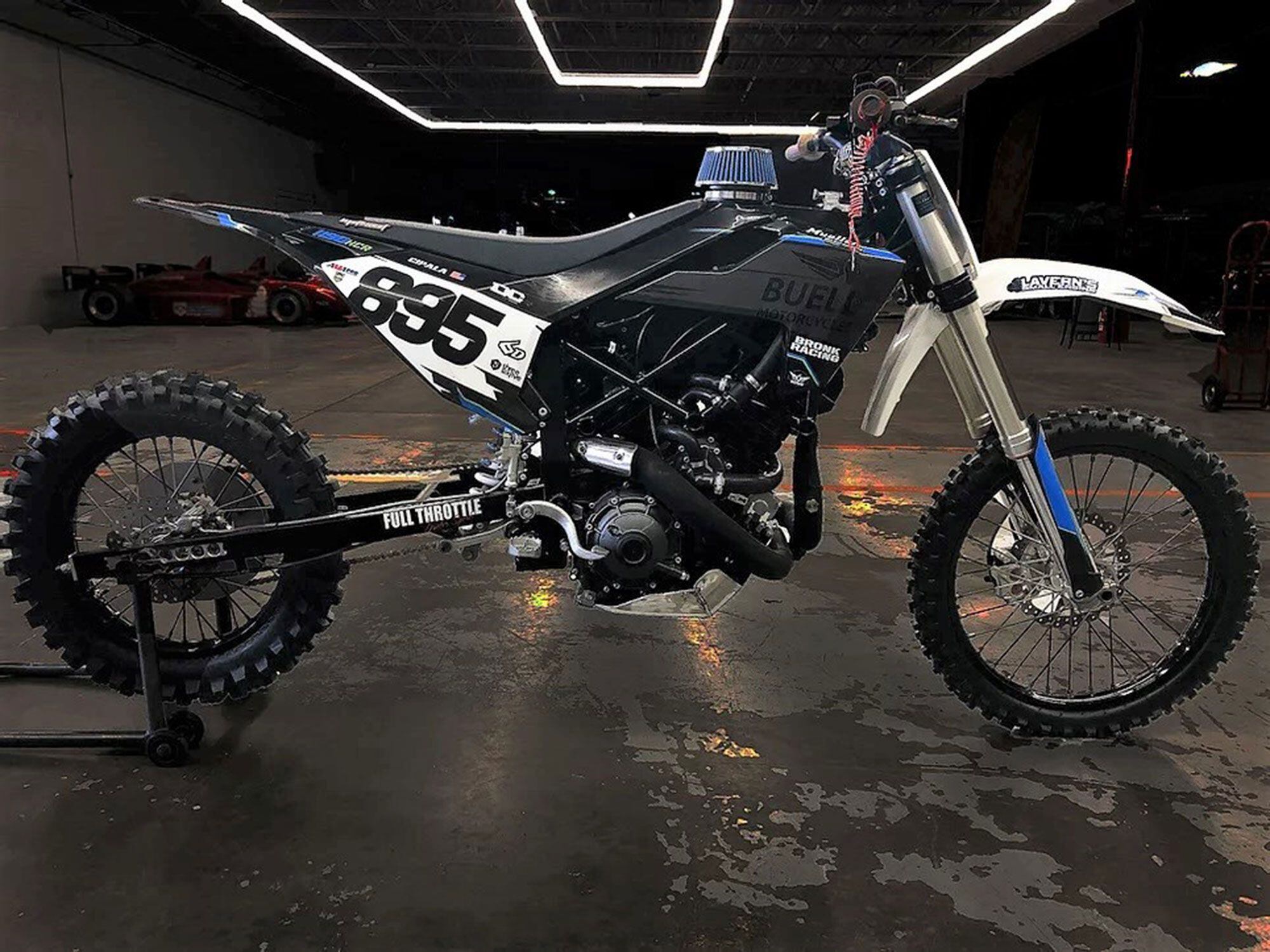
Buell’s 2020 AMA National Hillclimb title-winning bike will be the inspiration for a shorter-wheelbase desert racer in the future. (Buell Motorcycles/)Unlike some revivals, the reborn Buell brand is the direct successor to the original company that Erik Buell founded back in the mid-’80s. Having taken a minority stake in the firm in 1993, H-D became majority owner in 1998, launching a development onslaught in the mid-’00s that saw Buell finally get its own engine in the form of the water-cooled, Rotax-developed DOHC V-twin used in the 2007 1125R and 2009 1125CR. In the face of the financial crash, Harley made the decision to refocus on its core products, closing Buell and selling MV Agusta—which it also owned at the time–in 2009.
The story didn’t end there. While H-D wouldn’t allow the Buell brand name to be used, it agreed to allow Erik Buell to build and sell the successor to the 1125R under a new company, Erik Buell Racing, or EBR. Initially, the agreement only allowed racebikes to be made, but that was relaxed to allow road models in the years to come. The first EBRs—the 1190RR and the road-going 1190RS that followed—were effectively the second-generation version of the 1125R, which had been on the verge of being launched when the plug was pulled on Buell.
RELATED: 2015 EBR 1190SX- First Ride
Despite a deal that saw Indian firm Hero MotoCorp take a 49 percent share in EBR in 2013, the firm went into receivership in 2015, with Hero snapping up the R&D arm of the firm and the rest ending up in the hands of bankruptcy specialist Liquid Asset Partners. Under the new name “EBR Motorcycles,” production restarted in 2019, with Liquid Asset Partners boss Bill Melvin at the helm. EBR Motorcycles acquired the rights to the Buell brand name, at least in the USA, in early 2020, although European trademark registers show that the Buell name is still registered to Harley-Davidson in that part of the world.

On Buell’s website it’s called the Hammerhead 1190RX and will be available in Carbon Fiber or Heritage liveries. (Buell Motorcycles/)A recap of the forthcoming models from Buell:
2021 Buell Hammerhead 1190RX
A rebranded version of the EBR 1190RX, itself the direct descendent of the Buell Barracuda II prototype that was lost when Harley-Davidson closed the original iteration of Buell in 2009. Dubbed the Hammerhead 1190RX on the firm’s website, it features Buell’s 185 hp, 1,190cc V-twin with a compact 72-degree V-angle, mounted in the unusual fuel-in-frame chassis that’s been a Buell signature since the XB9R Firebolt of 2003. It also features the firm’s rim-mounted brake discs and an impressively light 419-pound wet weight.
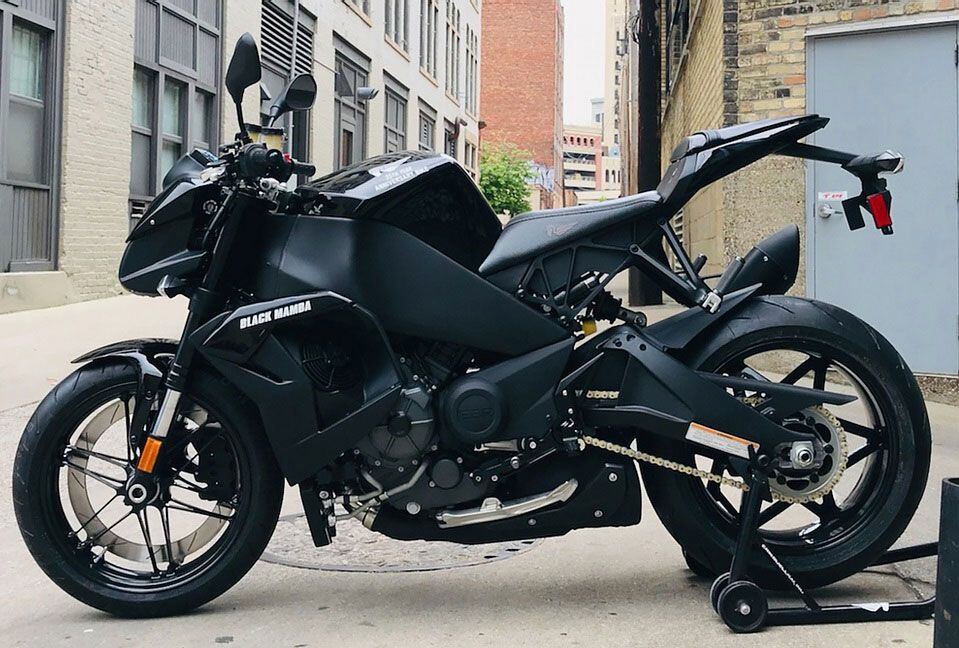
The naked 1190SX is built on the same 1190RX platform, and will be available in Carbon Fiber or Black Mamba versions (shown). (Buell Motorcycles/)2021 Buell 1190SX
A carryover of the EBR 1190SX, Buell’s unfaired offering is effectively the same as the RX, simply fitted with less enveloping bodywork and wider, flatter bars. An even lighter claimed 414-pound wet weight is the result.
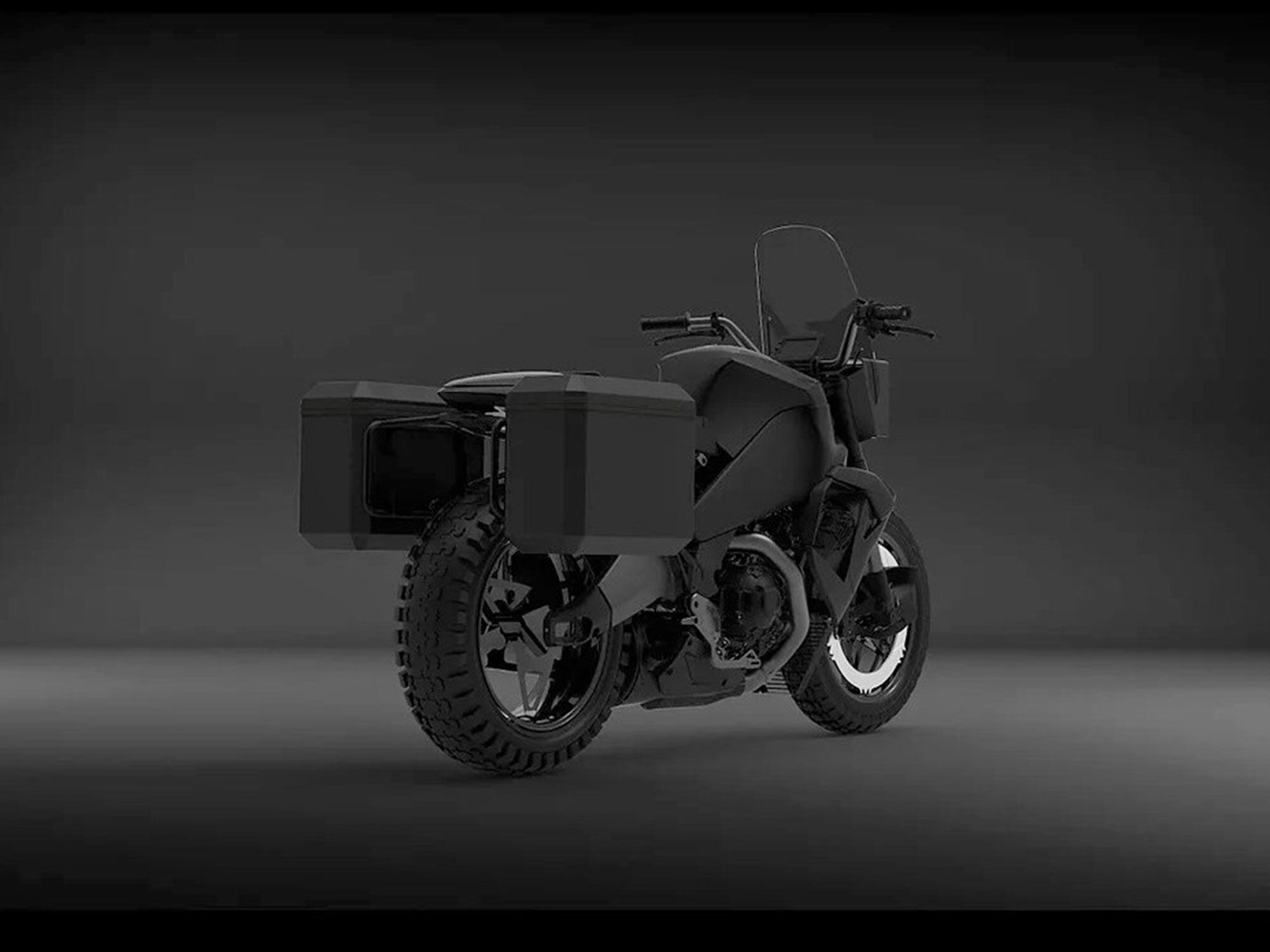
A dedicated adventure bike from Buell has long been in the works, and it’s expected to have the signature fuel-in-frame design. (Buell Motorcycles/)Buell 1190 Super Touring
Initially Buell is promising to offer a touring accessory package for the 1190SX, which it says will be available later this year, before launching a dedicated adventure bike in 2023. From the renderings seen here, the chassis is again the fuel-in-frame design, allied to off-road tires and a more upright riding position.
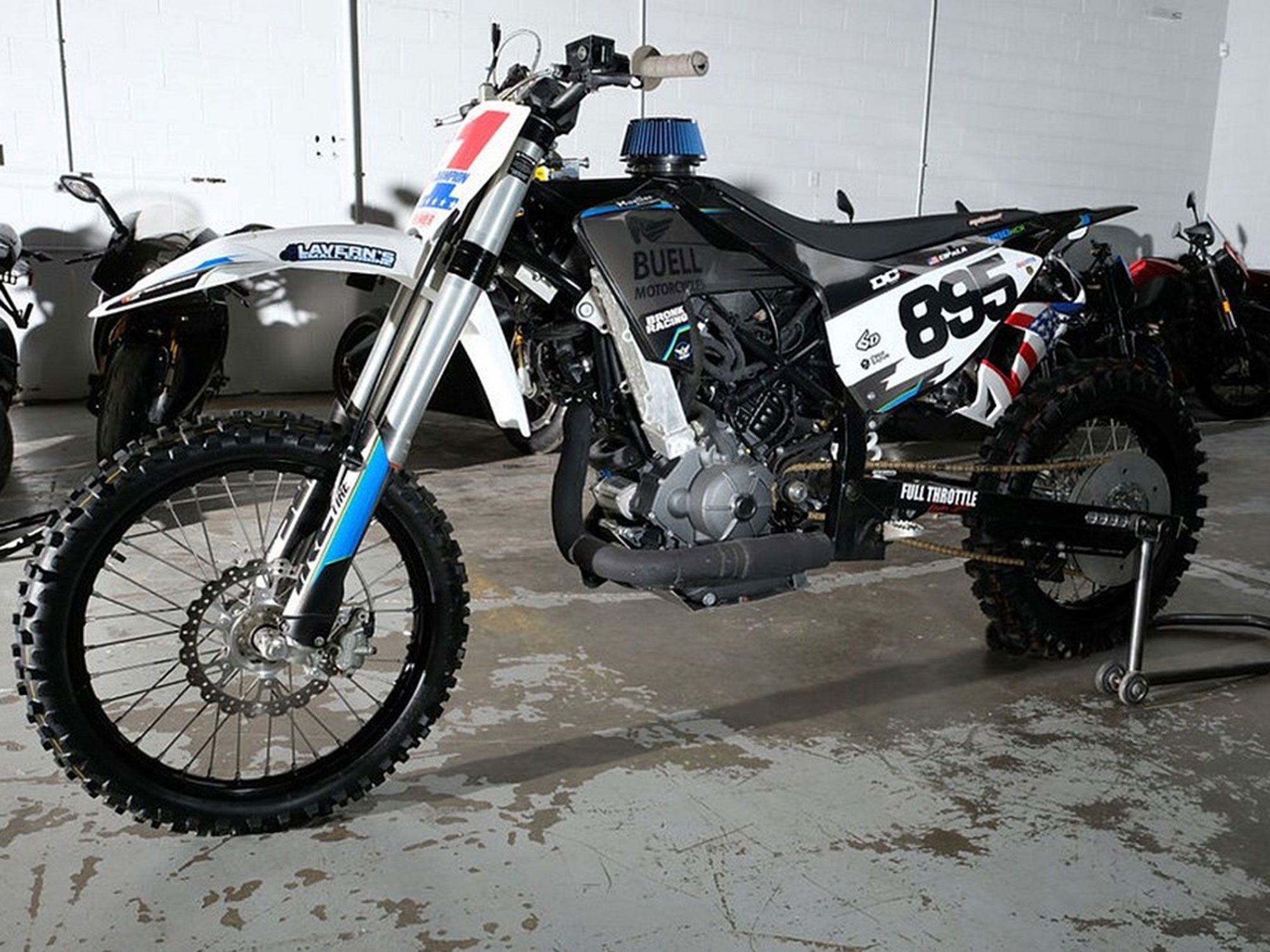
This purpose-built HCR hill climber will serve as the platform for upcoming dirt racing and adventure bikes. (Buell Motorcycles/)Buell 1190 HCR
An out-and-out competition bike designed for the sole purpose of hill climbing, the HCR features the usual Buell engine bolted to a steel tube frame with a massively extended swingarm. With 185 hp and a skimpy 355-pound wet weight the performance is understandably impressive. A shorter-swingarm Baja version based on the same platform is also planned for off-road “Baja Race” and “Baja Adventure” forms.
-
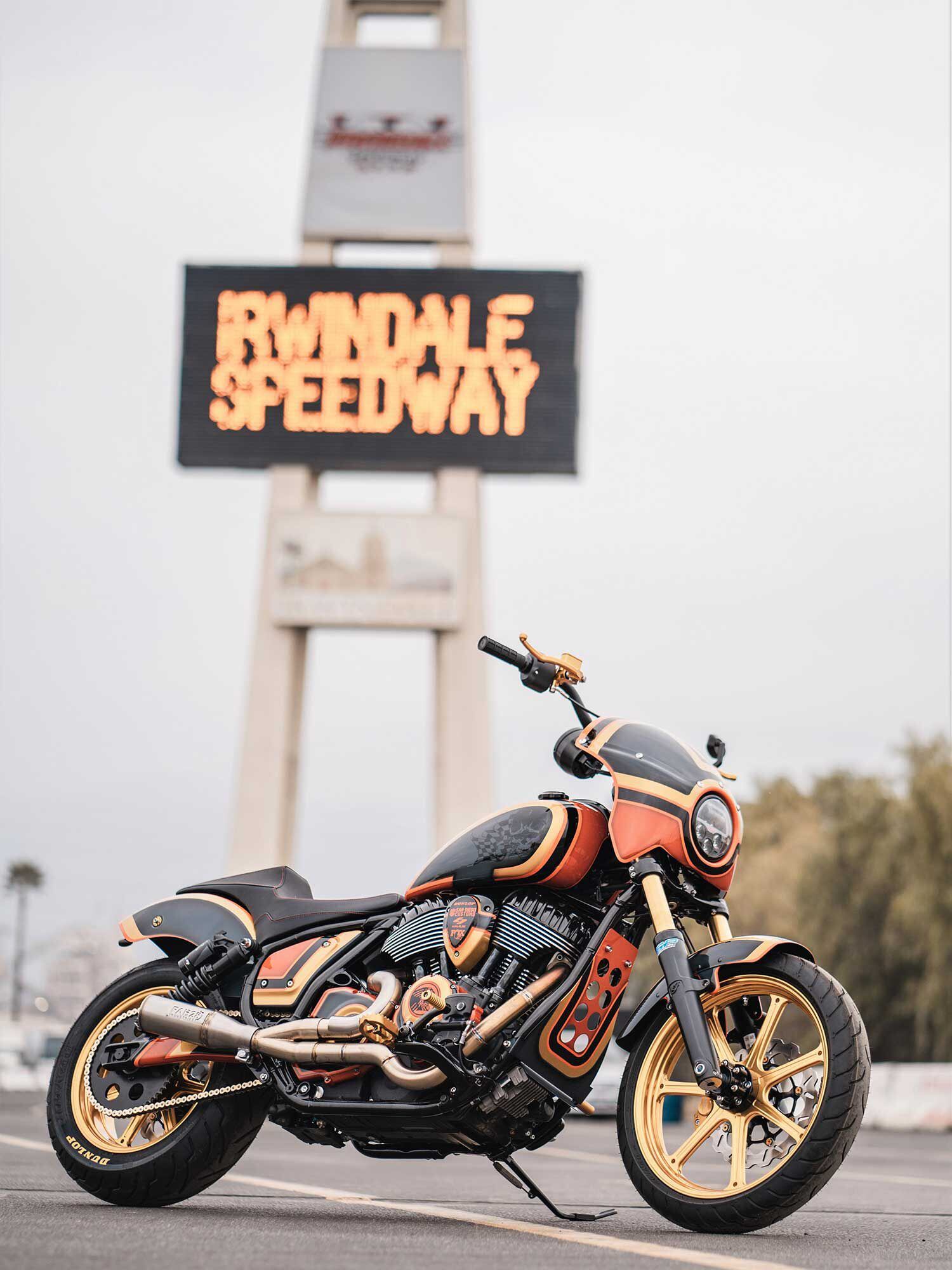
Most manufacturers will also trot out a custom version of new models to help sell the personalization possibilities. The first custom based on the revamped Indian Chief comes courtesy of Carey Hart. (Johnny Laney/)Indian Motorcycle just dropped its three totally redesigned 2022 Chief models, but certain insiders got their paws on the bike much sooner so that they could build a custom version based on the platform. The company may have officially taken the wraps off the Indian Chief, Indian Chief Bobber, and Indian Super Chief models this week but motocrosser and customizer Carey Hart was lucky enough to score an up-spec version of a stock Chief (in the form of an Indian Chief Dark Horse) some weeks ago and, as you’d expect, upped the specs and the stance even more.
Related: 2022 Indian Chief First Look and Gallery
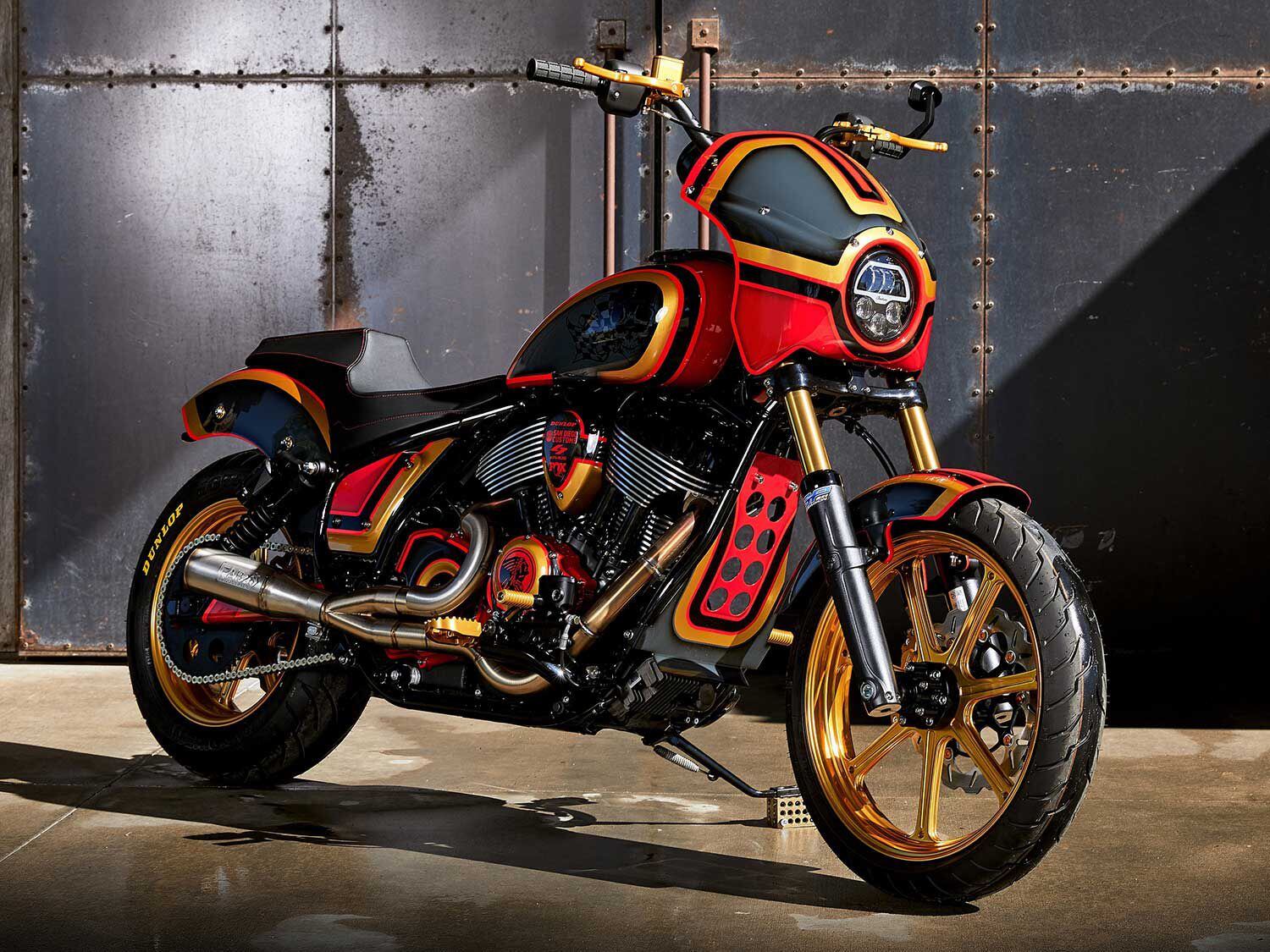
The Chief Dark Horse Hart got his hands on packs the higher-compression Thunder Stroke 116 engine and Ride Command system as standard. (Johnny Laney/)With the new 2022 Chief’s design being a pretty radical departure from most of the other Chief iterations over the decades, Hart had a more minimal—practically blank, actually—foundation to start from. Given the skimpy bodywork, mid-mount controls, and drag bars, the new Chief already brings a more sporty riding position, and it looks like Hart took that aesthetic and added a more purposeful performance bias to it, swapping in new wheels, tires, brakes, fork… We’ll just get to as much as we can in the gallery that follows. Read on for the details.
Related: Carey Hart’s “King Killer” Custom Indian
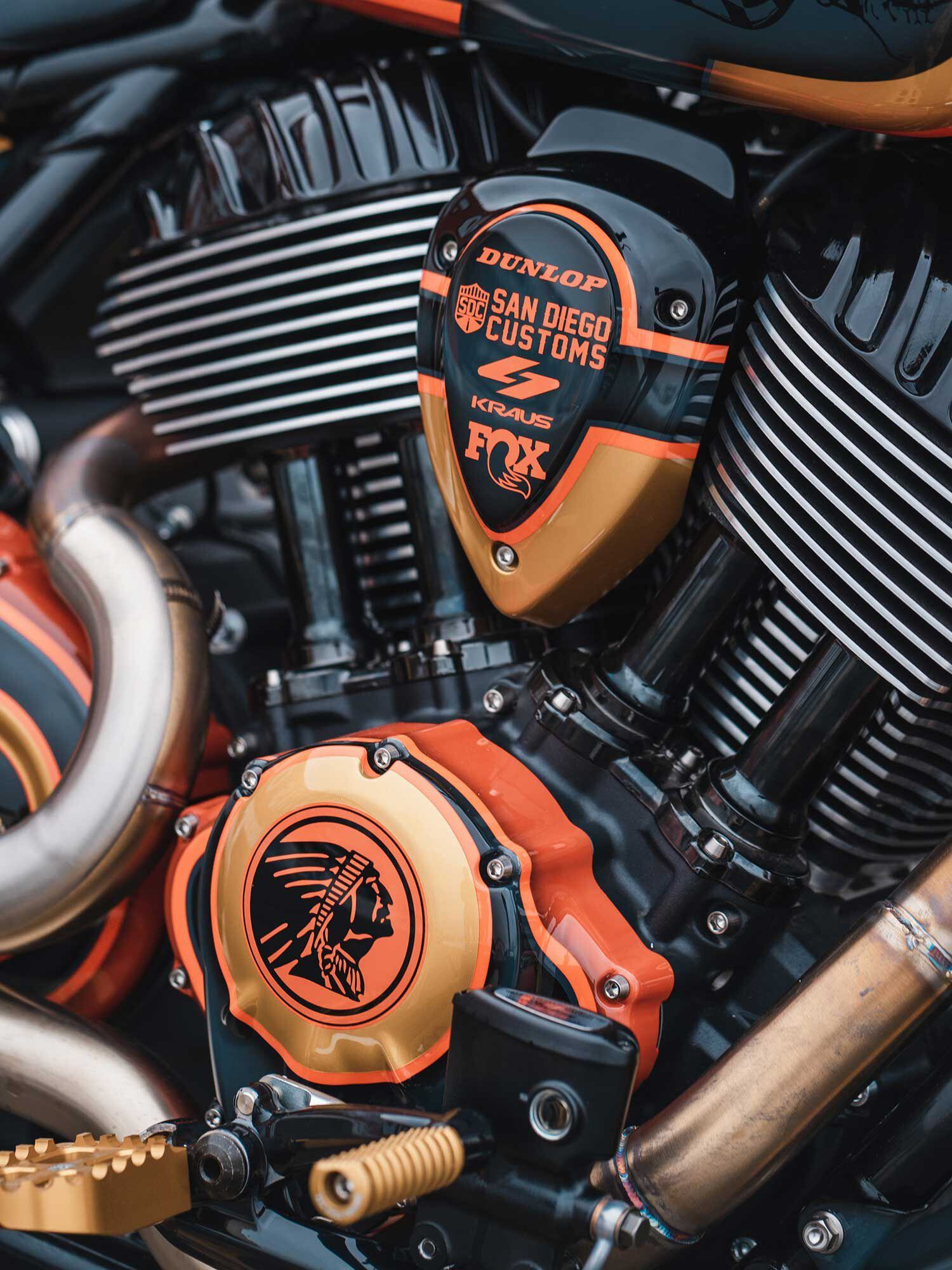
The Indian Chief Dark Horse version packs the higher-compression Thunder Stroke 116 engine which Hart accented with new covers and graphics, though no word on if he did any internal tinkering. (Johnny Laney/)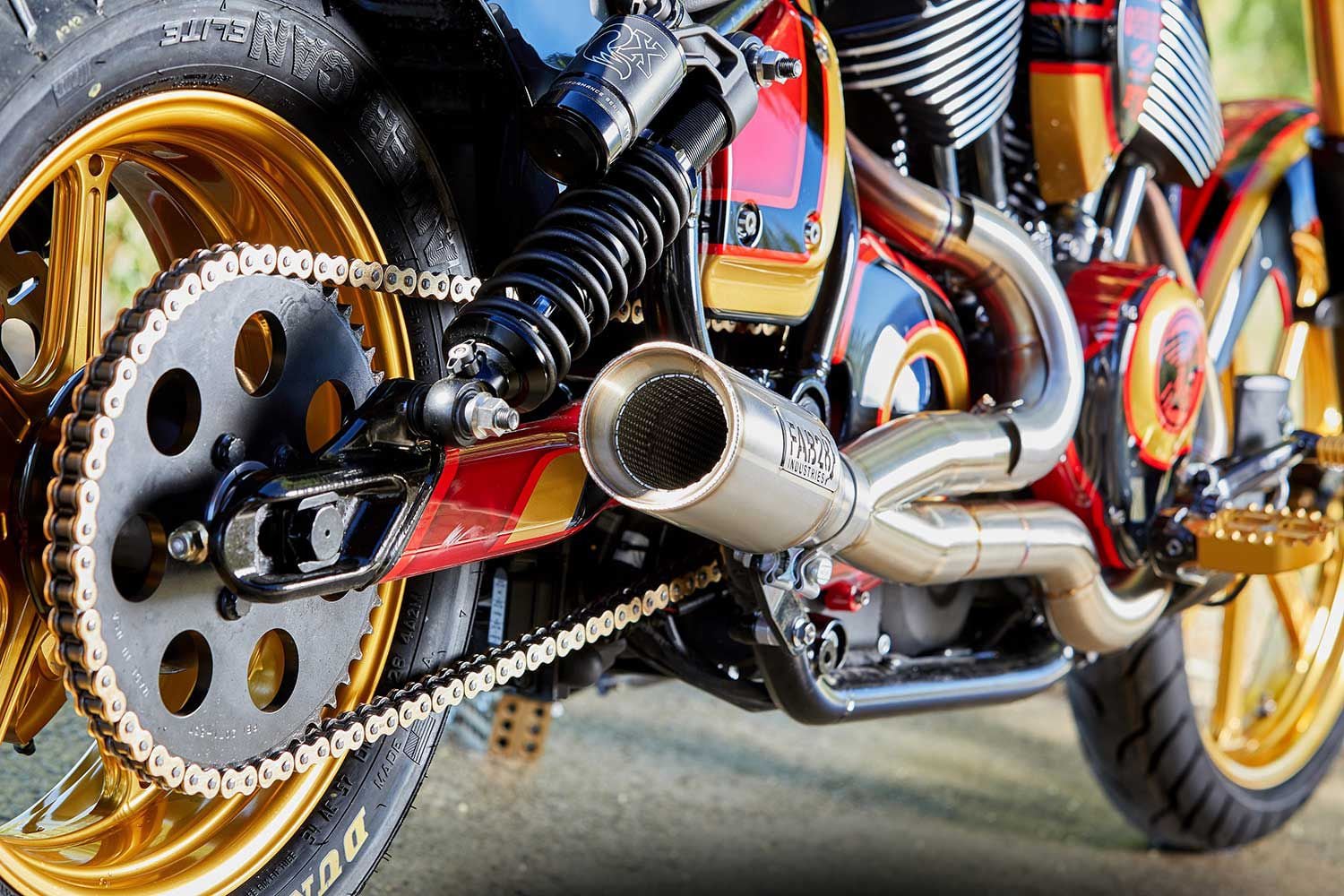
Replacing the stock model’s staggered dual exhaust is a 2-into-1 custom unit from Fab28 Industries; chain conversion is by Zipper’s. (Johnny Laney/)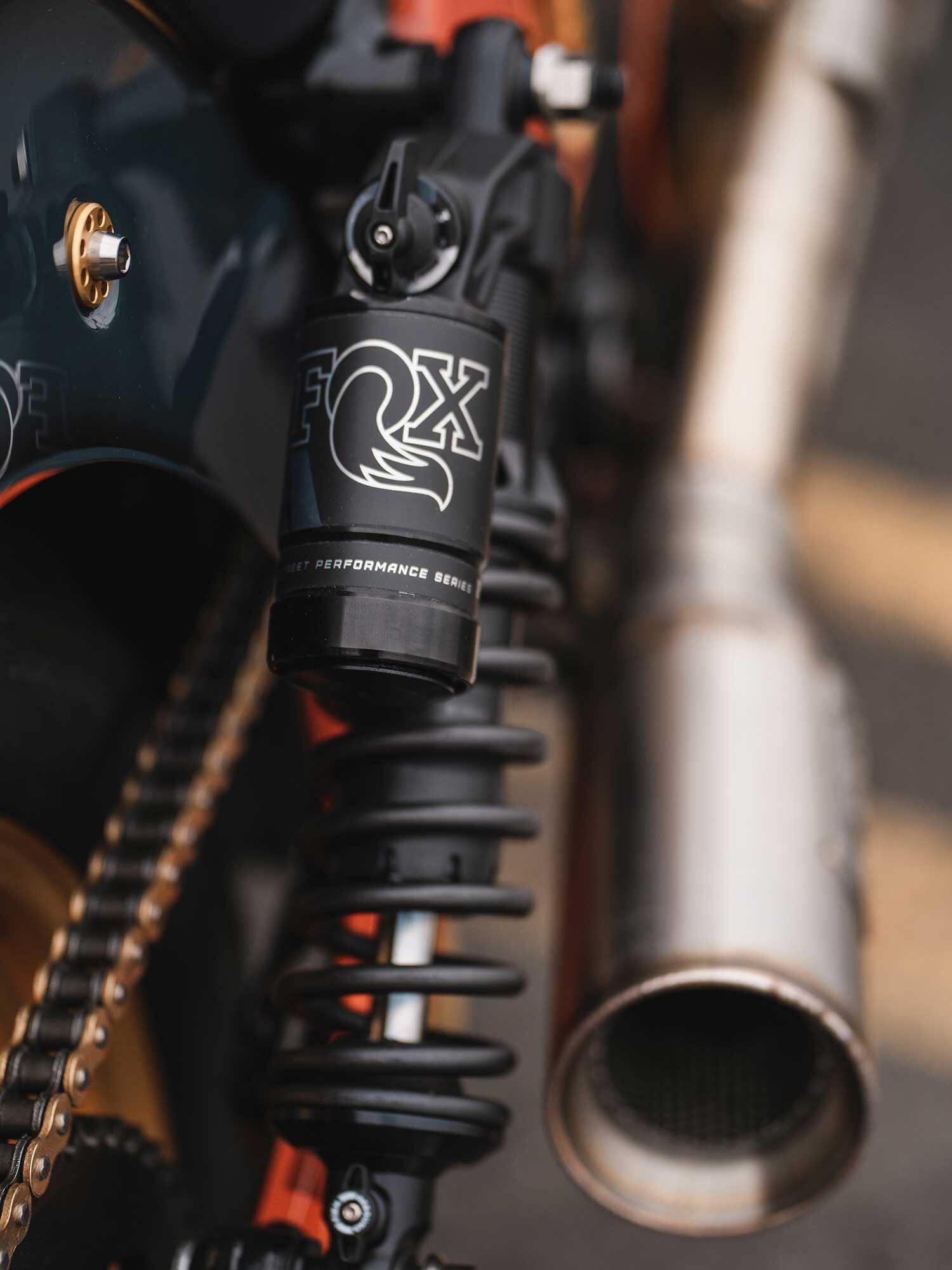
The new Chief also more easily allows for new suspension upgrades; the external stock shocks get swapped with a premium set of piggyback Fox units. (Johnny Laney/)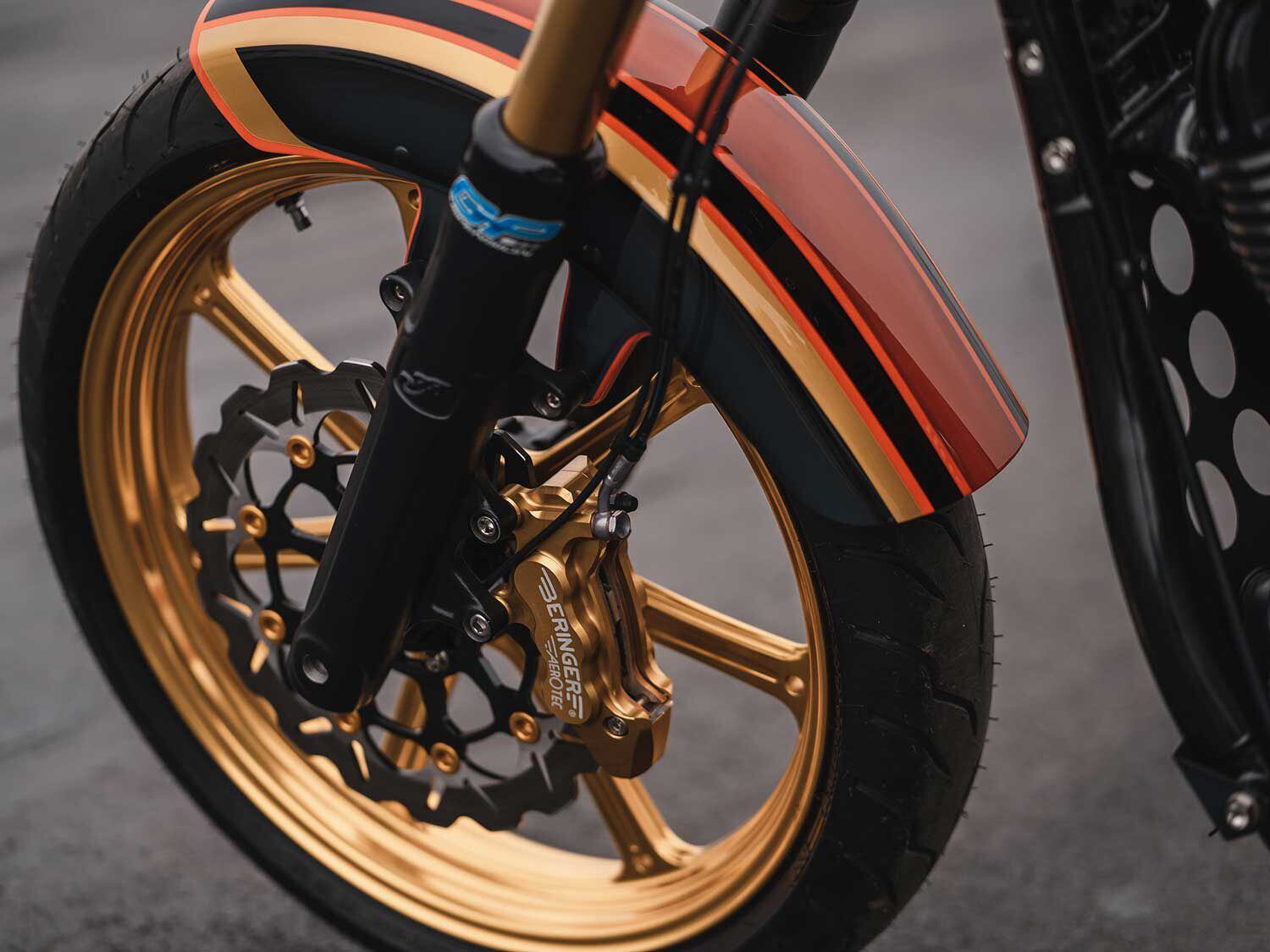
The new copper-finish wheels are from San Diego Customs, and wear new Galfer rotors now clamped by Beringer calipers. (Johnny Laney/)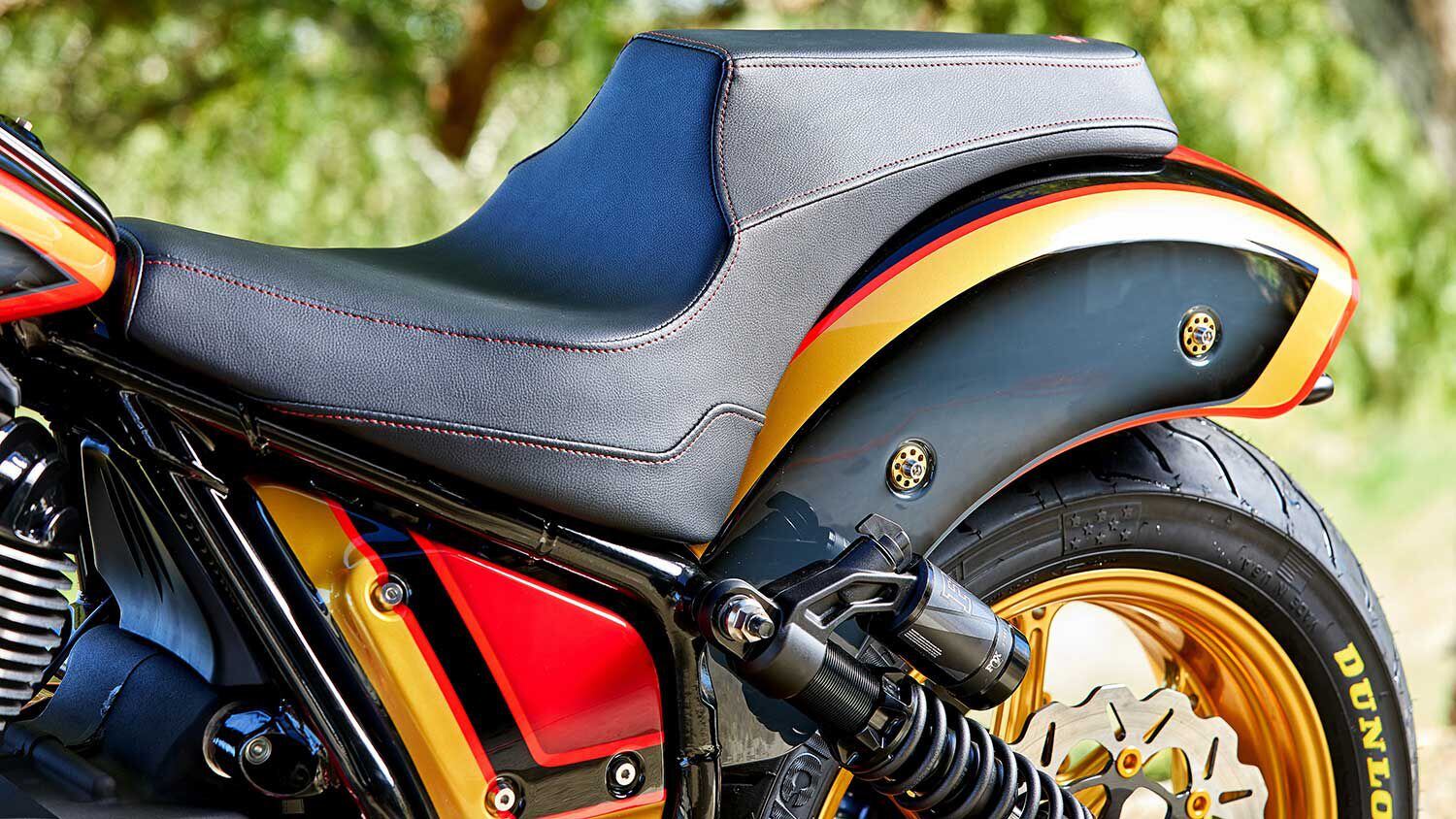
In keeping with the performance theme, Saddlemen stepped in with a stepped, dragster-style seat to replace the wide, scooped stock unit. (Johnny Laney/)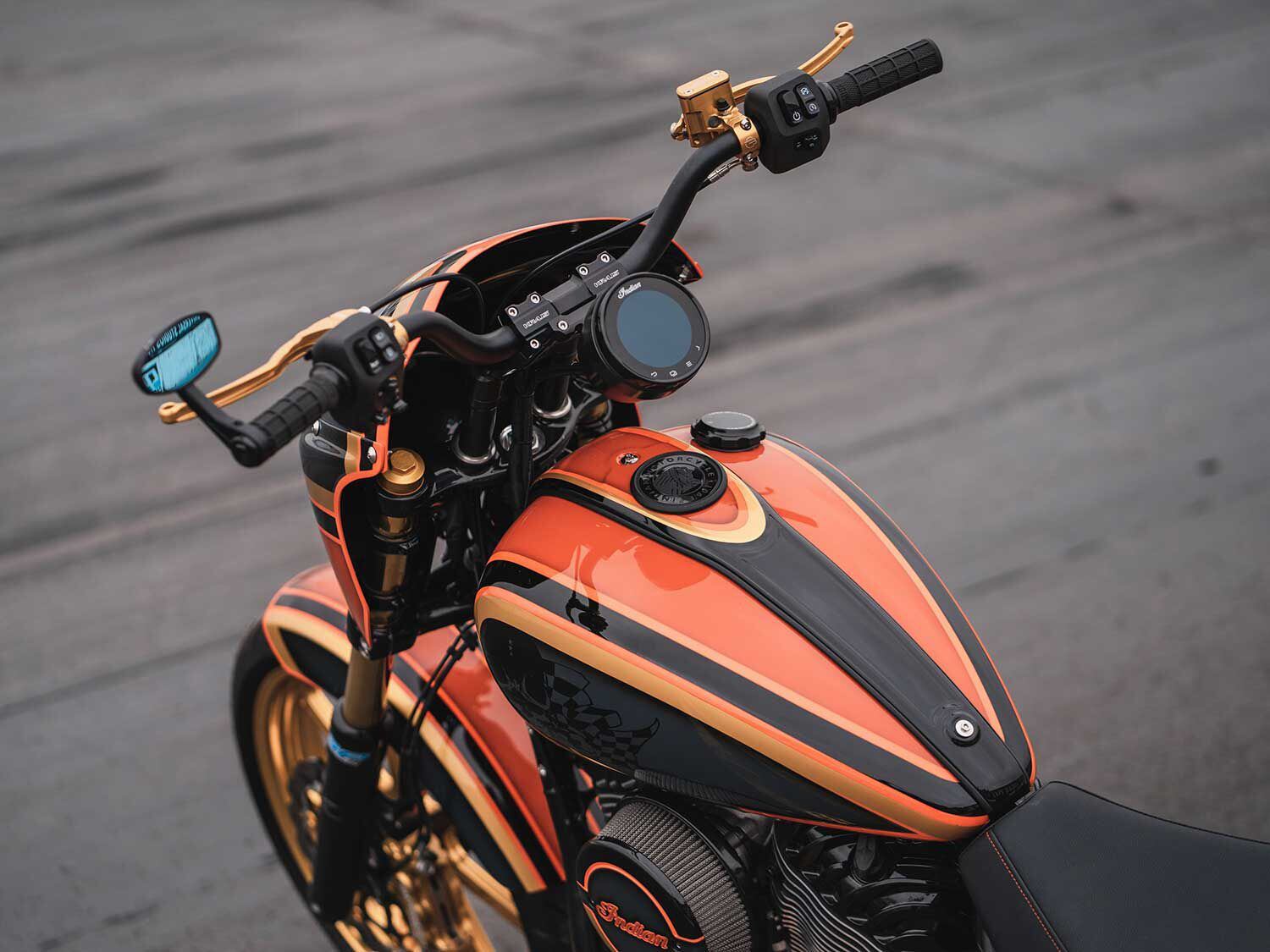
New finishes, paint, and trim fill in the cockpit area, with bars and grips from ODI; bar clamps, risers, and gauge bucket from Kraus Motor Co.; and mirror from Rizoma. (Johnny Laney/)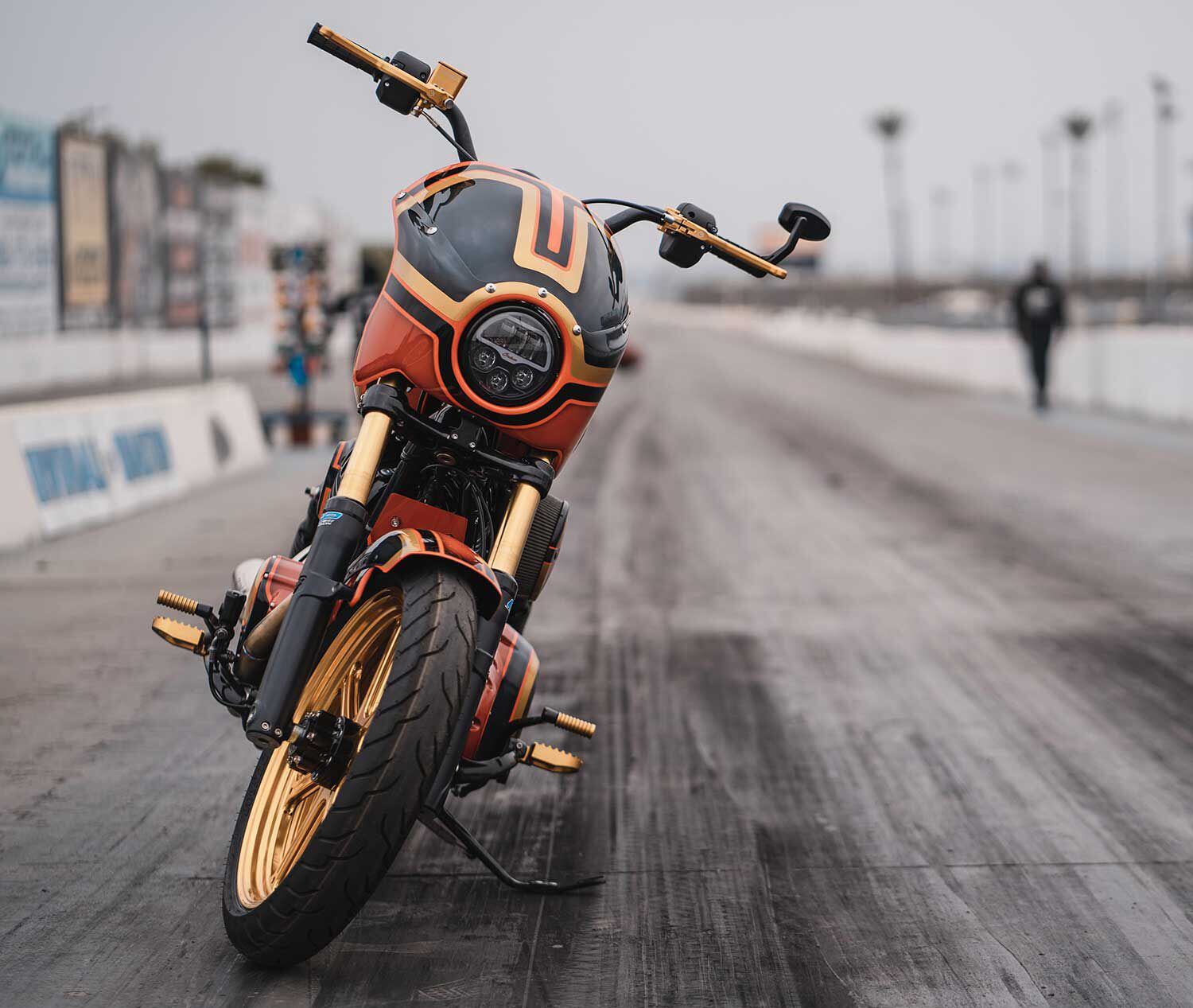
The Chief takes on a way different demeanor viewed from the front, thanks to a Ness front fairing and fork extensions from Altered Industries. GP Suspension internals now live in the fork. (Johnny Laney/) -
Hello Luganigo,
Welcome to The Motorbike Forum. Please feel free to browse around and get to know the others. If you have any questions please don't hesitate to ask.
Why not tell us a bit about yourself too.
-
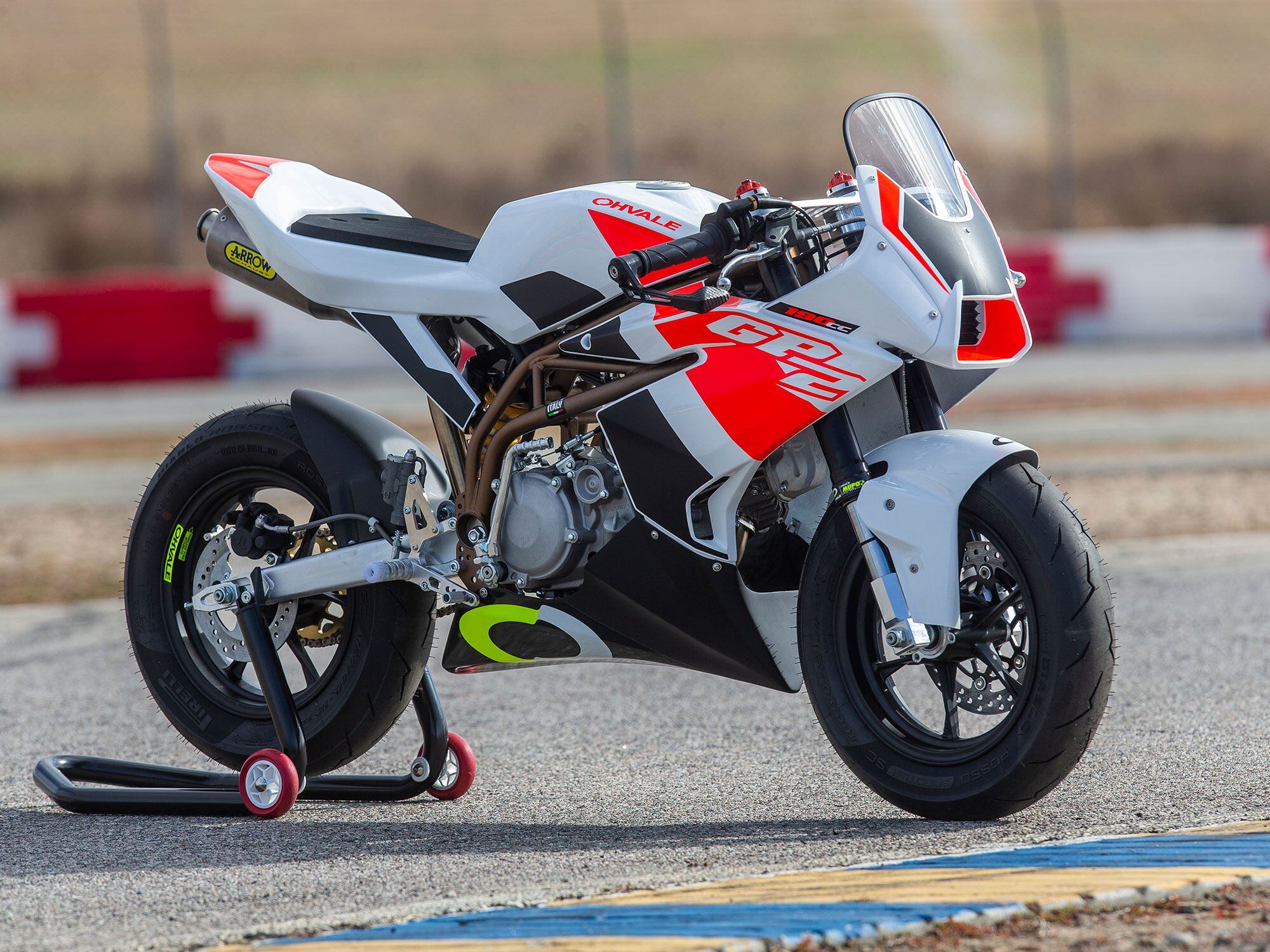
The Ohvale GP-2 190 is a small-scale, but full-spec racebike riding on 12-inch wheels. (Jeff Allen/)What the heck is an Ohvale GP-2 190, you may well wonder? Let’s start with what it’s not. The Italian manufacturer is quick to dismiss the notion that it’s a minibike, pocketbike, or toy. Instead, it’s built as a miniature yet full-spec racebike aimed at providing superbike-level feel and experience in a cost-effective and approachable package. And according to the Instagram profiles of MotoGP superstar Álex Rins and American-racing favorite Josh Herrin among others, Ohvales are ridiculously fun and prominent training tools.
The GP-2 190 enters Ohvale’s 2021 lineup as an all-new halo model, boasting 12-inch wheels, a revised chassis, and roomier ergonomics than the GP-0 110, 160, and 190 platforms, which feature a 10-inch wheel setup and are all still for sale. Ohvale has positioned the GP-2 as a steppingstone for younger riders transitioning to full-size machines and a more enticing option for grown adults considering a taste of the mini experience.
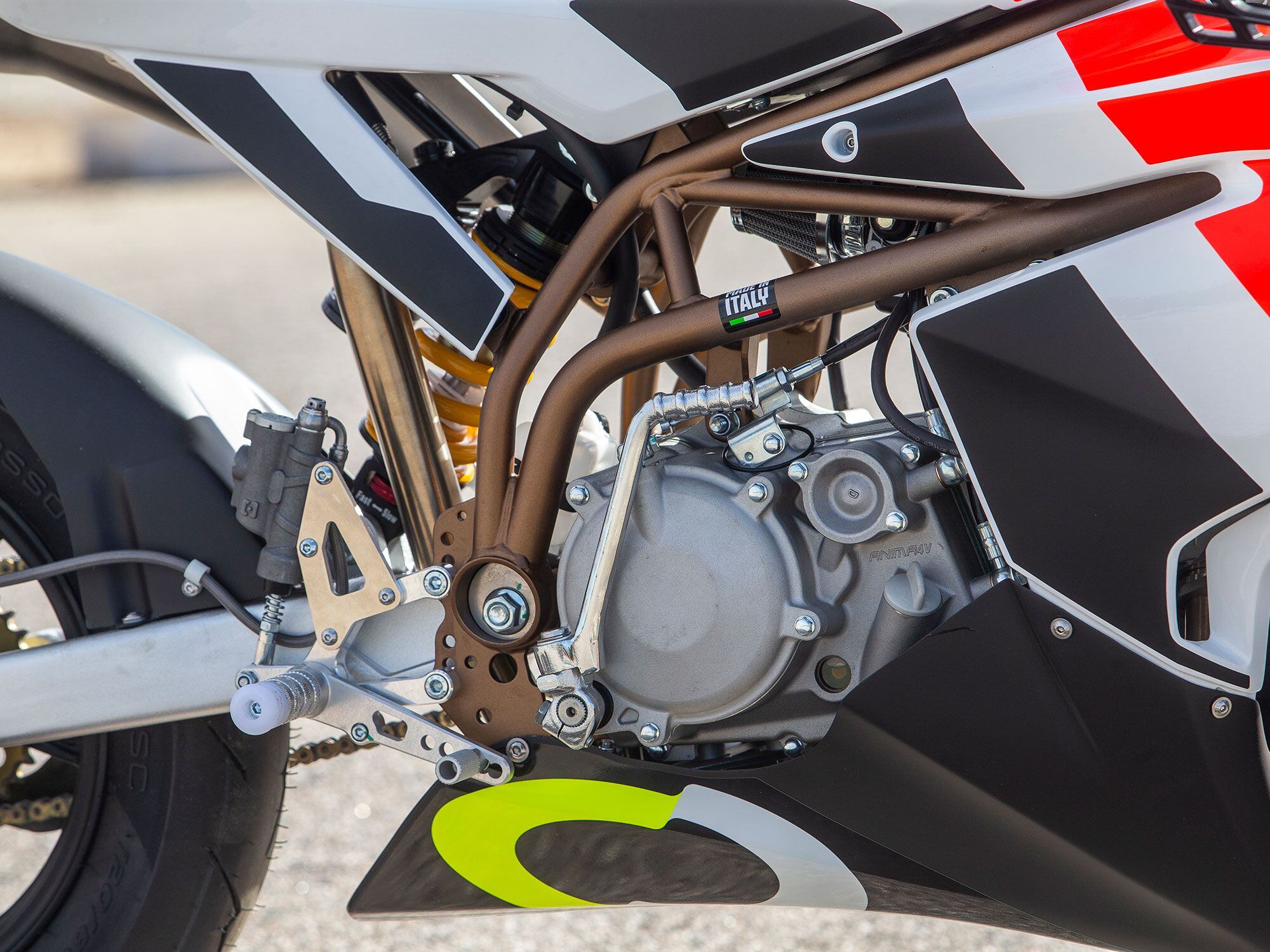
The heart of the GP-2? A 187cc air-cooled single produced by a Japanese-based manufacturer by the name of Daytona. (Jeff Allen/)A closer look at the Ohvale GP-2 190 reveals racing DNA from the contact patches up. Beyond the race-inspired fiberglass bodywork, the design philosophy replicates modern-day supersport technology. Ohvale claims to have studied everything from sprocket positioning to triple clamp offset and trail to construct a steel-trellis chassis, proudly marked “Made in Italy,” that achieves a 53/47 weight bias and ride feel similar to modern sportbikes.
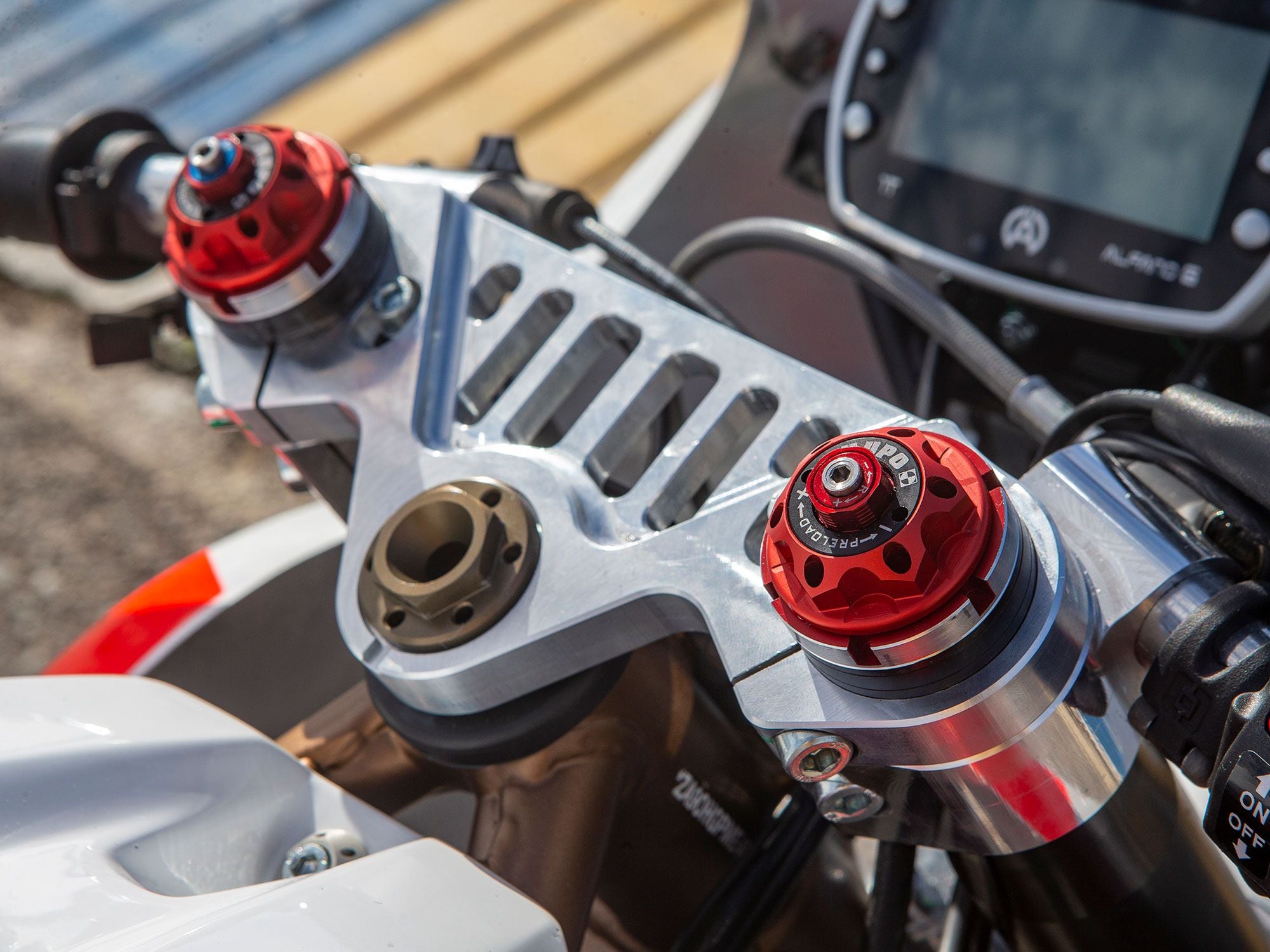
Dedication is in the details. Ohvale spared no expense on CNC-machined bits for the GP-2, like these triple clamps. The 38mm inverted fork with fully adjustable Mupo internals is a $699 option. (Jeff Allen/)And the details don’t stop there. The bike connects to the asphalt via Pirelli Diablo Rosso Scooter SC race tires, while a 33mm inverted fork with spring preload adjustability is mated with a fully adjustable rear shock to handle damping needs. Stopping power comes in form of a four-piston J.Juan radial-mounted caliper over a 220mm disc up front and a single-piston caliper at the rear. Factory-looking CNC-machined bits, like triple clamps, fork lowers, and rearsets, add premium touches. It’s serious stuff for a little machine.
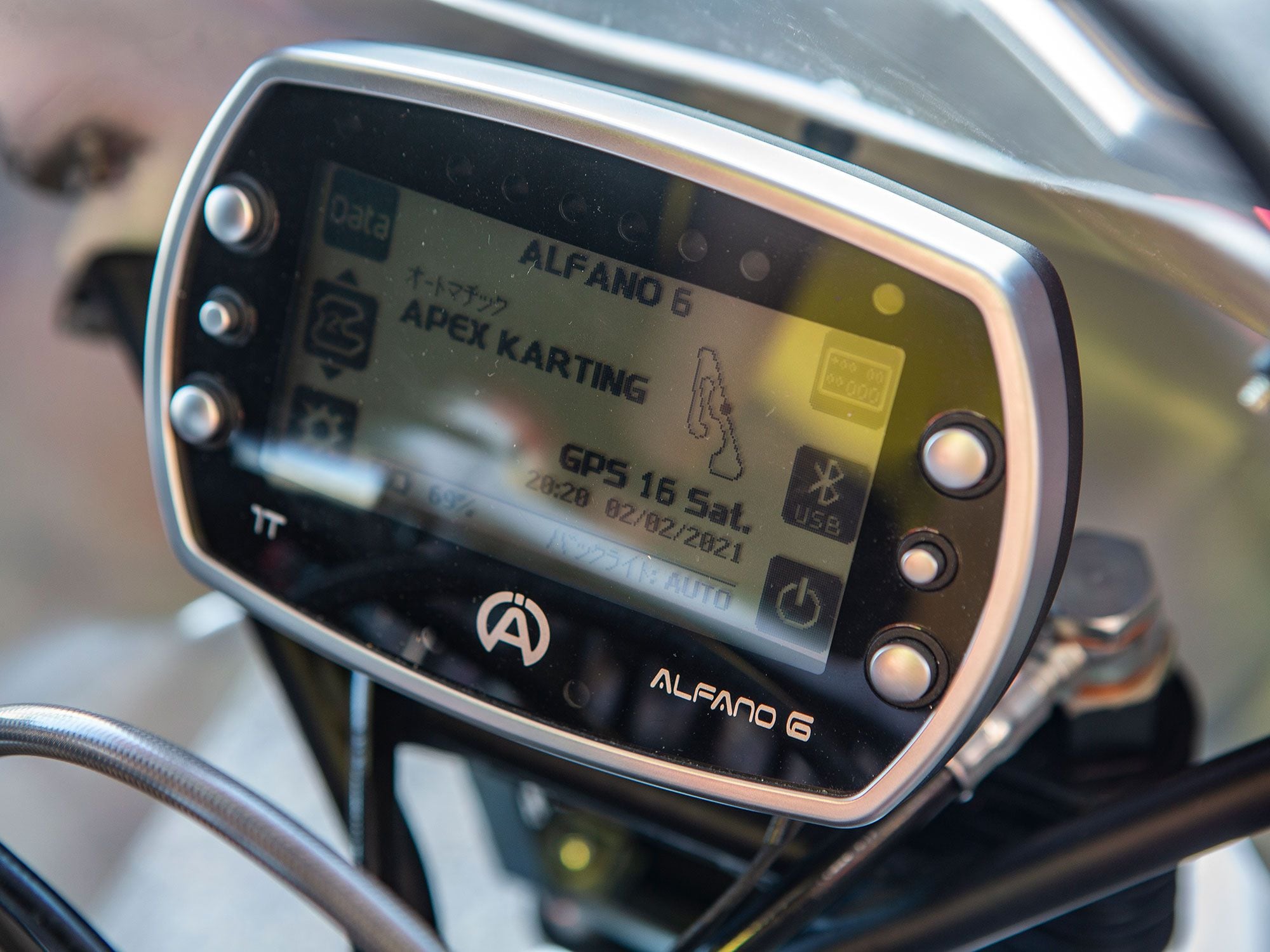
The Ohvale accessory catalog is extensive and features a lot of trick bits, including this Alfano LCD dashboard with GPS lap time functionality ($499). (Jeff Allen/)The GP-2 is powered by a four-valve, air-cooled, 187cc single-cylinder engine mated to a four-speed gearbox. The engine is made by Japan-based Daytona, and one interesting feature is that it has neutral at the bottom of four speeds in the sequential shift pattern. Ohvale claims the 190 produces 25 hp, and while it sounds like nothing to write home about in nearly any application, consider that the GP-2 tips the Cycle World scales at only 167 pounds fully fueled. That’s a 0.15 hp(l)/pound power-to-weight ratio, identical to the last SV650 we tested—a popular trackday bike that’s heaps of fun.
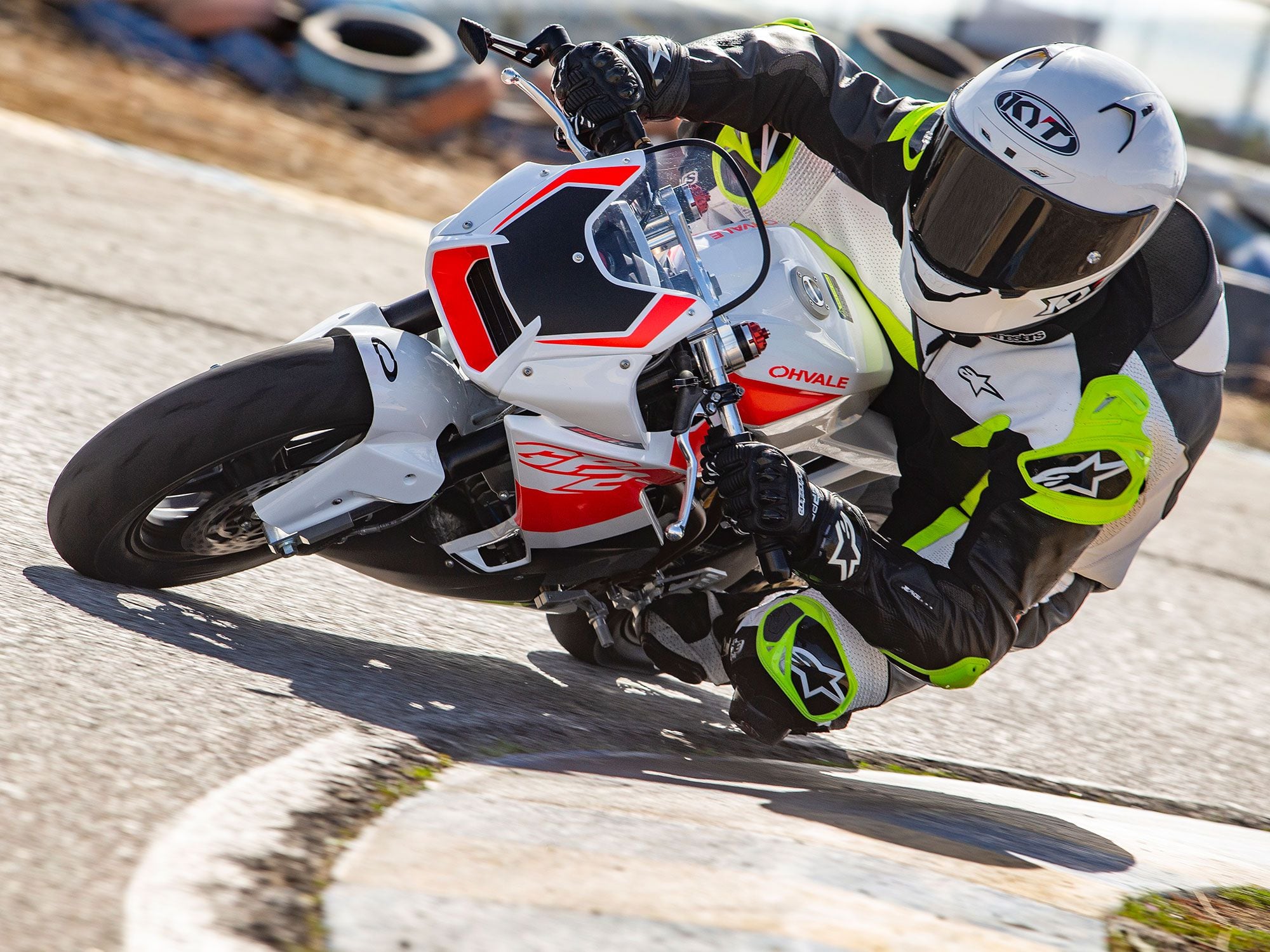
Deck a knee on the Ohvale GP-2 190. Almost! (Jeff Allen/)Kickstarting (when’s the last time you heard that?) the Ohvale’s engine and settling into the cockpit on a thinly padded seat feels different than your typical racebike, for obvious reasons. The measured low 27.6-inch seat height means that piloting the Ohvale feels more like go-kart height than motorbike. The seat-to-peg distance is 16 inches, about an inch less than your average production supersport, and it’s an aggressive reach to the clip-on handlebars. All of that combined makes the GP-2 an undeniably small motorcycle, but who said it wasn’t? For what it’s worth, I’ll argue it’s a lot less cramped than anticipated for my 5-foot 7-inch stature, and stringing together 20-minute sessions came with only manageable shoulder and wrist discomfort. I suspect this can be somewhat mitigated via the adjustable clip-on positions.
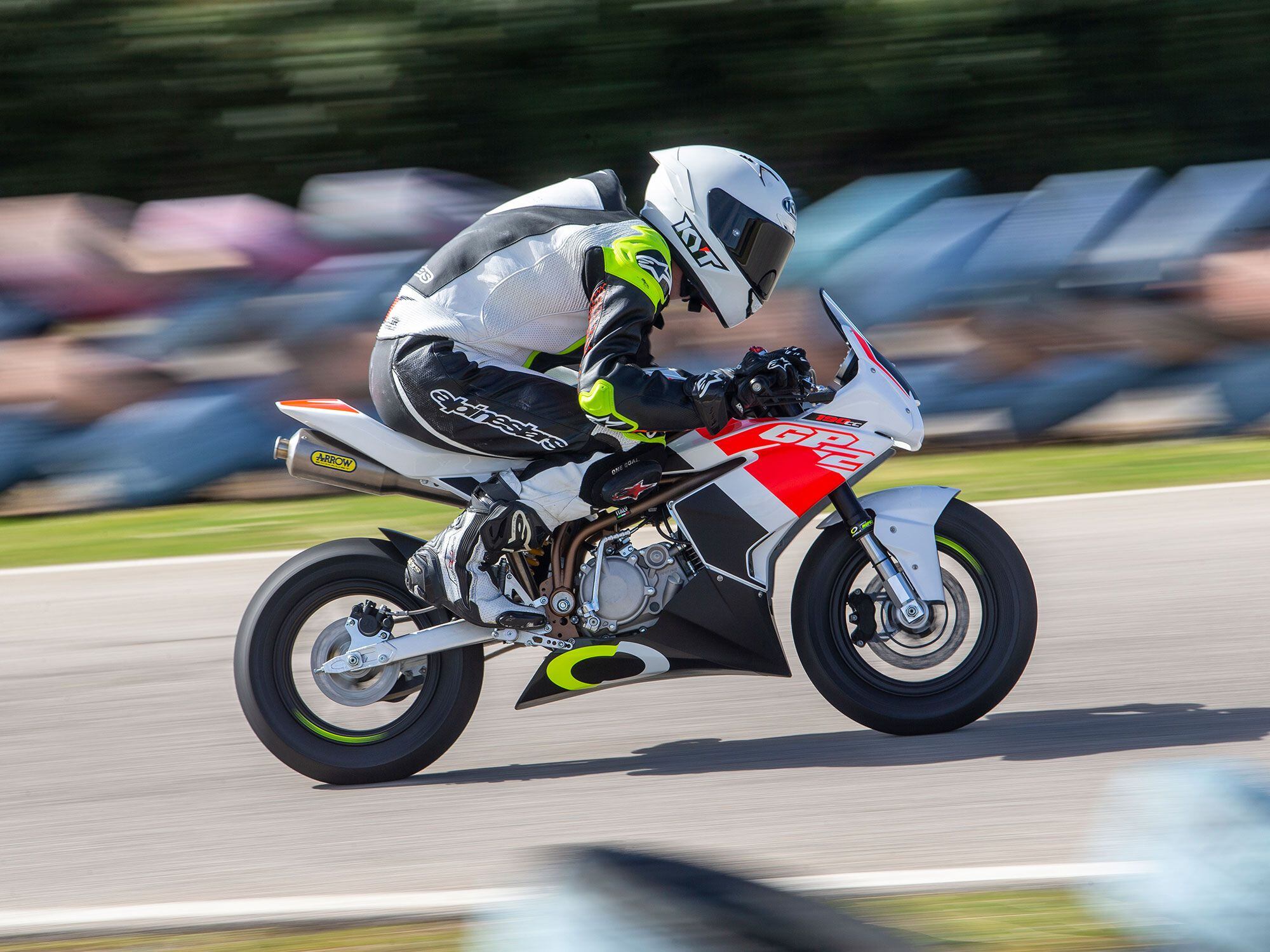
The GP-2 190 is undeniably a small motorcycle, but is more comfortable than anticipated for this 5-foot 7-inch stature. (Jeff Allen/)Riding the GP-2 is a remarkable experience once you complete the game of Twister necessary to get comfortable. Of course, the small size and light weight makes this bike a slayer in the tight confines of the kart track, but what’s most impressive is the deep-rooted connection of the Ohvale’s chassis to the racing surface. The chassis communicates every nook and cranny through its tires; the brake lever allows a thorough understanding of how much pressure is being applied to the caliper. Likewise, the throttle connection is direct and, while the numbers may suggest otherwise, the power delivery is engaging—scratch that, the power is ridiculously fun. Plain and simple, it feels like a purpose-built racebike.
And that’s what makes the Ohvale GP-2 190 so enticing. It really does feel like a full-size motorcycle when pushed to the limit, but better yet it comes with a fraction of the risk. The experience earned on the Ohvale can undoubtedly transfer to your big-bike skill set or prepare junior riders for a transition to larger, more capable motorcycles. It teaches you to be smooth and precise with your body positioning, throttle inputs, and brake pressure, because anything else will overwhelm the GP-2 and rob you of precious lap time. Smooth is fast, just as it is on a 400cc, 600cc, or 1,000cc supersport.
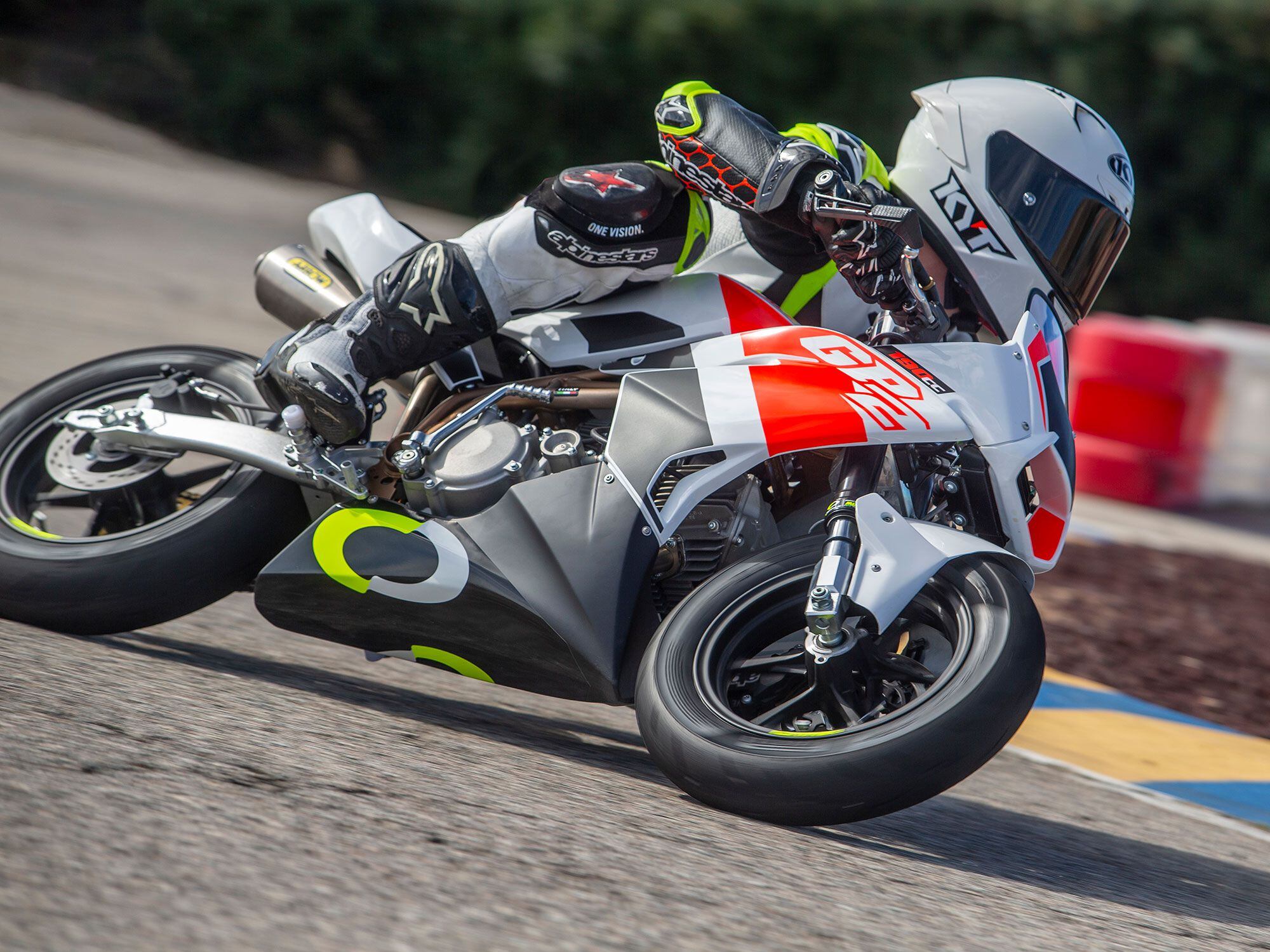
The coolest aspect of the Ohvale? The feel and connection of the chassis to the asphalt, just like a proper full-size race machine. (Jeff Allen/)Ohvale has made a worldwide racing push, including the birth of the Mini Cup, taking place at four MotoAmerica rounds in 2021. The series features classes for the 110, 160, and 190 platform for youngsters of ages 6 to 14, and the opportunity to race at the same venue at the same time as America’s finest, which is something I’d have killed to experience as a kid.
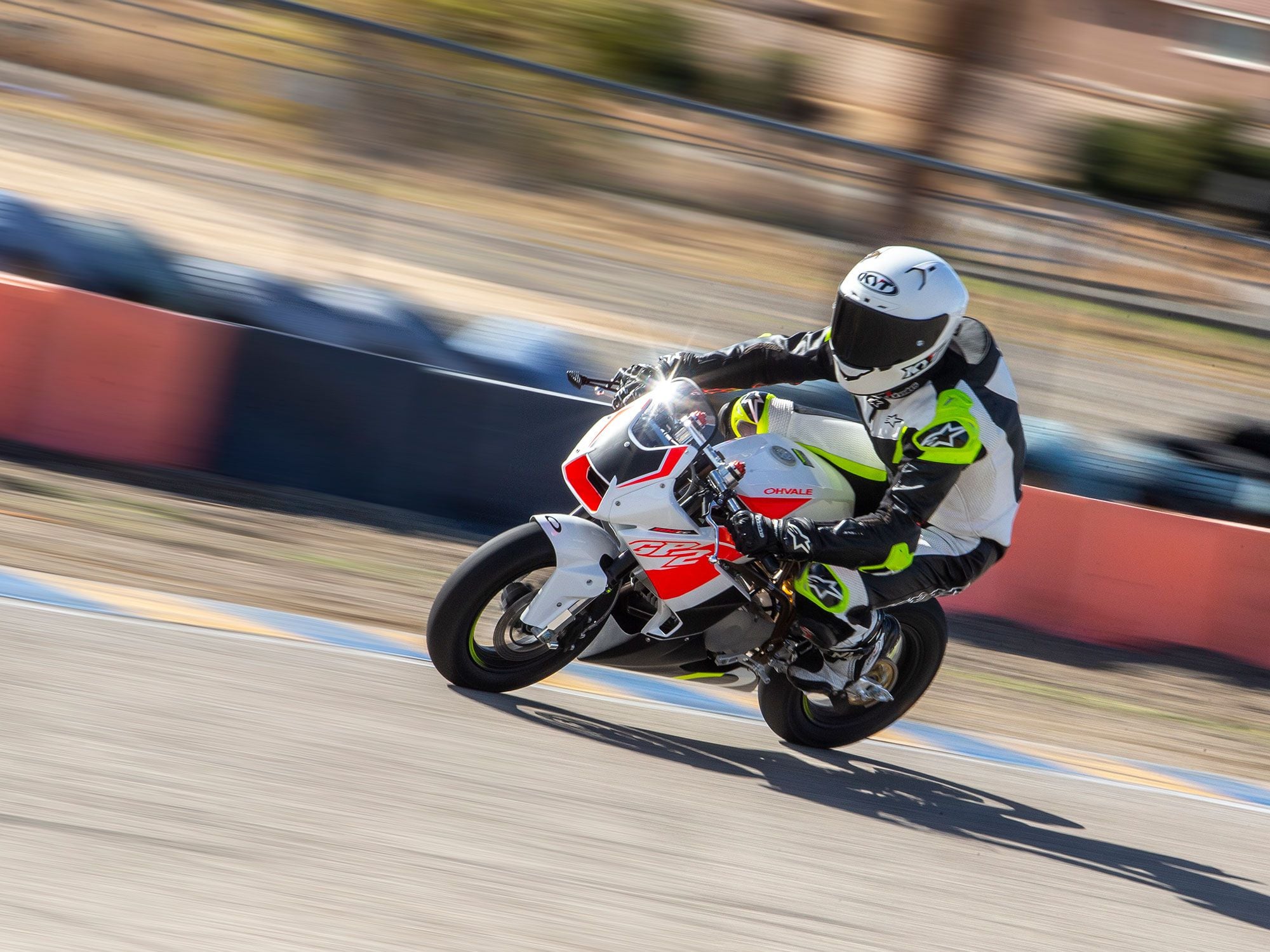
Stopping comes quickly on the GP-2 190 via the J.Juan radial front caliper, but consider it only weighs 167 pounds fully fueled. (Jeff Allen/)As invaluable as riding experience and skill set development are, the Ohvale isn’t cheap. Rise Moto, the US Ohvale importer, offers the GP-2 190 at a starting price of $6,499. Our test unit settles in just below $8,600, with accessories including the fully adjustable 38mm fork with Mupo internals, EVR slipper clutch, Alfano LCD dashboard with GPS lap time functionality, and Acerbis brake lever guard. Racer dads, relax—the even-more-junior-sized GP-0 110 Automatic retails for $4,099 while the popular GP-0 160 is $4,899.
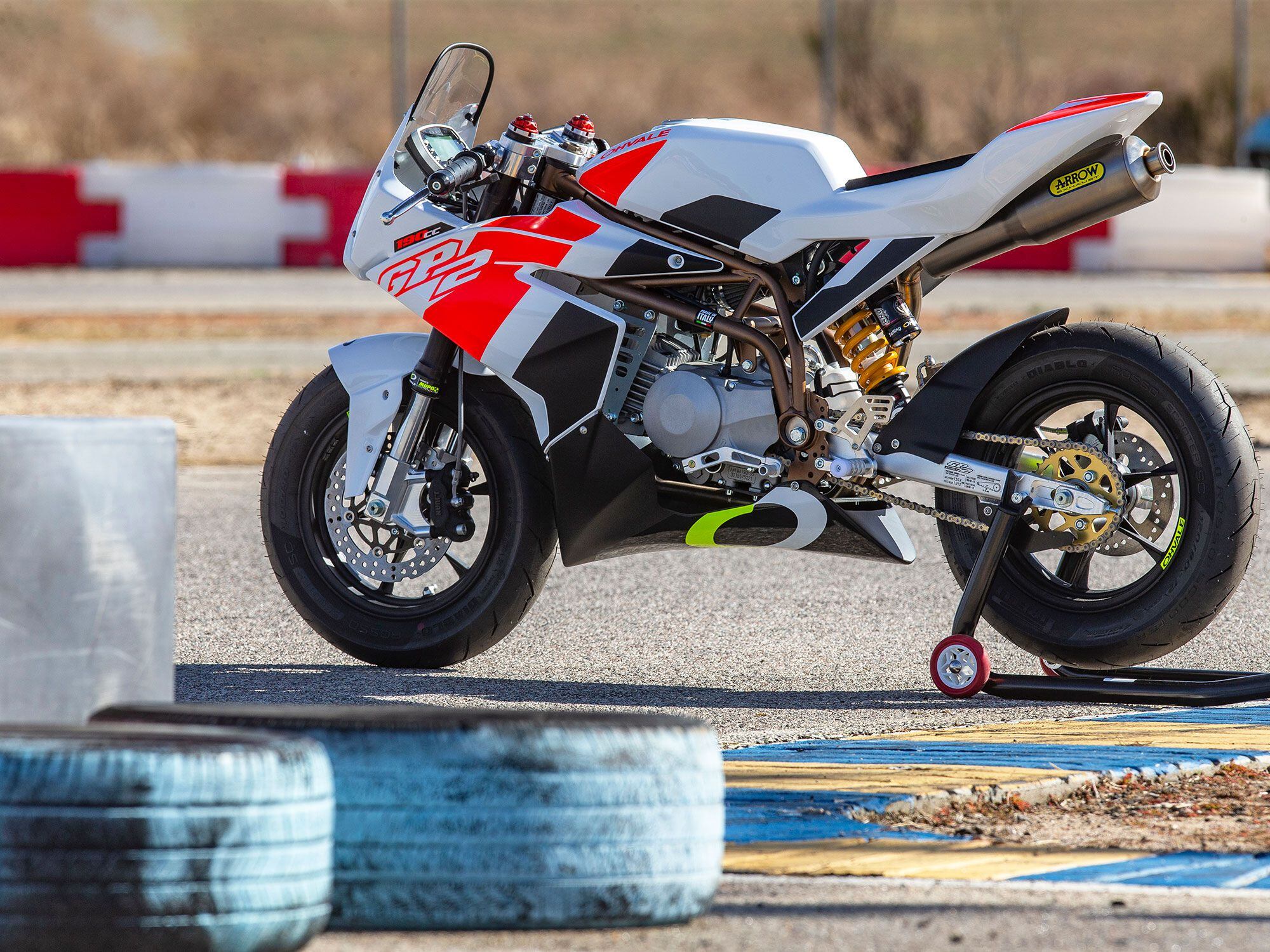
The Ohvale GP-2 190 is a scaled-down racebike capable of providing invaluable riding experience, but comes at a steep cost. It retails for $6,499 through Ohvale’s US importer, Rise Moto. (Jeff Allen/)Still, there’s something charming about the Ohvale GP-2 190. It’s focused in a way that most minimotos are not, because it isn’t one. It simultaneously offers true education and entertainment while looking and feeling the part of a true scaled-down racebike. Having become addicted to the Ohvale after only a few laps on it as a 24 year-old, I can only imagine what my parents would have had to do to pull me off of it.
2021 Ohvale GP-2 190 Specs
MSRP: $6,499/$8,600 as tested Engine: 187cc air-cooled single-cylinder Bore x Stroke: 62.0 x 62.0mm Transmission/Final Drive: 4-speed/chain Claimed Horsepower: 25 hp Fuel System: 28mm Keihin carburetor Clutch: Wet, multiplate Frame: Tubular steel trellis Front Suspension: 38mm inverted fork w/ fully adjustable Mupo internals (as tested) Rear Suspension: Monoshock w/ piggyback, fully adjustable Front Brake: J.Juan 4-piston, radial-mounted caliper, 220mm disc Rear Brake: 1-piston caliper, 180mm disc Wheels, Front/Rear: Aluminum alloy; 12 x 2.5 in. / 12 x 3.0 in. Tires, Front/Rear: Pirelli Diablo Rosso Scooter SC Seat Height: 27.6 in. Fuel Capacity: 0.9 gal. Cycle World Measured Wet Weight: 167 lb. Availability: Now Contact: risemoto.com -
Hello durnf,
Welcome to The Motorbike Forum. Please feel free to browse around and get to know the others. If you have any questions please don't hesitate to ask.
Why not tell us a bit about yourself too.
-
Hello jamiegl1800,
Welcome to The Motorbike Forum. Please feel free to browse around and get to know the others. If you have any questions please don't hesitate to ask.
Why not tell us a bit about yourself too.
-
Hello Aubrey Dawson,
Welcome to The Motorbike Forum. Please feel free to browse around and get to know the others. If you have any questions please don't hesitate to ask.
Why not tell us a bit about yourself too.
-
Hello WD40,
Welcome to The Motorbike Forum. Please feel free to browse around and get to know the others. If you have any questions please don't hesitate to ask.
Why not tell us a bit about yourself too.
-
-
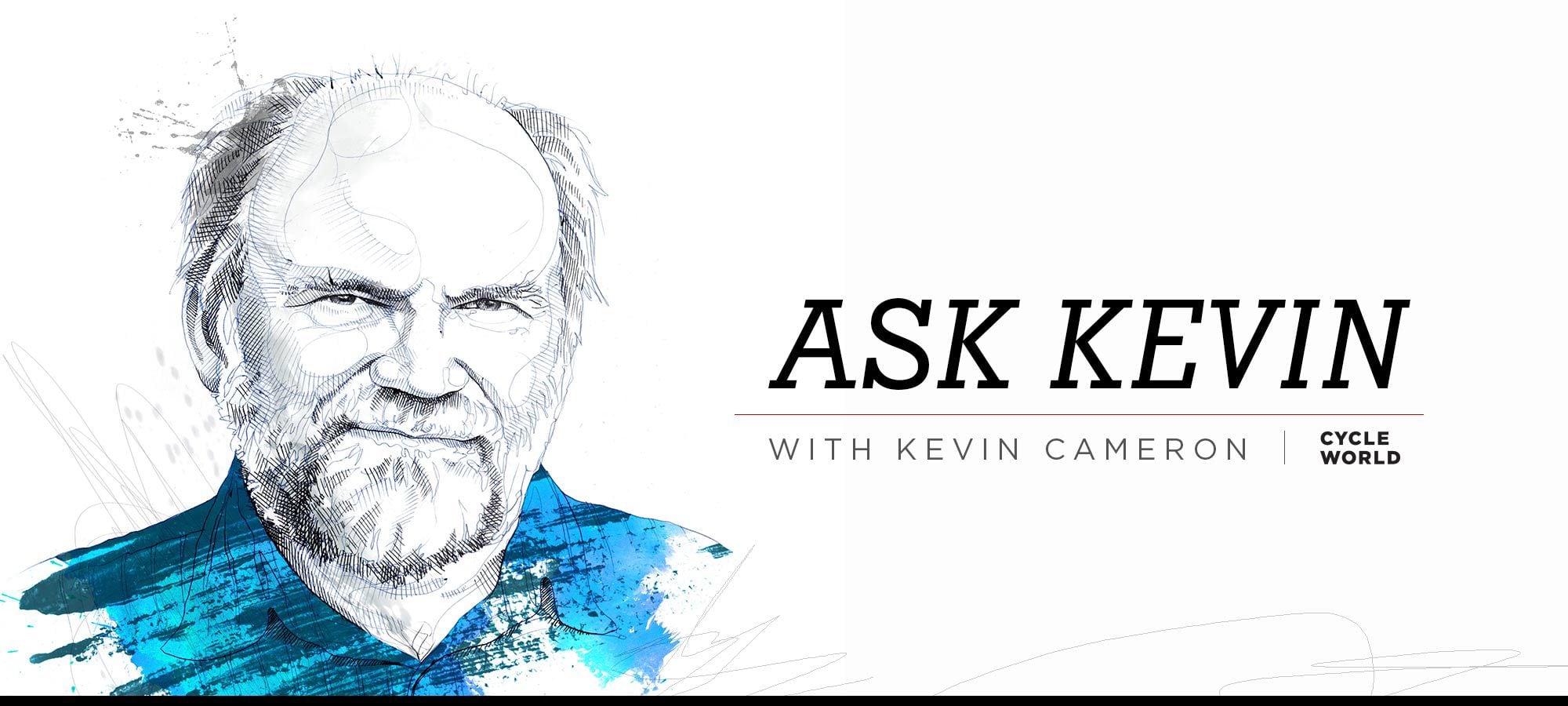
The benefits of light weight and simplicity in racing motorcycles. (Robert Martin/)Walking down from the shop last night I was humming The Beach Boys’ 1963 hit “Little Deuce Coupe” when I became curious about the relative weights of that famous coupe and the Thunderbird mentioned in the song. A few keystrokes later and I’d found that the T-Bird outweighed the coupe by around 40 percent. No wonder that “When somethin’ comes up to me, he don’t even try…”
As anyone who’s ever played around with rockets and other things that accelerate knows, the rate of acceleration is the thrust divided by the mass of the vehicle. Reduce the mass by 40 percent while keeping the thrust the same, and the result is that the deuce coupe accelerates 40 percent faster with equal power.
As soon as Detroit realized that Americans in the mid-to-late 1960s would buy thousands of factory hot rods, people mostly stopped building or even thinking about hand-built street coupes weighing 2,200 pounds. Machine shop, fab, and welding skills required? Forget that! Installment plan, here we come! Detroit was soon cranking out 7-liter monsters that could move mountains, which is just what those giant pressed-steel “lumber wagons” were.
Yet weight remains as important as ever. If your bike with you on it weighs 600 pounds, and its engine makes 150 hp, that’s a power-to-weight ratio of 600/150 = 4 pounds per horsepower. That in turn tells us that the 4-pound pair of boots on your feet is costing you one whole horsepower. One whole horsepower is required just to accelerate those boots, while the other 149 get on with the big picture.
In the early 1980s the weights of big-engine bikes had bloated their way toward 600 pounds, so Suzuki’s very light, original GSX-R750 was a dead cert to leave them behind, which it did. Weight crept up again, so Yamaha’s release of the first R1 literbike, hailed as “feeling like a 250,” taught the same hard lesson over again: Acceleration is the thrust divided by the weight.
My doc (and any bike I might ride) wants me to weigh 167 pounds instead of my actual 200—a difference of 33 pounds. If every 4 pounds of weight reduction is equivalent to a horsepower, that’s like a gain of 8.25 hp. That makes me remember other terrible numbers. The four smokestacks on Yamaha’s two-stroke RZ500 four weighed 42 pounds! Later, when titanium pipes hit Supersport, I was handed a complete four-cylinder system, muffler included: 6 pounds! That’s a difference of 36 pounds.
Weight growth affects air forces too. Here, let’s build a large number of small and inexpensive but extremely agile lightweight fighters. Then the process begins. Why limit ourselves to that tiny radar? Put on this larger array. Except that increases fuselage diameter, drag, and weight. It also sucks more electricity, so now we need more generator pads on the engine(s). Growing weight shortens range, so we have to fill every empty space with fuel, plus valves, lines, and pumps. Gosh, now we need to beef up the landing gear, and our airplane is starting to handle like what it’s becoming—an air tanker. No problem! An enlarged wing and bigger control surfaces will fix that right up. Hm, takeoff distance is growing because acceleration is dropping, so now we need a serious thrust increase from the engine…
It doesn’t end until someone with the authority to change things pulls up a fresh screen and says, “Do it over. From the beginning. Get it right.”
I was also impressed by the big differences in approach to racing motorcycle design in the 1950s. The English wanted more than anything else to win the Isle of Man TT, so they built engines and chassis rugged enough to finish the seven 37.5-mile laps. Speeds were generally high, so wheelbases tended to creep up, and engines were biased toward peak power (nothing below 5,500 rpm, all done at 7,000). Meanwhile at Guzzi, engineer Giulio Carcano, charged with winning the 350 GP championship over a variety of European tracks, some quite twisty, designed for acceleration. His engines featured wide torque ranges and his bikes weighed as little as 216 pounds. Guzzis took five successive 350 titles, 1953–1957 inclusive.
Around 1980 Honda’s Shin’ichi Miyakoshi, impressed that the lap time difference between 500s and 250s in European GPs was small, thought about the idea of a 100 hp 250: “What if we built a bike with the weight and agility of a 250 and the power of a weak 500?” They built it and Freddie Spencer rode it. In 1982, at the very fast Belgian Spa circuit, his 108 hp Honda topped the Yamaha and Suzuki opposition, all making 25 percent more power. Freddie’s lap times showed that their extra power was just waste heat. A year later he was 500cc world champion.
Weight is just one of a great many motorcycle variables, but if we don’t watch our motorcycle’s diet, weight creeps up and performance is lost. Remember: Acceleration equals thrust divided by the weight.
-
-
Hello Laoconte,
Welcome to The Motorbike Forum. Please feel free to browse around and get to know the others. If you have any questions please don't hesitate to ask.
Why not tell us a bit about yourself too.
-
-
Hello fuelstopchats,
Welcome to The Motorbike Forum. Please feel free to browse around and get to know the others. If you have any questions please don't hesitate to ask.
Why not tell us a bit about yourself too.
-
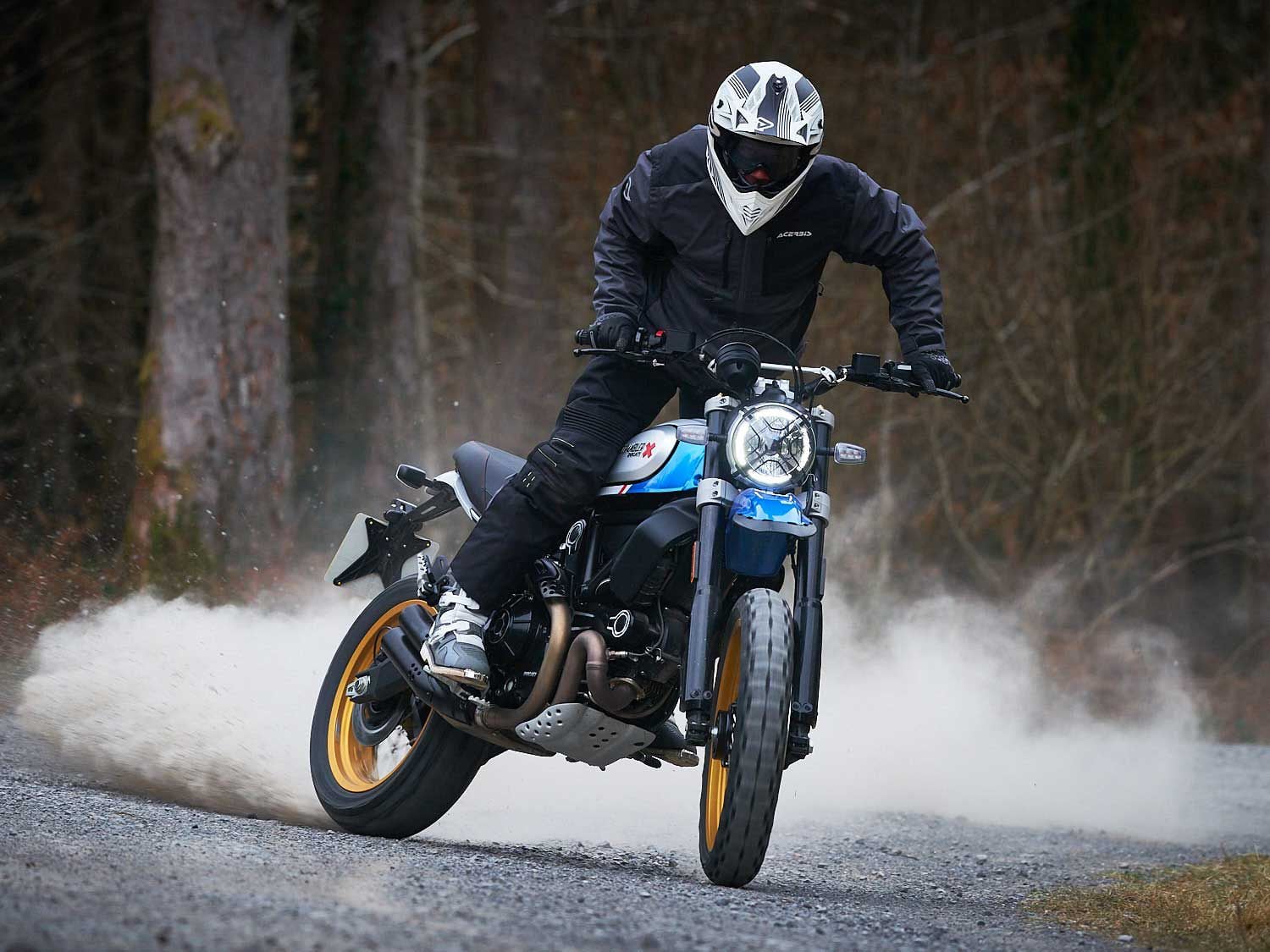
Off-road chops make the Desert Sled a standout in the Ducati Scrambler line. (Oli Tennent/)The retrobike scene is as strong as ever, with pretty much every manufacturer from Triumph to Kawasaki digging up heritage stories and building classically styled bikes to match. But the best thing about the current wave of retrobikes is that the sacrifice in performance for style is becoming less and less pronounced. And while the Ducati Scrambler Desert Sled would be hard work to actually race across a desert, it does have some genuine off-road capability.
The fully adjustable Kayaba fork and preload/rebound-adjustable shock both have 7.9 inches of travel, and with more than 9 inches of ground clearance, you can tackle some decent terrain without tearing a hole in your cases. And sure, a 21-inch front wheel would be better off-road, but the spoked 19/17-inch wheel combo is a proven adventure bike setup for striking a balance between dirt and asphalt.
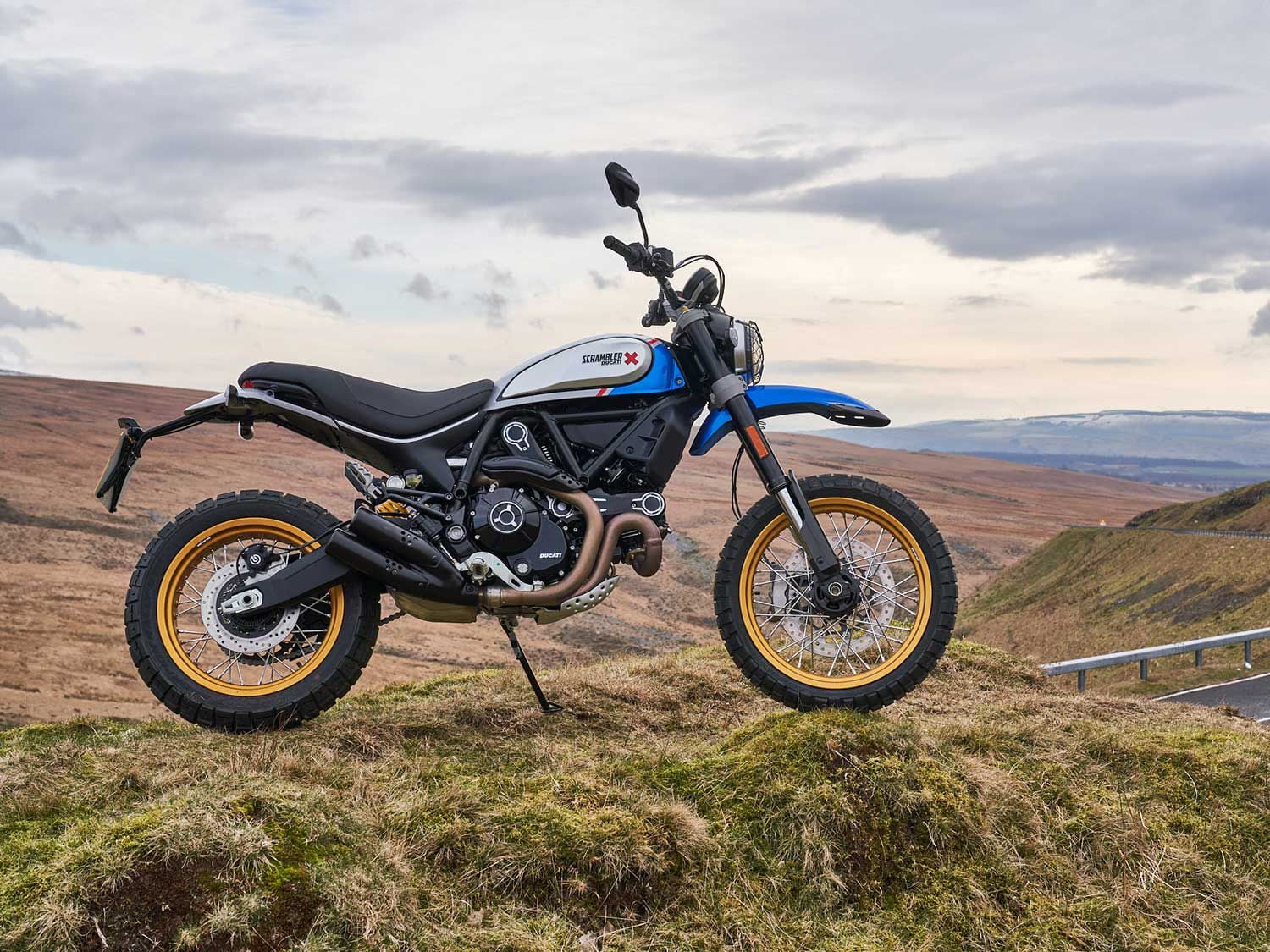
Offering 7.9 inches of suspension travel at both ends gives the Desert Sled the ability to venture off the pavement. (Oli Tennent/)Equally important as ground clearance and suspension is riding position; no amount of travel will make up for ergonomics that don’t work when you’re standing up. Thankfully the Sled works well; it feels a little wide, particularly if you’ve just stepped off a dirt bike, but the bars are a good shape and well-positioned for standing operation. The only weak point here is down by your feet; the pretty aluminium footpegs look nice, but even with the rubber removed they’re slippery, especially when mud and water get involved.
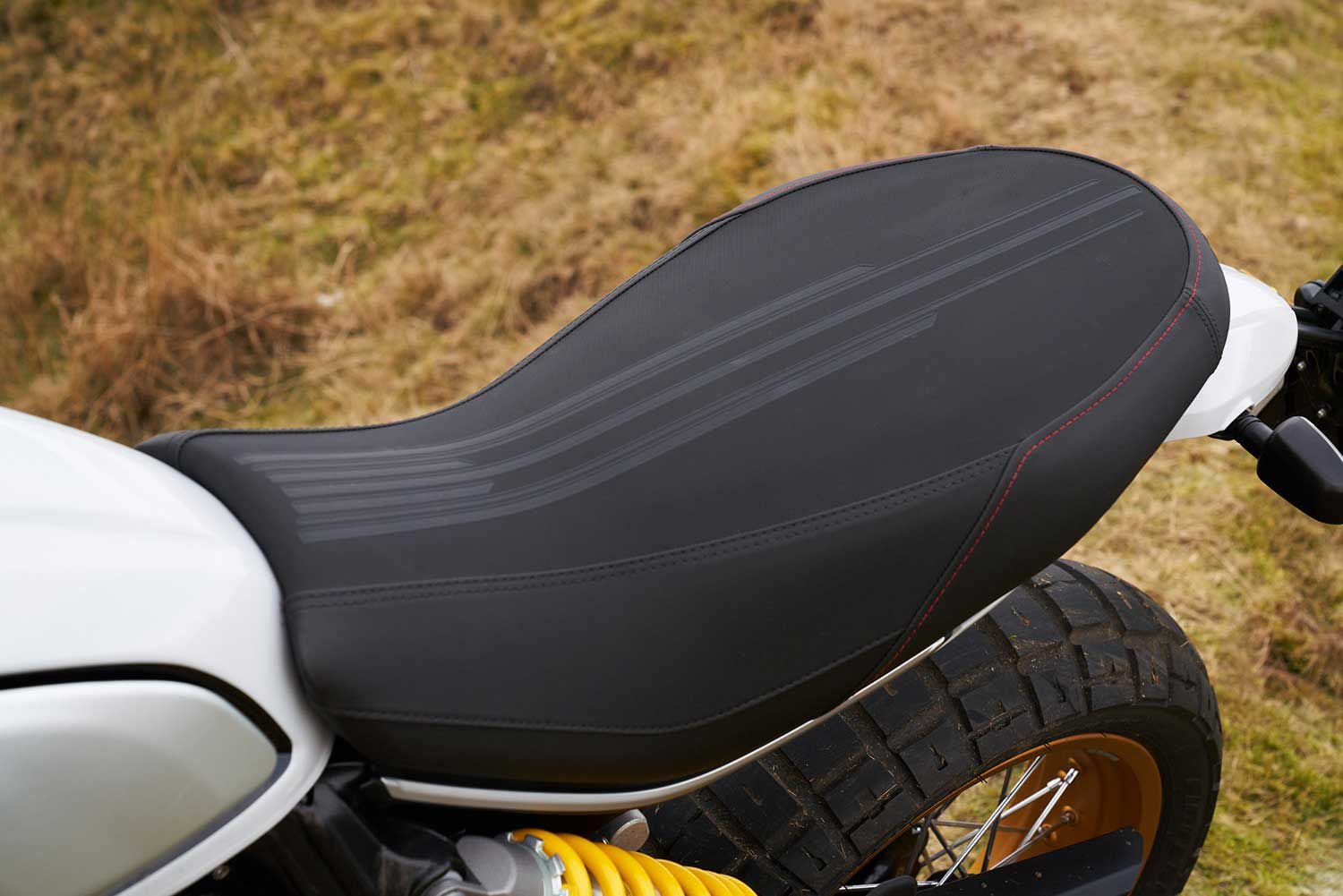
The Scrambler Desert Sled’s new seat sits at 33.9 inches above ground; there is a 33-inch option for those looking for a short reach. (Oli Tennent/)But enough number crunching; take a look at that new paint scheme. Changes to the new Desert Sled don’t really go much further than a new seat and new colors, but when the colors are this good, does that matter? This is definitely one of those bikes that looks even better in the metal and keeps looking better the longer you look at it. It’s a neat-looking bike too; not just neat as in “nice,” but neat as in “Marie Kondo would be proud of the lack of clutter and plumbing around the motor.” That’s obviously helped by the oil-/air-cooled L-Twin, which does away with the radiator and associated coolant hoses. But even aside from the benefits of the old-school cooling methods, the side view of the bike is pleasantly free from dangling wires and ugly sensors. And while there’s plenty of scope for customization and tuning, there isn’t much about the standard bike that could be considered awkward or out of place.
There are now nine different Scrambler models available, two 1,100cc versions and seven 803cc bikes. There has to be a Disney remake in there somewhere. The seven dwarves have had a Nu-Wave Metal rebranding and are now called Icon, Icon Dark, Nightshift, Café Racer, Desert Sled, Full Throttle, and Sixty2. Think Snow White, as played by Shayna Texter, facing off against her wicked stepmother, played by Sammy Halbert in a wig, in a mile-oval race on reasonably priced Italian streetbikes.
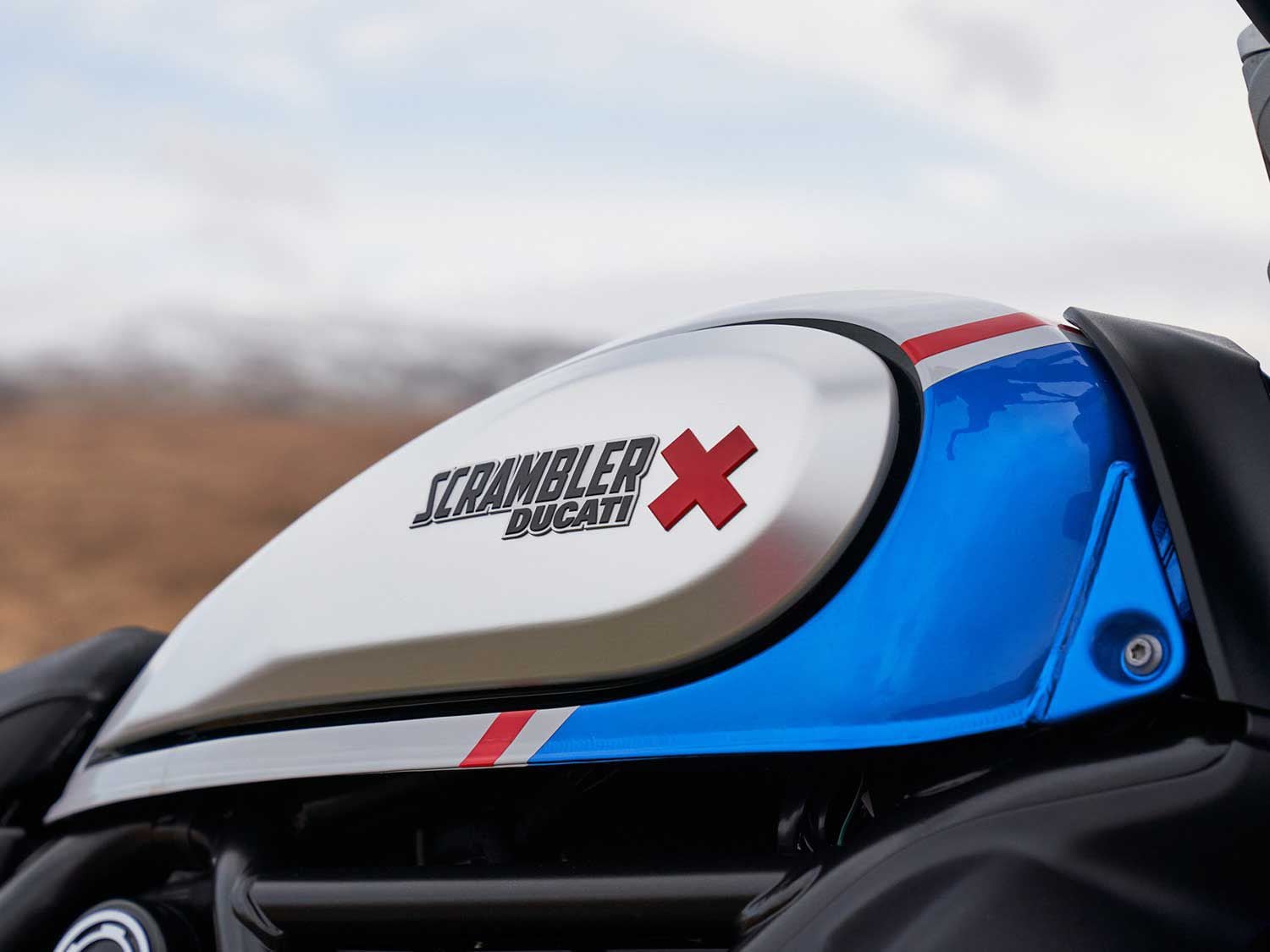
The new paint scheme of the Desert Sled is light and bright. (Oli Tennent/)The Desert Sled rumbles into life with that familiar slow cranking that sounds like the battery is going flat; don’t worry, sir, they all do that. The simple digital speedometer manages to pack in a decent amount of usable functionality, with on- and off-road riding modes called Journey and Off-Road respectively. In Off-Road mode the ABS system can be switched off to unlock “skid mode”—Ducati doesn’t actually call it that, but it definitely should. The minimalist dash is compatible with the Ducati multimedia system, allowing riders to control music with a smartphone and even use handlebar-mounted switch gear to answer calls. Better still, it can be used to reject calls with voicemail messages set to “Can’t talk; busy being awesome.”
Like each of the seven different 803cc Scramblers, the Desert Sled is an easy bike to ride. For those who like to get both feet flat on the floor at a stoplight, the tallish 33.9-ich seat can be swapped for an accessory 33-inch option, but other than that the Sled is hardly an intimidating bike. The clutch is light, the throttle is soft, and the engine resistant to stalling at low speed. For newer or less confident riders, it’s a dream, allowing the rider to get on with looking cool and racking up miles of experience and fun. That doesn’t mean no fun for more enthusiastic Sledders; it just means all the slow-speed stuff is a doddle, including wheelies, spin turns, skids, and any other parking lot antics you fancy.
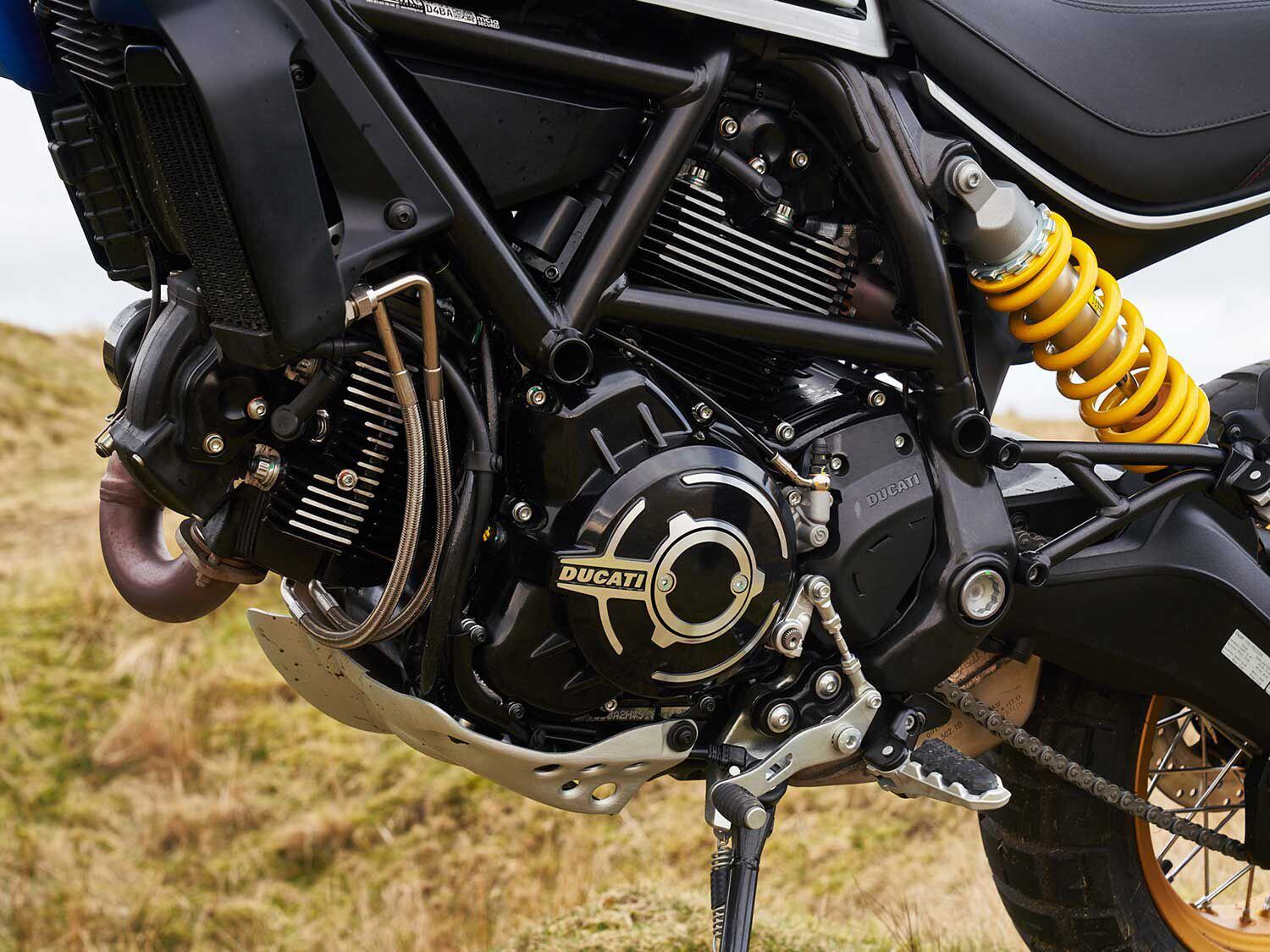
The 803cc air-cooled engine of the Desert Sled has enough power to be entertaining without being overwhelming for newer riders or too aggressive in nasty off-road situations. (Oli Tennent/)On the road, the Sled is great fun in a relaxed kind of way. The 73 hp engine is never going to set your world on fire in a straight line, but it has plenty of go for cruising and enjoying twisty roads. Thrashing it up and down the gears, skidding into turns, and firing out into the straights is fun in its own way, but other bikes are better for this style of riding, not least Ducati’s own Hypermotard. The chassis follows the chilled-out theme: It doesn’t dart into an apex like a sportbike, but neither does it require 100 yards of persuasion to make a turn, like a big raked-out cruiser. Wide handlebars let you throw it around, flicking easily between turns, and the chassis follows obediently without shaking its head or resisting. Sitting down, the bars feel high, like you’re sitting behind them; this makes swinging the bike from turn to turn even easier. The large single front brake is, you guessed it, effective without being intimidating; if you want to ride it flat out like a supermoto, you might want a touch more bite and power, but the rest of the time it follows the Scrambler’s theme: simple and effective.
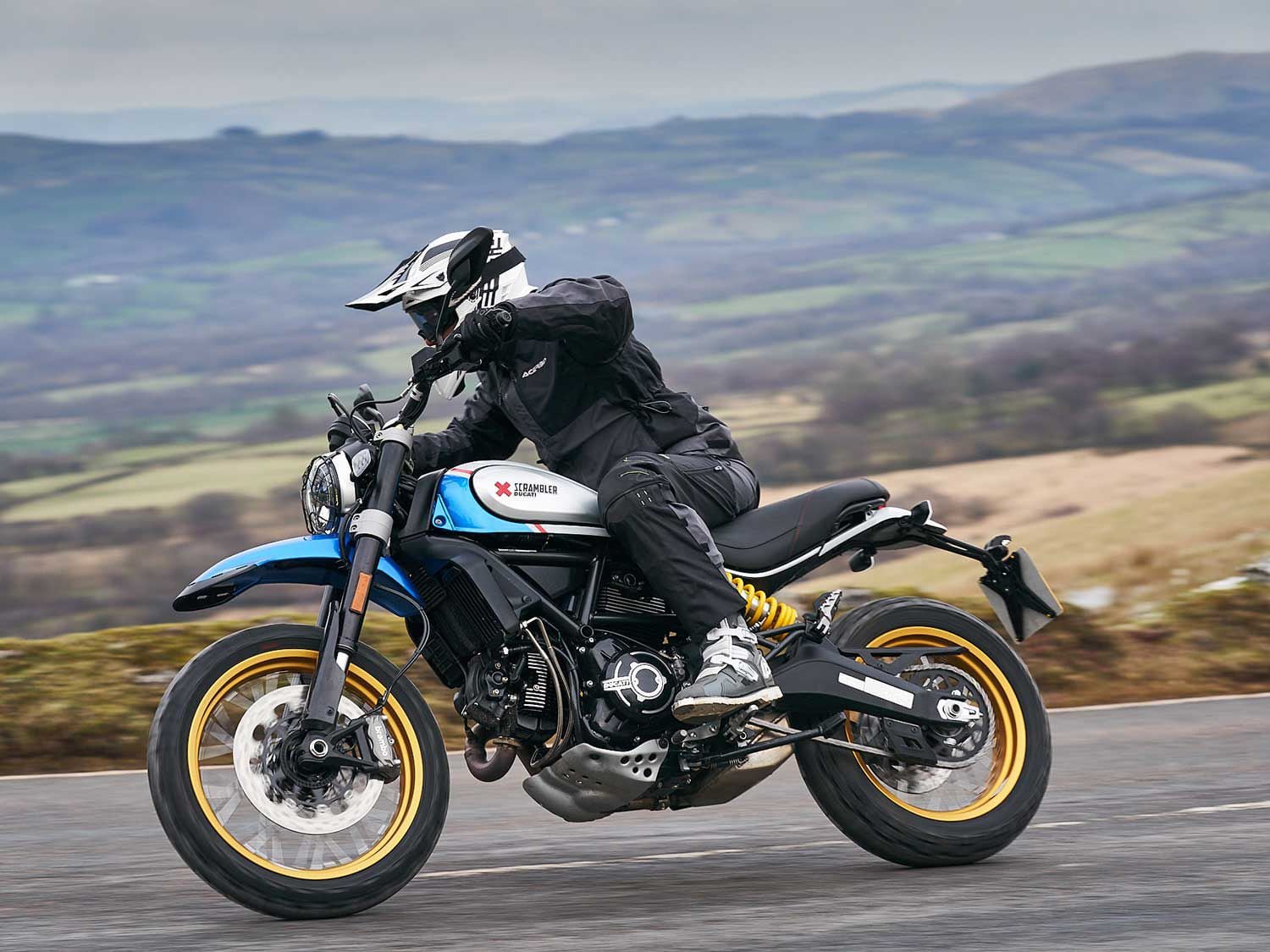
On the road, the Ducati Scrambler Desert Sled is a chilled-out ride—a sort of different take on mild adventure riding. (Oli Tennent/)Heading off-road really brings the Desert Sled to life. The easy low-speed handling and predictable throttle response translate into endless miles of powerslides and skid turns. A little more power would make off-roading even more fun, but the fact that you have to provoke it makes it perfect for all riders, not just the crazy ones. On flowing gravel trails the Sled is a great fun bike to play around on, with enough travel to soak up the occasional pothole as you carve through the countryside.
If you start turning up the speed and hitting larger obstacles, you get a sharp reminder from the rear shock that this is not a rally bike. Too much off-road speed doesn’t work on the Sled; try to hang with, say, the new KTM 890 Adventure R through the rough stuff and you’ll come unstuck from terra firma. But you’ll look cool doing it. The fact that I kept falling into the trap of riding it too quickly off-road speaks volumes about how well the Desert Sled does on the dirt; it’s too easy to forget that this is a streetbike first and off-road bike second. On more technical trails, the light clutch, decent clearance, and soft power delivery let you get the Desert Sled to places that no hipster-spec scrambler has any right to be.
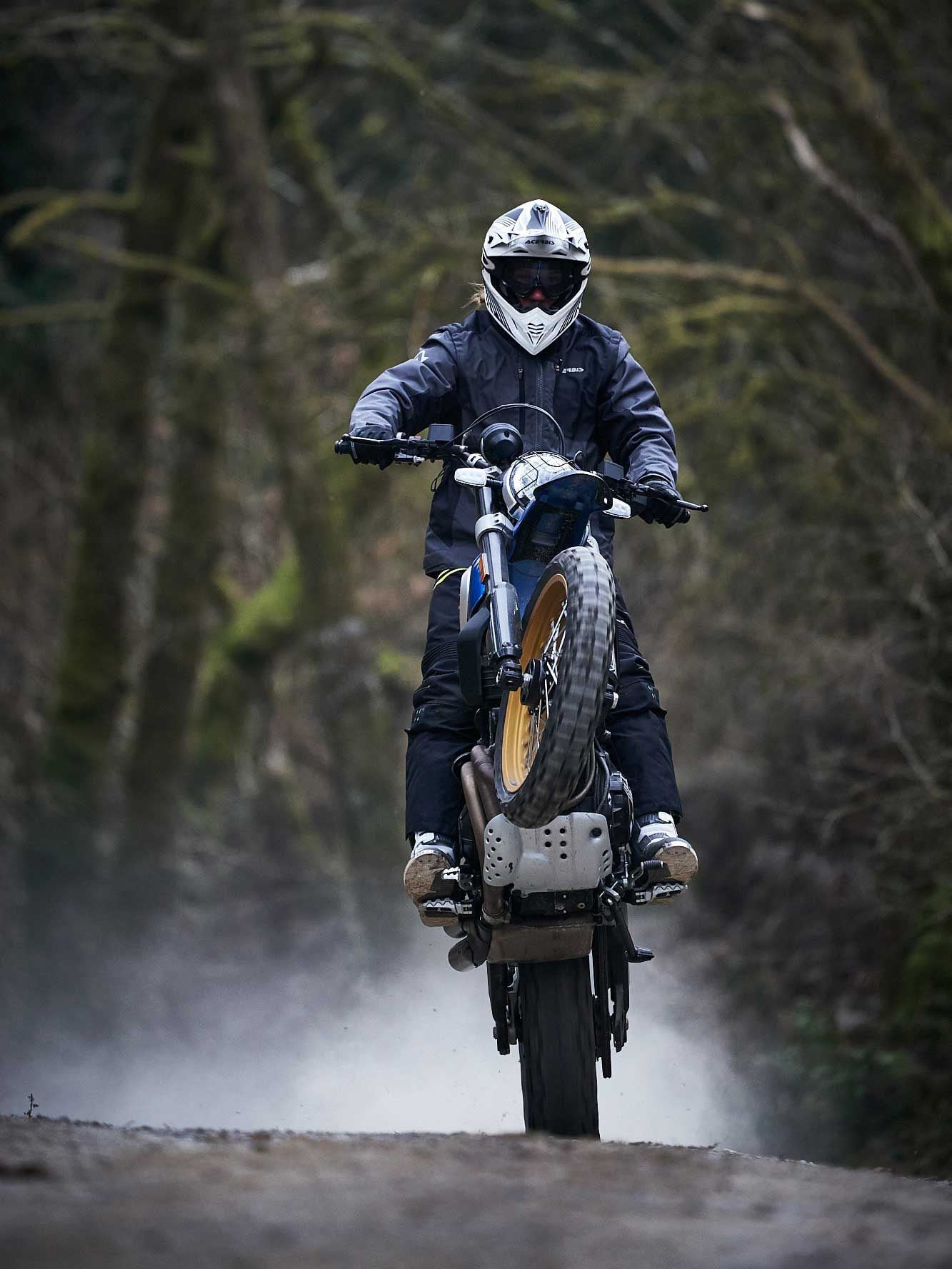
The Desert Sled is #Wheeliewednesday approved. (Oli Tennent/)Before riding the Desert Sled, my mind was split. It’s a stunning bike, ticking lots of the right boxes from the styling of dirt bikes I grew up wanting. The gold wheels from my Dad’s old XT350, the big fat, flat seat from ’70s Husky motocrossers; Ducati has been almost shameless in taking cues from the bikes of our youth. Still, the 44-pound weight gain over a Scrambler Icon and the 73 hp motor had me questioning whether I would find myself wanting more performance. But after a few tanks of gas, the Sled had really endeared itself to me.
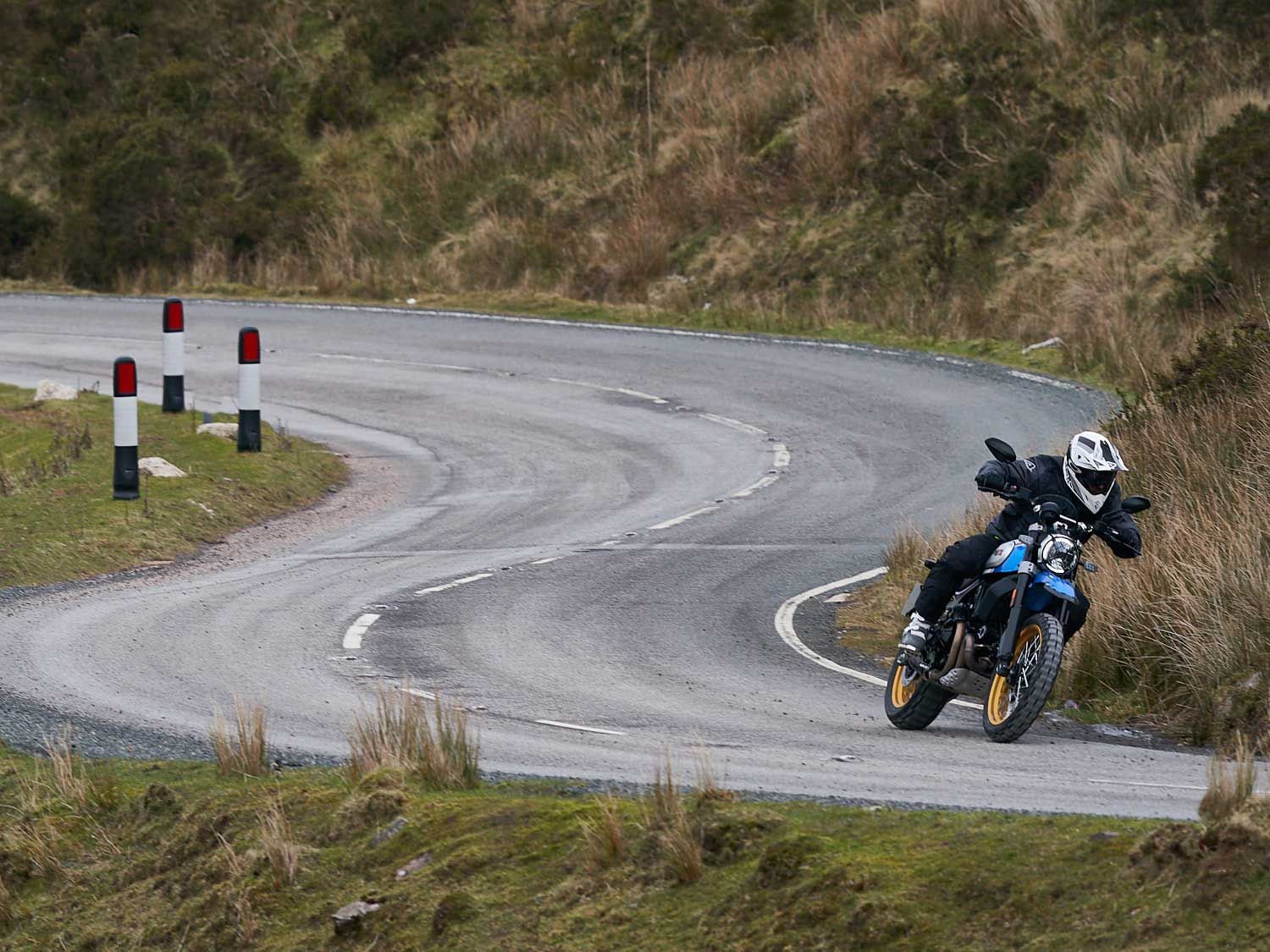
The Desert Sled is all about having fun, wherever you may be. (Oli Tennent/)It is not a bike for big adrenaline kicks and riding flat out. It’s a bike for having fun, for skidding along a gravel track just because you can, for riding up a mountain in the snow just for a laugh. When the update to the Scrambler range was announced, I was gutted that Ducati hadn’t yet released an 1,100cc version of the Desert Sled. I still think that bike would be awesome. But this 803cc version, with its new seat and fancy paint, makes perfect sense. At $11,995 it makes a great alternative to the swathes of big-screen, beak-sporting adventure bikes. It will tackle the same terrain and look good while doing so. Just make sure you befriend them so they’ll lend you a gallon of fuel to get back home.
2021 Ducati Scrambler Desert Sled Specifications
MSRP: $11,995 Engine: 803cc air-cooled L-Twin; 2 valves/cyl. Bore x Stroke: 88.0 x 66.0mm Transmission/Final Drive: 6-speed/chain Claimed Horsepower: 73.0 hp @ 8,250 rpm Claimed Torque: 49.0 lb.-ft. @ 5,750 rpm Fuel System: Electronic fuel injection w/ 50mm throttle body Clutch: Slipper and self-servo wet multiplate; hydraulically actuated Frame: Tubular steel trellis frame Front Suspension: 46mm USD fork, preload, compression, and rebound adjustable, 7.9 in. travel Rear Suspension: KYB shock, preload and rebound adjustable, 7.9 in. travel Front Brake: Radial 4-piston caliper, 330mm disc w/ Bosch Cornering ABS Rear Brake: 1-piston floating caliper, 245mm disc w/ Bosch Cornering ABS Wheels, Front/Rear: Spoked aluminium; 19 x 3.0 in. / 17 x 4.5 in. Tires, Front/Rear: Pirelli Scorpion Rally STR; 120/70R-19 / 170/60R-17 Rake/Trail: 24.0°/4.4 in. Wheelbase: 59.3 in. Ground Clearance: N/A Seat Height: 33.9 in. Fuel Capacity: 3.6 gal. Claimed Wet Weight: 461 lb. Availability: Now Contact: scramblerducati.com -
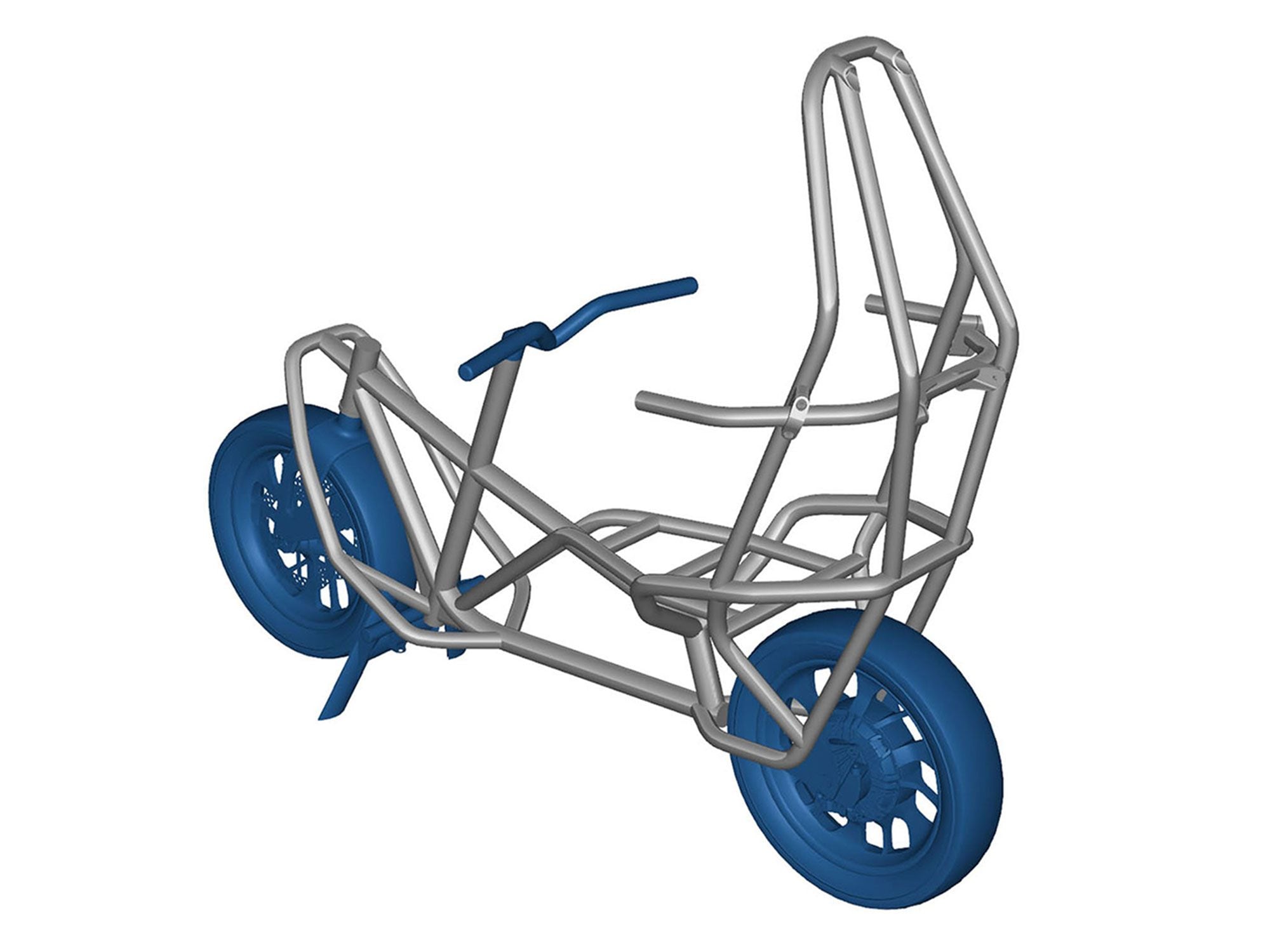
IP filings from Europe show BMW working on a new safety bike design. (BMW/)Providing crash protection for riders is something that’s usually left to clothing and helmet makers but BMW has long been one of the few companies to explore how bike designs themselves could mitigate injuries from accidents. Whether it’s the C1 scooter from the turn of the millennium, the Simple and Clever three-wheeled concept duo from the mid-naughts, or the carbon fiber, roofed electric bike that we revealed in BMW’s own patents last year, the Bavarian firm has long been trying to find a way to keep riders safe in the event of a crash. Only Honda has shown a similar level of interest in bike-mounted rider safety with its airbag-equipped Gold Wing and, a decade ago, long-since canceled plans for a VFR1200-based sport-tourer with a front crumple zone.
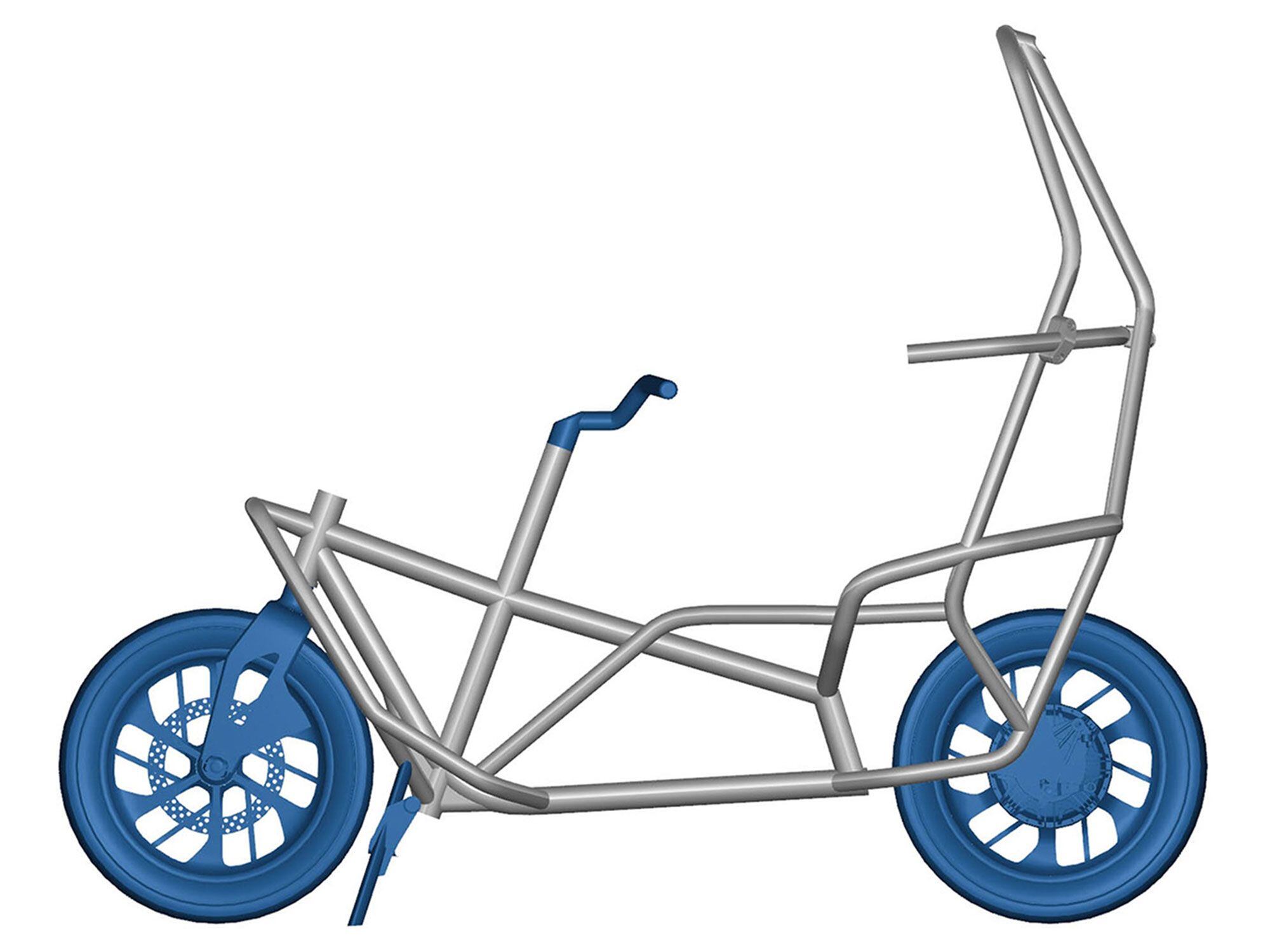
Unlike previous ideas, crash protection is provided by a roll cage arrangement rather than a full roof. (BMW/)The latest design to emerge from BMW’s R&D department once again pursues crash protection but dispenses with the idea of a complete roof, instead featuring a tubular roll cage around the rider’s back and head. However, there’s an even more fundamental rethink in the bike’s layout as the rider is moved backward, away from the most likely point of impact and allowing for a feet-forward riding position.
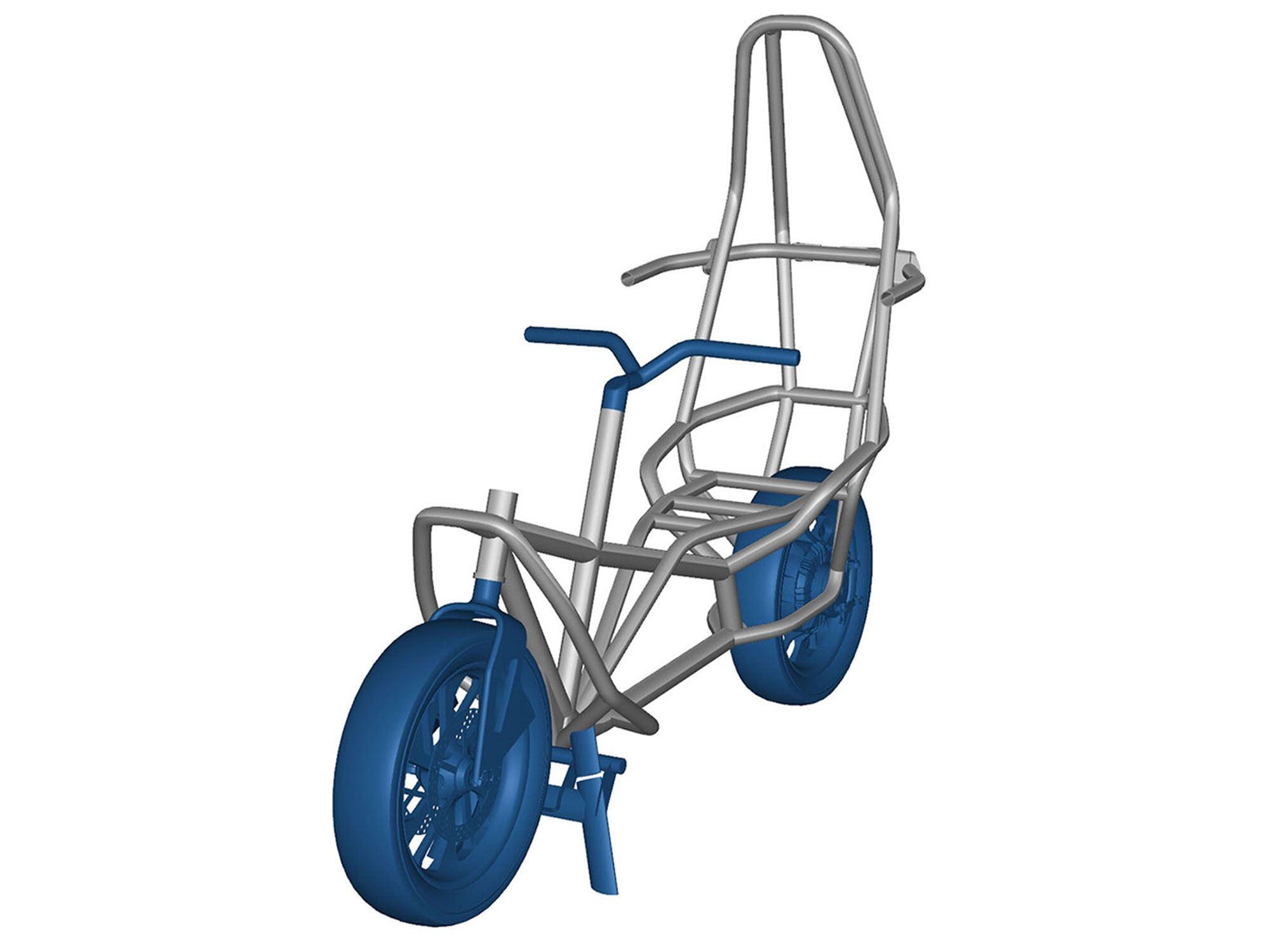
It appears the rider will be positioned farther back, with the handlebar connected to a second steering tube also situated aft of the fork. (BMW/)Unusually, these images haven’t emerged from a patent that protects technical elements of the layout, but from a European IP filing used to prevent the visual aspects of designs from being copied. Normally, you’d expect to see bodywork here, but in this instance the chassis is visually striking enough for BMW to want to protect its appearance.
To get the rider sitting as far back as possible, BMW has had to rethink the way the steering works. The bike features a front wheel gripped by what appears to be a cast alloy fork, presumably hiding a suspension spring and damper inside the steering head tube above it. However, the bars aren’t directly connected to the fork. Instead they’re atop a separate steering tube, parallel to the first but approximately a foot behind it. The designs don’t show how the two are connected, but presumably there’s a hidden linkage to make sure the front wheel turns with the bars.
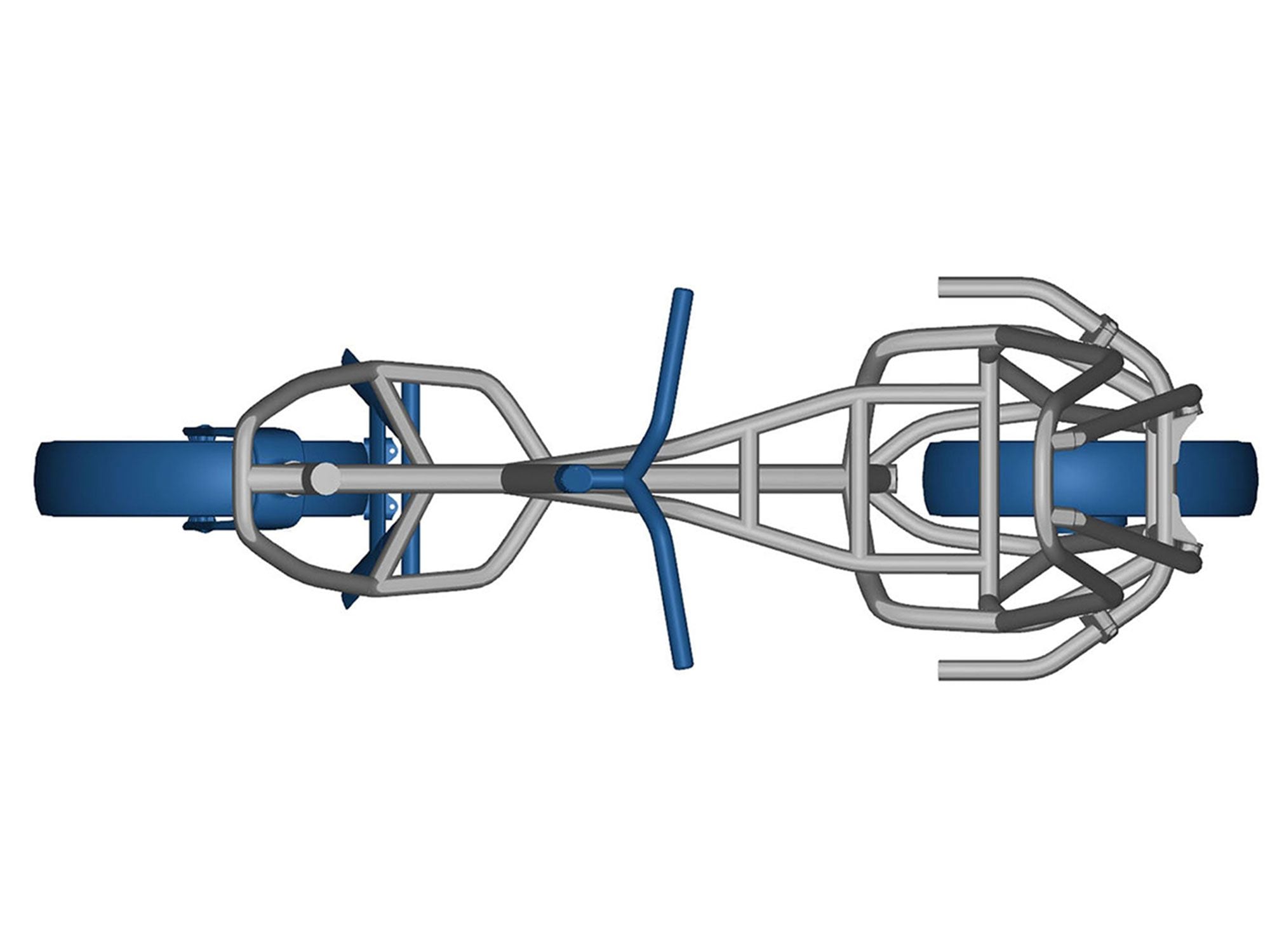
The secondary steering tube connects to the bottom of the frame, creating a stout front section ahead of the rider to absorb impacts. (BMW/)The secondary steering tube, which runs all the way to the bottom of the frame, creates a strong, triangulated front section of frame ahead of the rider, while his or her back and head are encased within the rear roll cage section. Although not shown, it seems certain that the idea would be to use a car-style seat, complete with belts to keep the rider in place in the event of an accident, while the elongated nose absorbs the shock of a head-on impact.
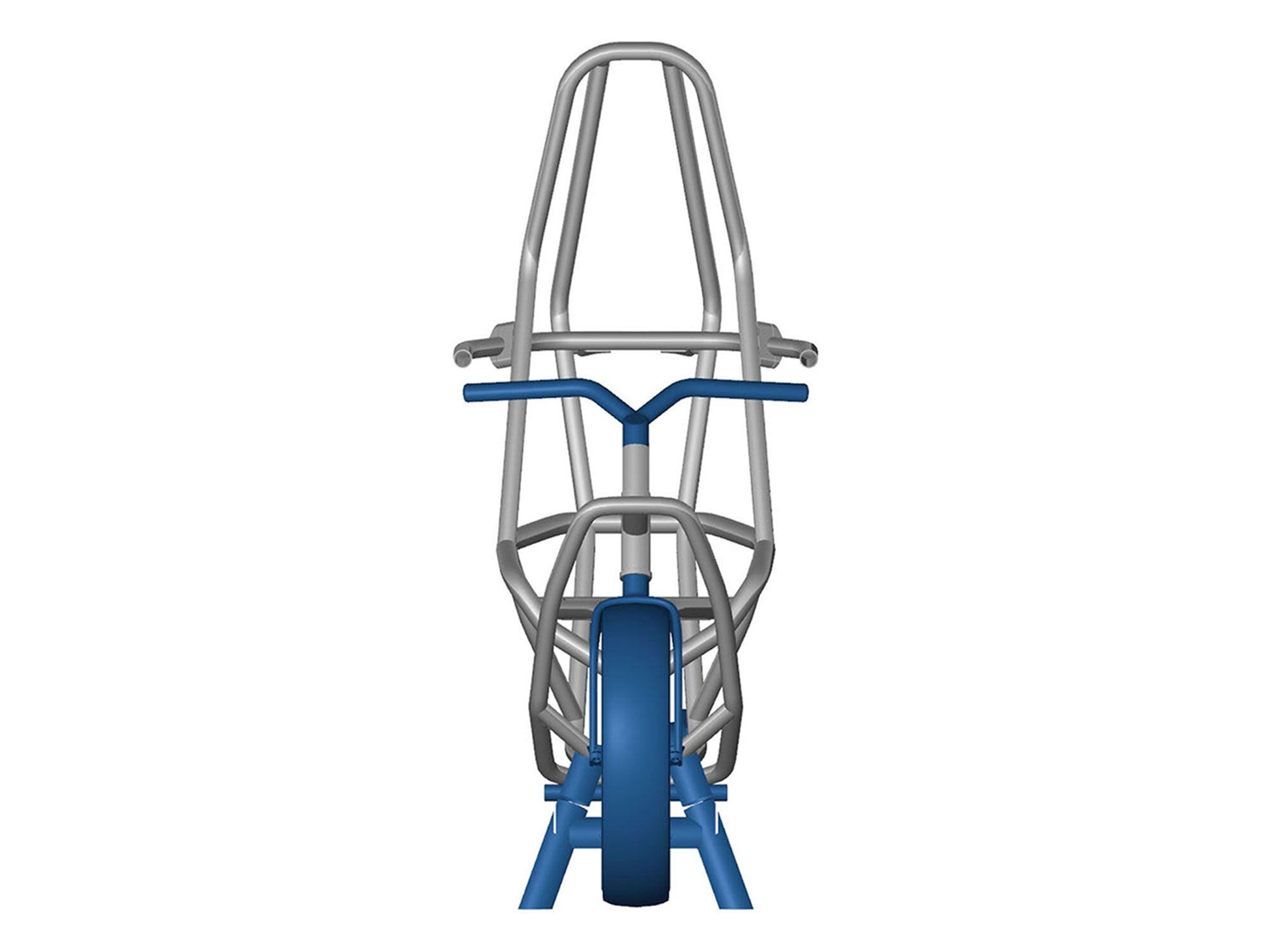
No seat is shown though we can envision a car-style unit taking up the space underneath the roll cage. (BMW/)Although the power unit is missing from the design, it’s likely that this is intended to be an electric, urban-focused vehicle. The rear wheel hub incorporates a unit that could be the back of a scooter-style, swingarm/transmission package, or it could be a hub-mounted electric motor. Either way it doesn’t look like there’s space in the frame for a conventional combustion engine and transmission to be sited between the rider’s legs.
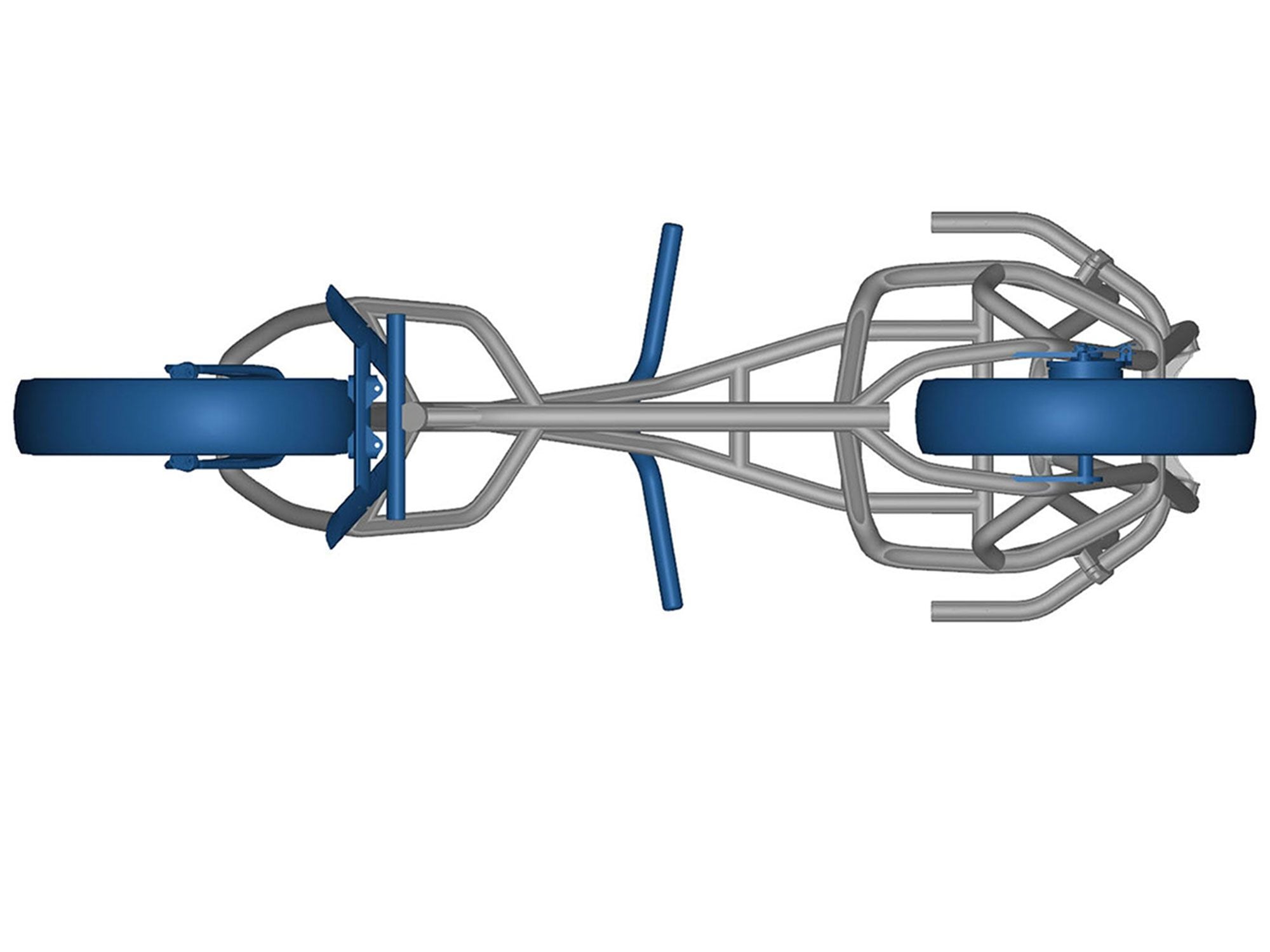
Given the layback design, it’s likely this will be intended as an urban mobility vehicle, possibly electric-powered. (BMW/)BMW is already committed to electric power, and last year registered trademarks for a whole range of electric bikes and scooters. The first of those trademarks has turned into reality with the unveiling of the near-production EC-04 scooter, but the Bavarians still have another related name, EC-02, in their trademark armory.
Intriguingly, BMW filed these designs with the EU Intellectual Property office back in August 2018 but requested that their publication be deferred until now. The implication is that the firm intended to officially unveil the machine using this design before now. It’s quite possible, indeed likely, that the design was to have been shown at an event in 2020 (perhaps the Intermot or EICMA motorcycle shows) that was canceled due to the coronavirus pandemic.
-
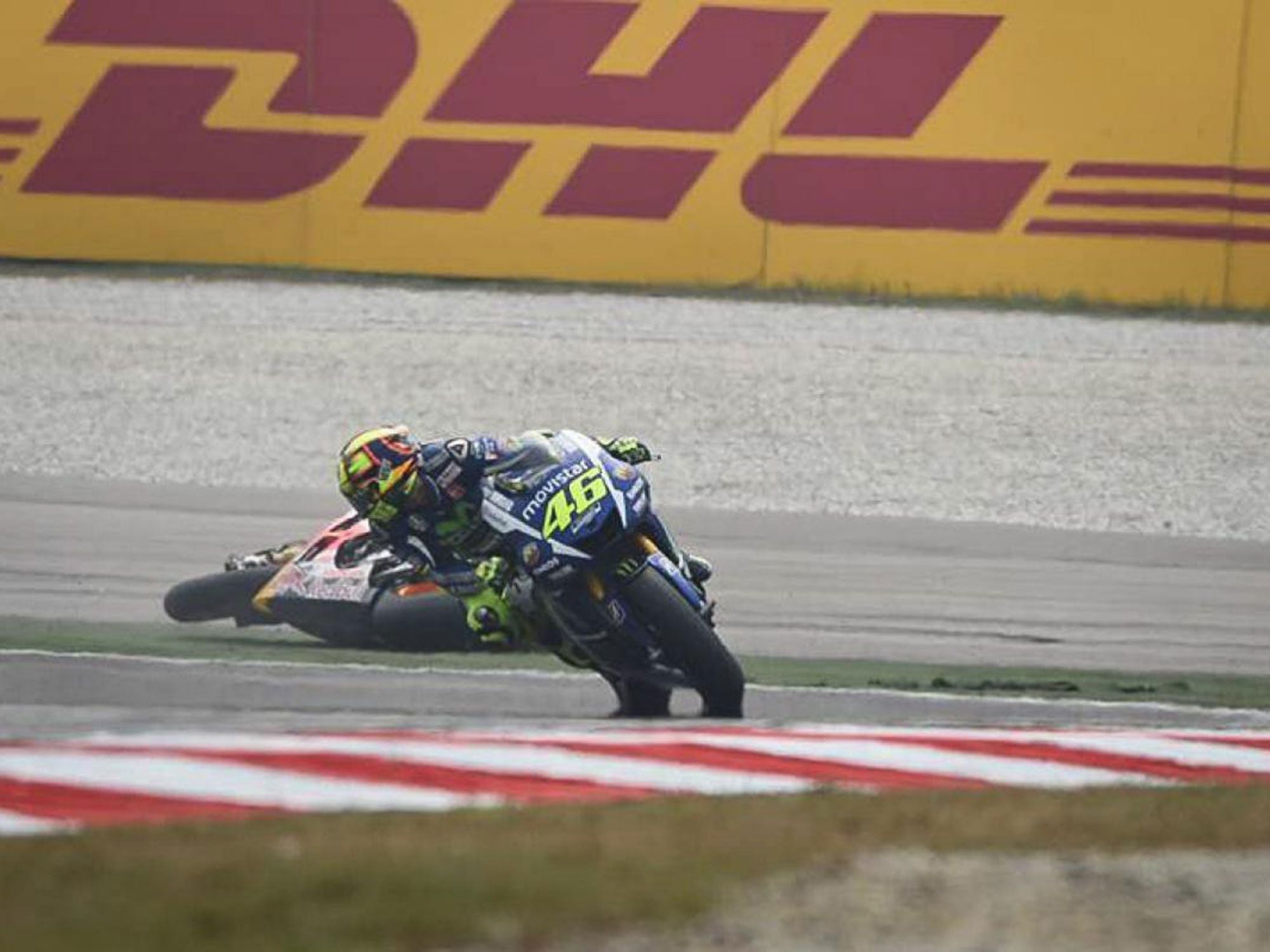
Did Valentino Rossi learn how to knock Marc Márquez down from Fast Freddie Spencer? Nick likes to think so. (MotoGP/)As told to Cycle World from an anonymous source:
Before YCRS, Nick Ienatsch instructed at the Freddie Spencer school. During the three-day schools the students and instructors would slide around on Honda XR100s. Fun was had by almost all. One day, a young 125GP racer named Valentino Rossi arrived to say hi to Freddie and wandered out to the dirt track to watch the action. Freddie rode over to where Vale was standing and they talked, watching the riders circulate.
Then Freddie drawled, “Hey! You wanna to see a funny trick?”
Of course Vale did.
Freddie kicked his XR to life and entered the track in an impressive broadslide, quickly closing on Ienatsch. As Freddie approached the hapless Ienatsch, he darted inside the slower rider’s line and then stood his bike up right into Nick’s front brake lever. A quick twitch of Freddie’s left knee and Nick’s front brake locked and down he went like a sack of untalented potatoes.
RELATED: Valentino Rossi Talks About Clash with Marc Marquez at Sepang
It wasn’t the first time the class had seen the trick played on Nick but it was still fun! Everybody laughed again and when Freddie returned to Vale the young Italian was choked with laughter.
Vale wiped his tears and asked, “Who iz zee pathetic rider who just fell?”
Freddie replied, “That’s Nick Ina-something.”
“Who? He is a terrible dirt rider!”
“Hah,” Freddie answered, “you think that’s bad, you should see him roadrace! Oh wait, here he comes.”
Nick arrived and said in his pouty voice, “Freddie, you just took me out!”
Freddie patted Nick’s muddy shoulder pads and said, “No I didn’t, you turned into me again.”
“Really? I did?”
Freddie nodded. “Yep, I was holding my line and you turned into me, knocking my foot off the peg and locking your front brake. Try to be more careful OK?”
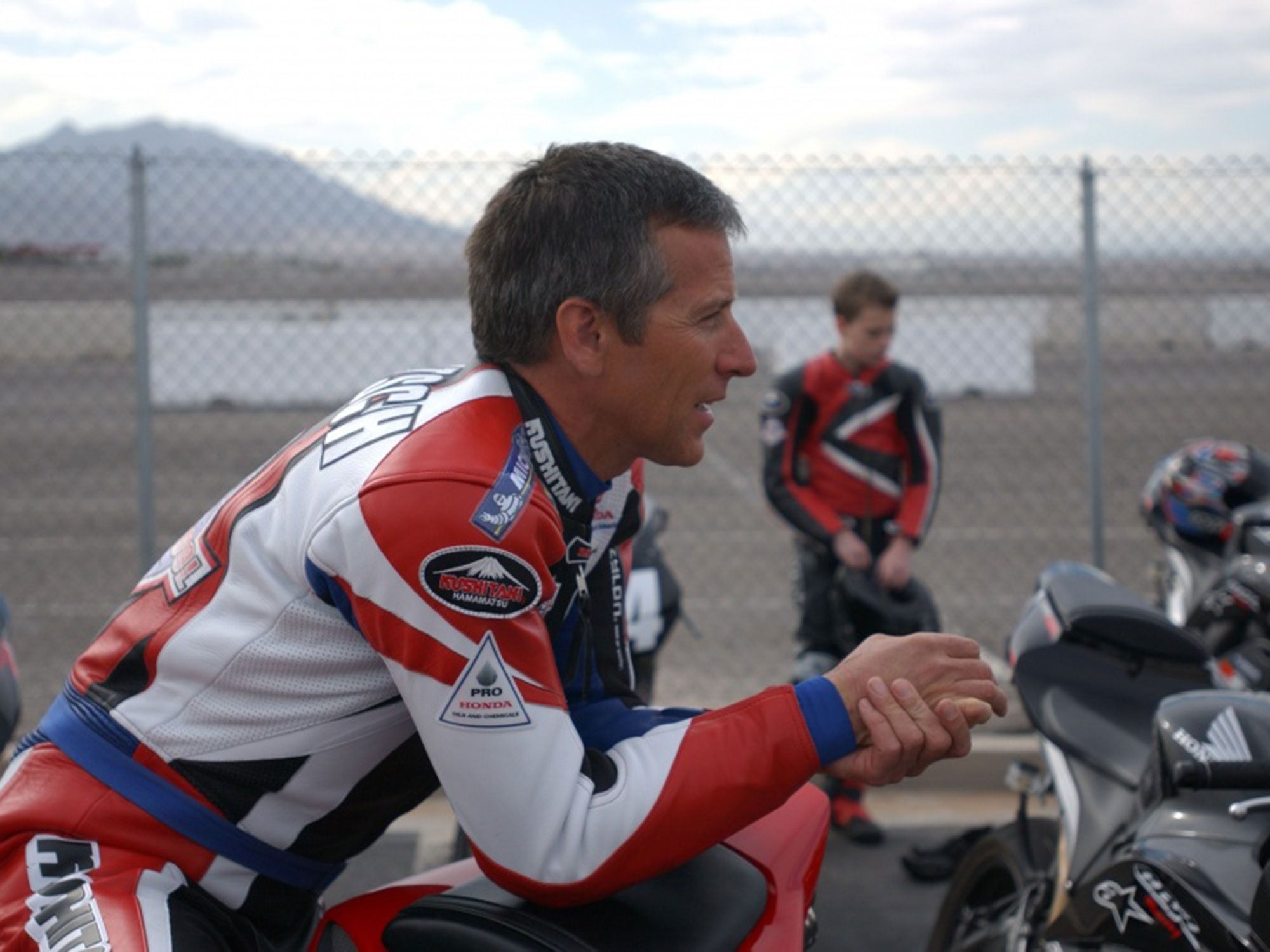
Ienatsch the day after dirt-tracking: “Yeah, I hurt my hand when I accidentally took out Freddie and Valentino.” A few years later, Marc Márquez would not see it this way. (Ienatsch Collection/)Nick apologized and wobbled off in first gear, at the limits of his ability.
“Hey,” the young Rossi asked Freddie. “Can I try?”
“Sure,” answered Freddie before yelling, “Hey Nick, keep lapping for a while!”
At least that’s how I imagined it all happened…
Understanding history is important when examining classic MotoGP moments like Sepang 2015.
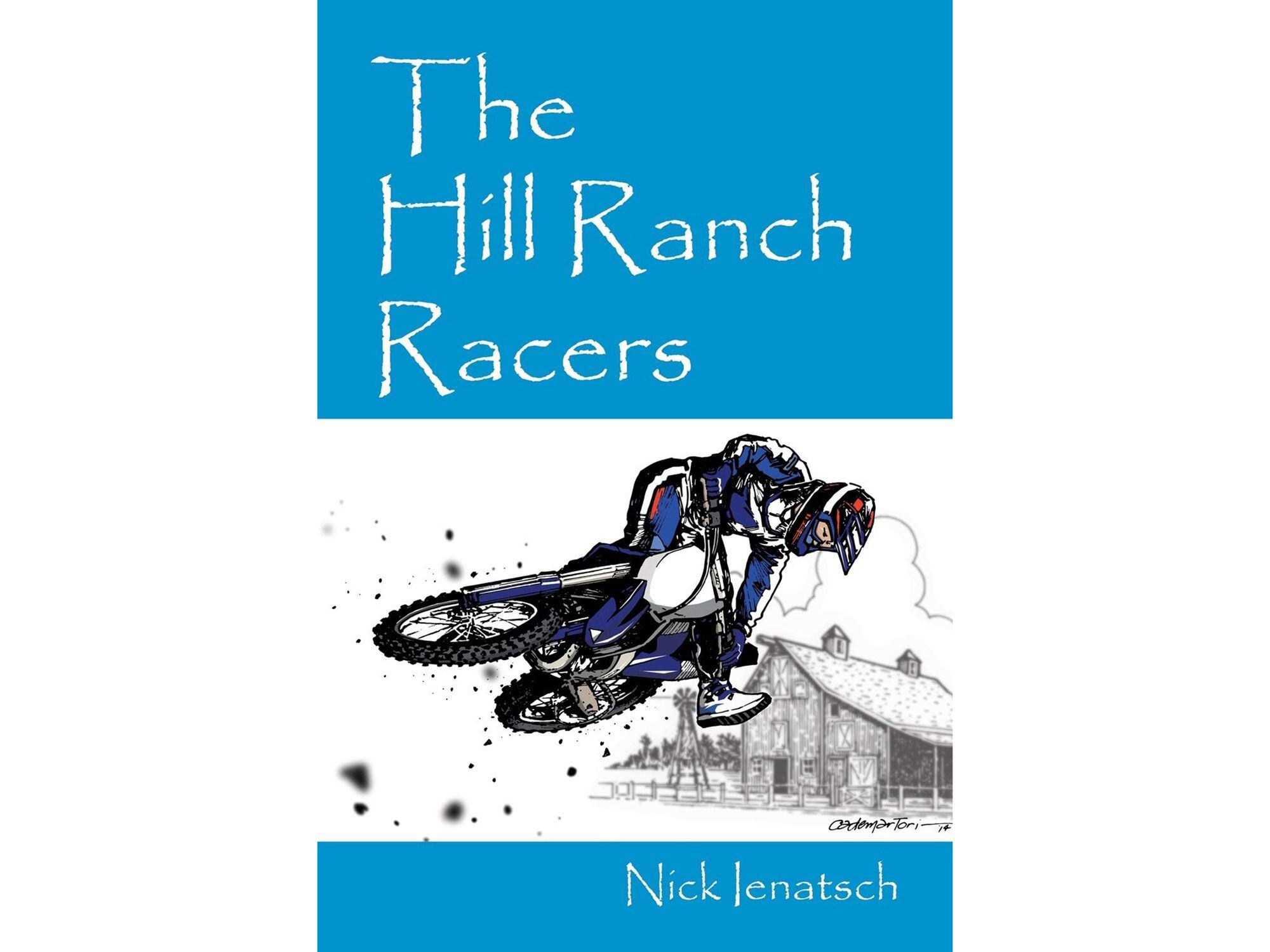
If you hunger for more of Nick’s fiction, and who wouldn’t, buy his novel <em>The Hill Ranch Racers</em> available on Amazon. (Amazon/)More next Tuesday!
-
 1
1
-
-
-
Hello JSeed,
Welcome to The Motorbike Forum. Please feel free to browse around and get to know the others. If you have any questions please don't hesitate to ask.
Why not tell us a bit about yourself too.

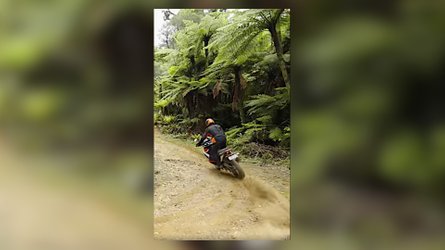
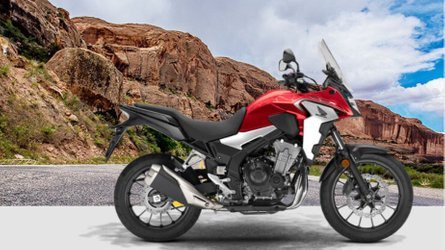
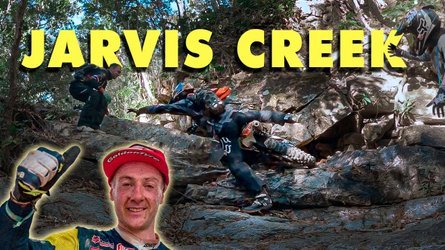
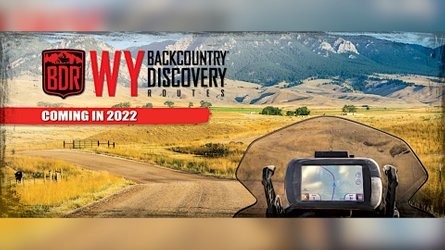
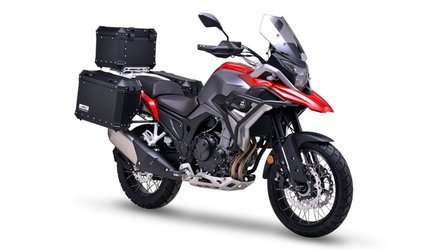

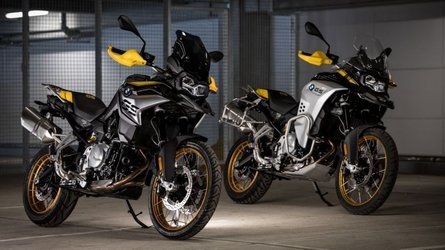
Meet The Suspiciously Familiar Dahaidao 500 GS-ADV
in Motorbike news
Posted
Now, where have we seen this before?
View the full article